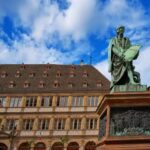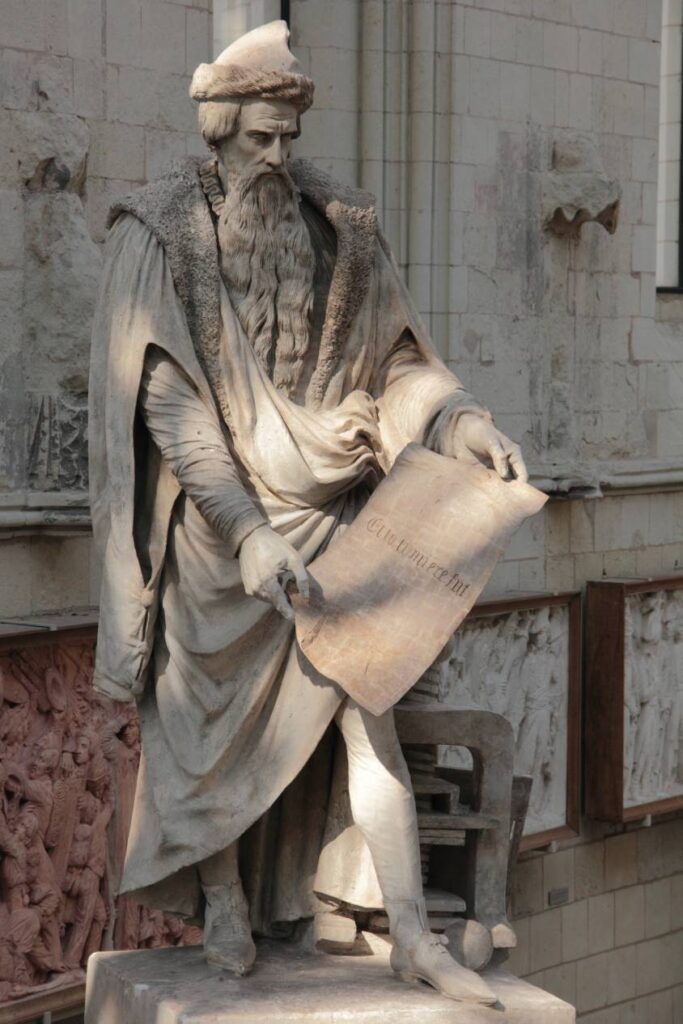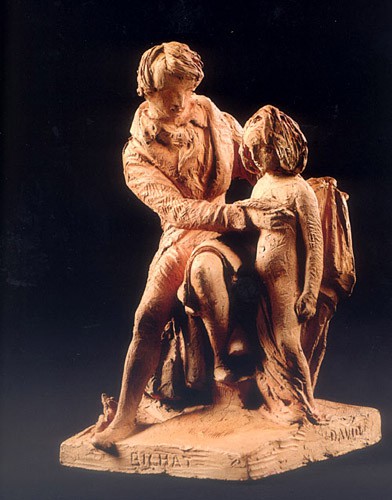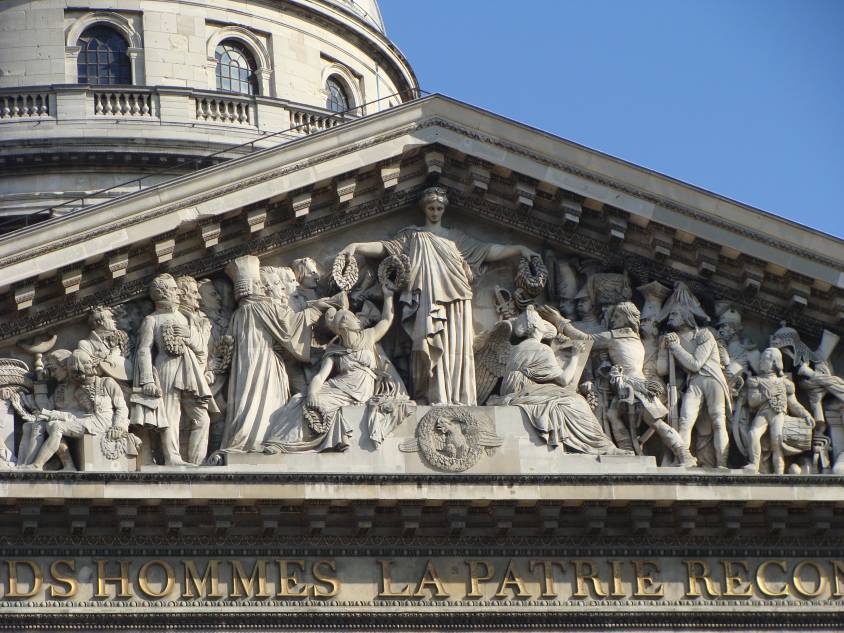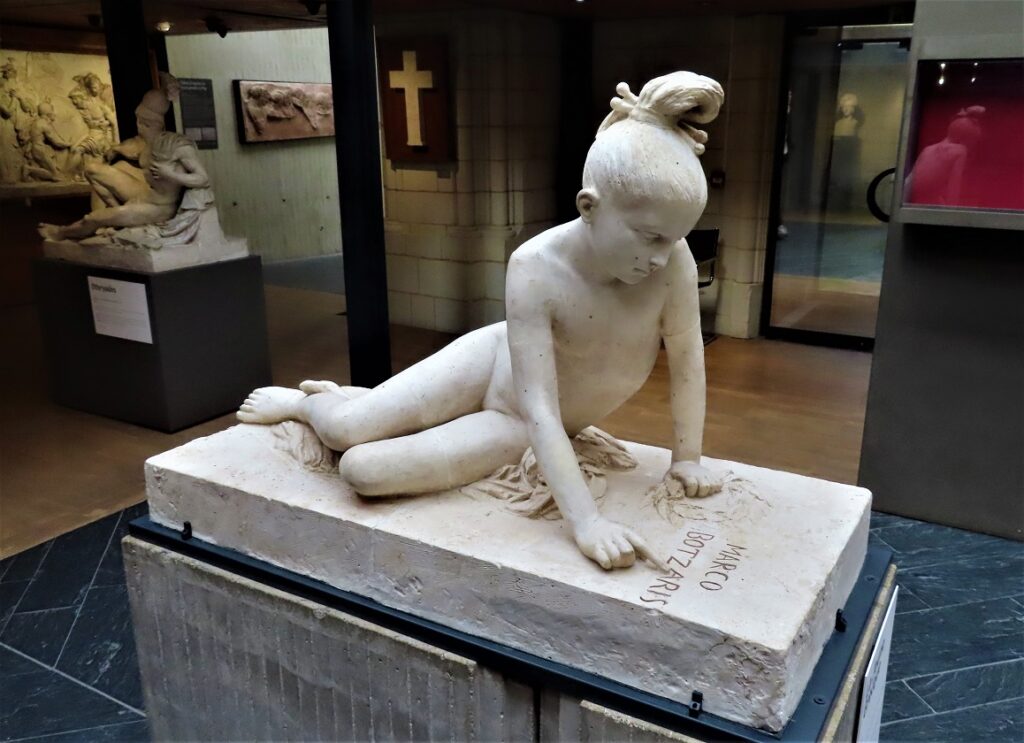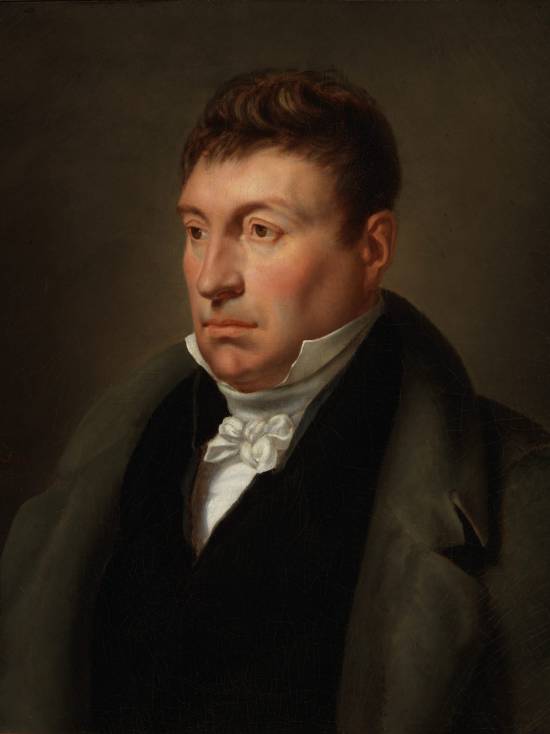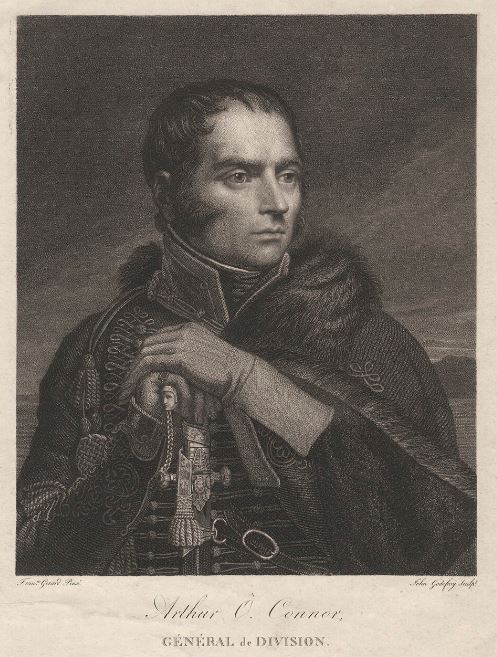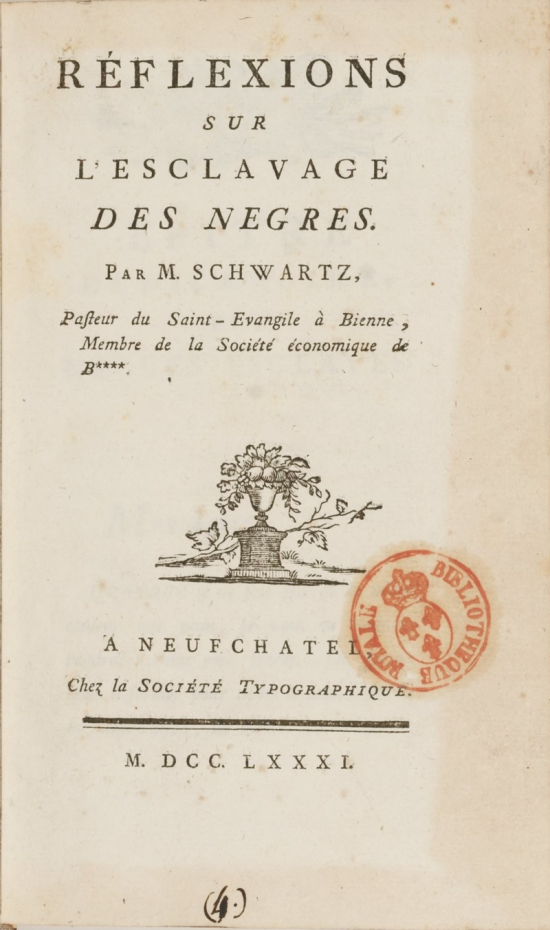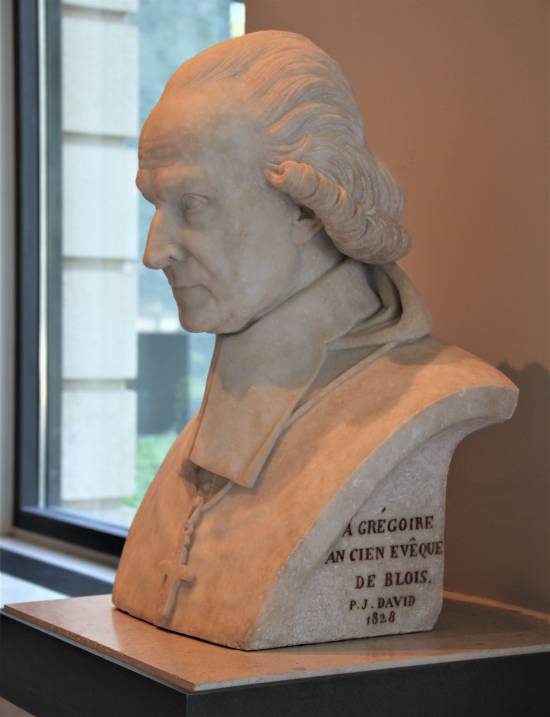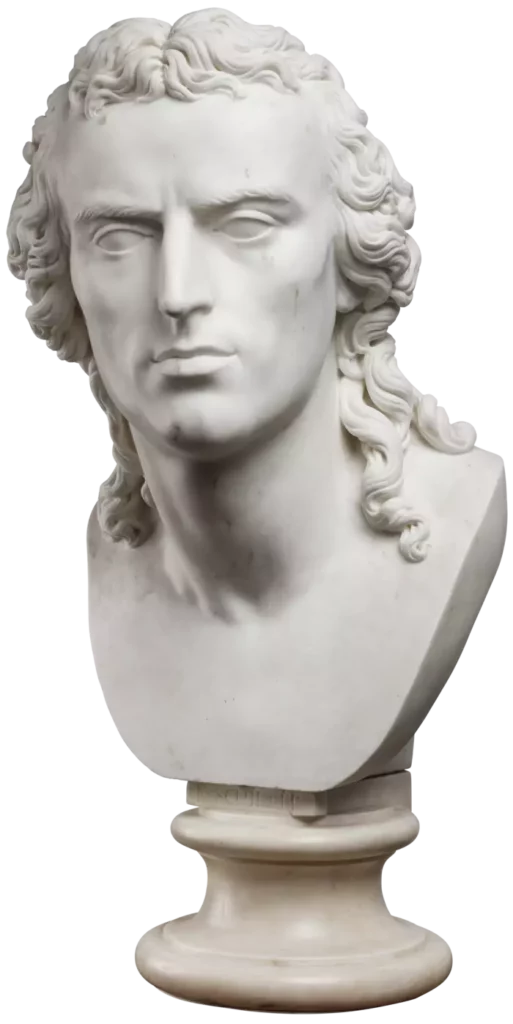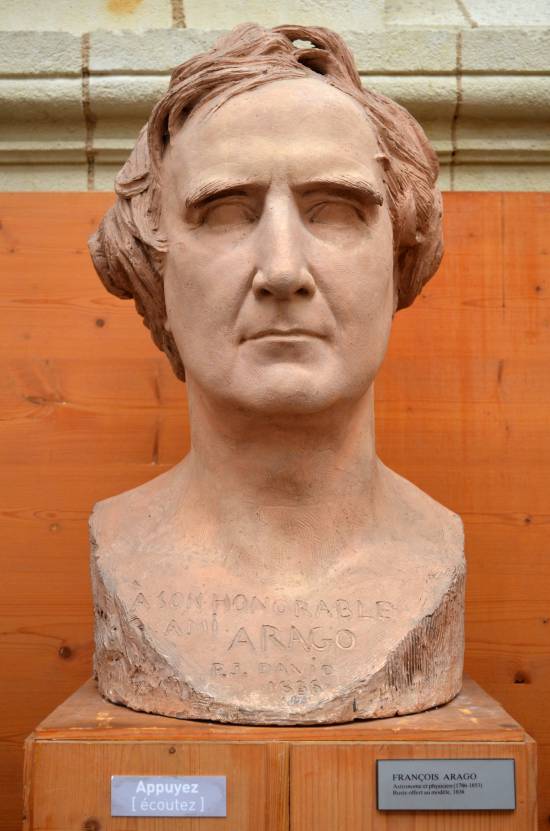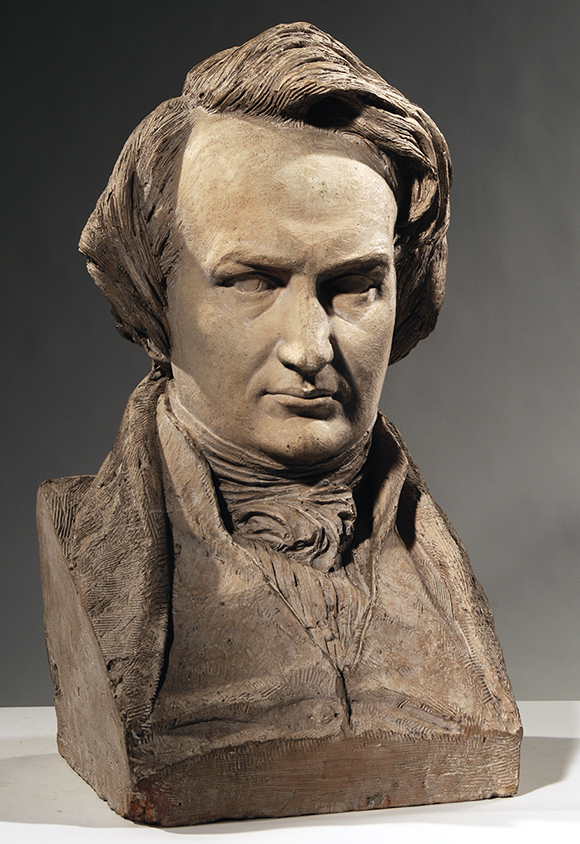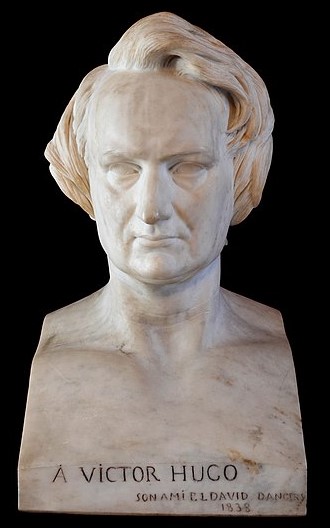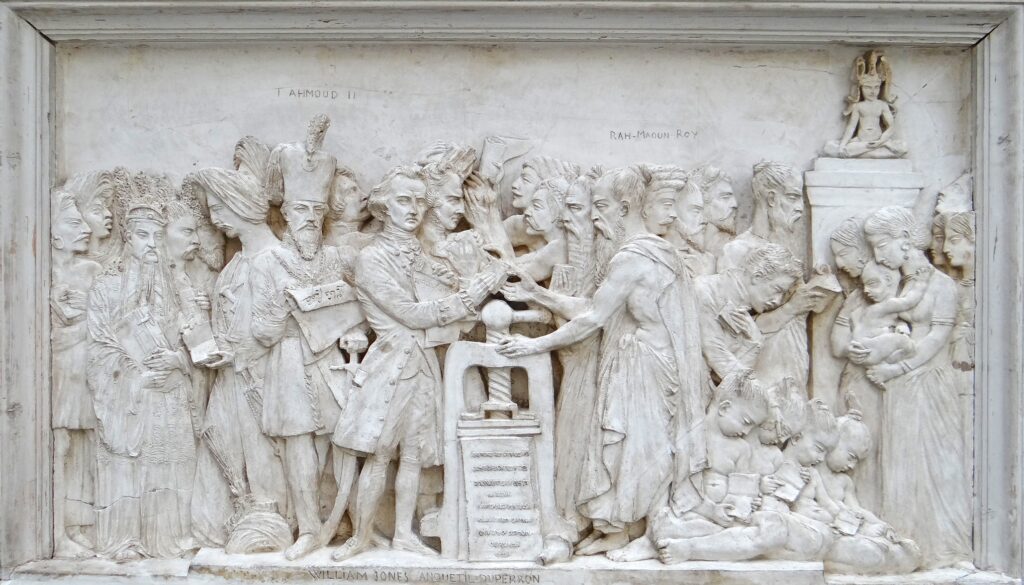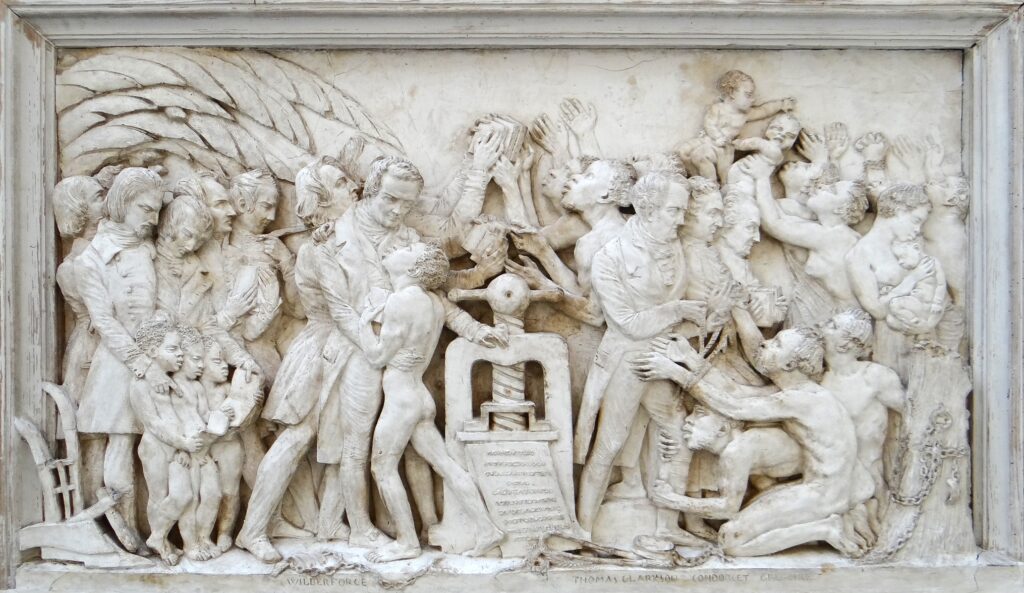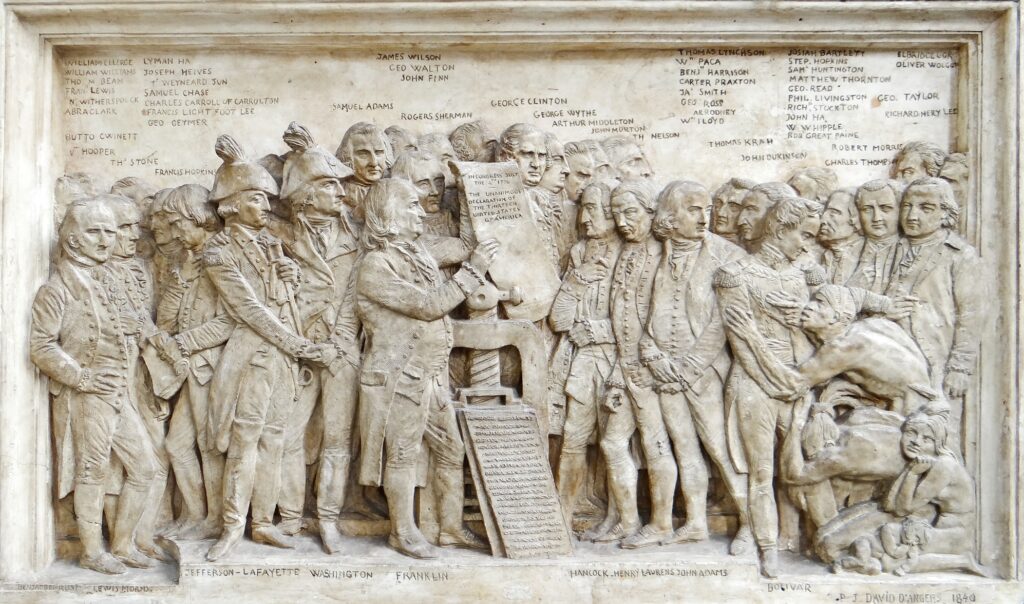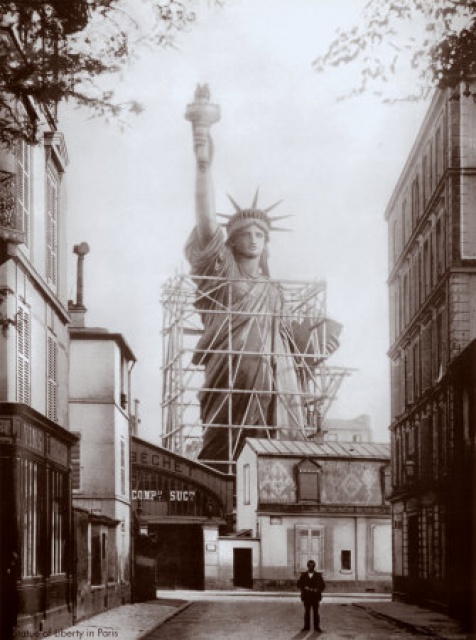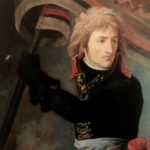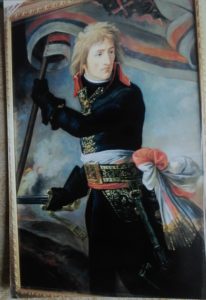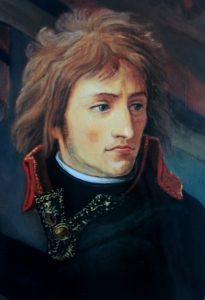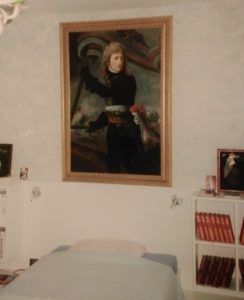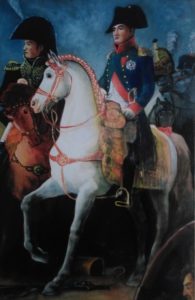Étiquette : Bonaparte
Enseignement mutuel : curiosité historique ou piste d’avenir ?
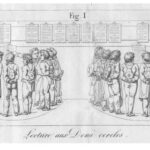
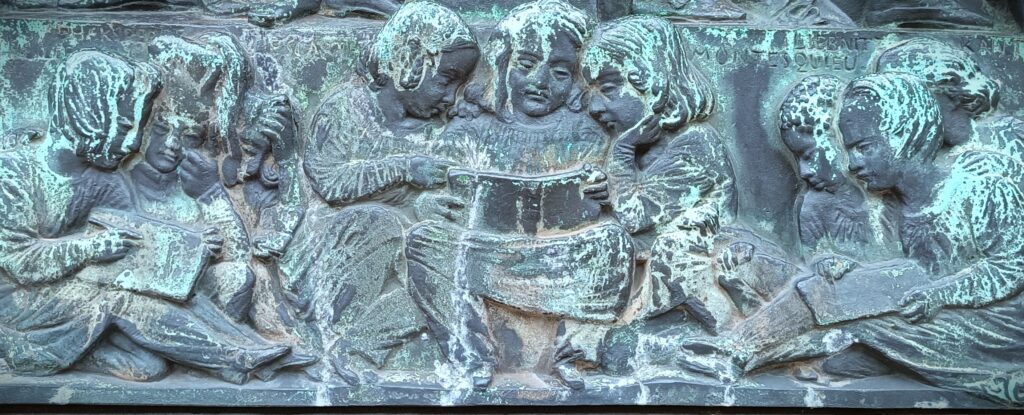
Par Karel Vereycken, Paris, France
- Introduction
- Apprendre et enseigner, une même joie
- Précédents
A. En Inde
B. En France - Les brigades de Gaspard Monge
- Andrew Bell
- Joseph Lancaster
- Enseignement mutuel, comment ça marche ?
A. Le local
B. Maîtres et moniteurs
C. Fonctionnement
D. Progresser selon sa connaissance
E. Les outils
F. Commandement - Bellistes contre lancastériens
- Lorsque ça intéresse les Français
- Lazare Carnot à la manœuvre
- Enseignement mutuel et chant choral
- Le projet pilote de la rue Saint-Jean-de-Beauvais
- Jomard, Choron, Francœur et savoirs élémentaires
- Rayonnement national
- Critiques
- Dérive mécaniste ?
- Mort de l’enseignement mutuel en France
- Conclusion
- Quelques ouvrages et textes consultés, en accès libre
« Répondez, mes amis : il doit vous être doux
D’avoir pour seuls mentors des enfants comme vous ;
Leur âge, leur humeur, leurs plaisirs sont les vôtres ;
Et ces vainqueurs d’un jour, demain vaincus par d’autres,
Sont, tour à tour parés de modestes rubans,
Vos égaux dans vos jeux, vos maîtres sur les bancs.
Muets, les yeux fixés sur vos heureux émules,
Vous n’êtes point distraits par la peur des férules ;
Jamais un fouet vengeur, effrayant vos esprits,
Ne vous fait oublier ce qu’ils vous ont appris ;
J’écoute mal un sot qui veut que je le craigne,
Et je sais beaucoup mieux ce qu’un ami m’enseigne. »
Victor Hugo, Discours sur les avantages de l’Enseignement mutuel, 1817.
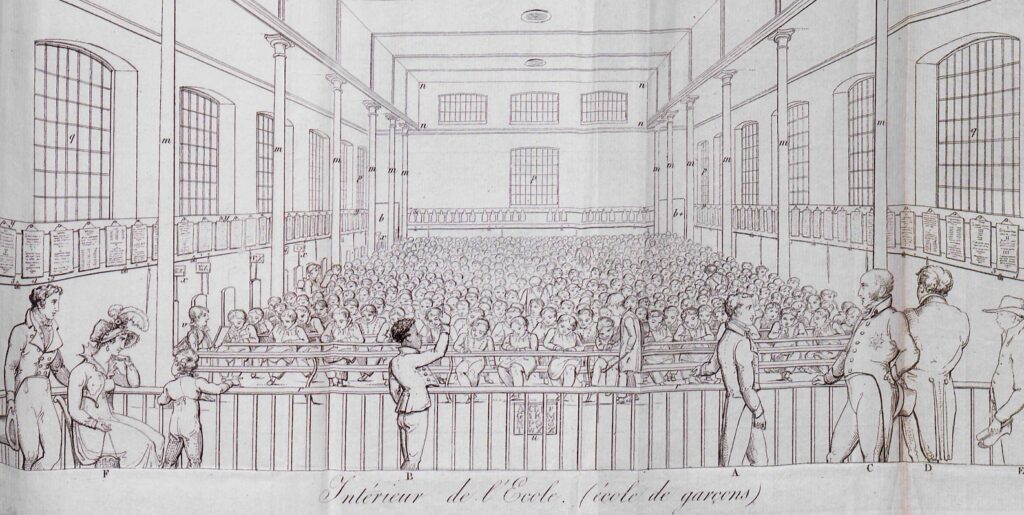
1. Introduction
Enseigner la lecture et l’écriture à 1000 enfants présents dans une même salle, sans instituteur, sans livres scolaires, sans papier et sans encre, c’est clairement impossible. Et pourtant, cela a été imaginé et mis en pratique avec grand succès ! Chut ! Il ne faut pas en parler, car cela pourrait donner des idées à certains, et pas seulement dans les pays émergents !
Qu’un tel défi puisse être relevé ne pouvait qu’inquiéter l’oligarchie et ses serviteurs. Depuis la nuit des temps ils formatent une « élite » (les grands prêtres de la connaissance, les « experts » et autres sachants) se reproduisant en vase clos au sommet, tout en veillant à ce que la grande masse du peuple d’en bas s’instruise juste assez pour pouvoir livrer des colis, payer ses impôts, se plier aux règles définies par le sommet, et surtout, ne fasse pas (trop) désordre.
Pourtant, comme l’avait compris bien avant nous Hippolyte Carnot, ministre de l’Instruction publique de la IIe République, sans éducation républicaine, c’est-à-dire sans une véritable formation de citoyen dès la maternelle, le suffrage universel devient, assez souvent, une farce tragique capable d’engendrer des monstres.
Au début du XIXe siècle, « l’enseignement mutuel » (parfois appelé système « monitorial » anglais, « système de Madras » ou « système de Lancaster »), se répand comme un feu de brousse en Europe puis à travers le monde.
Si le maître s’adresse à un seul élève, c’est le mode individuel (cas du précepteur) ; s’il s’adresse à toute une classe, c’est le mode simultané ; s’il charge des enfants d’instruire les autres, c’est le mode mutuel. L’alliance des procédés simultané et mutuel est appelée mode mixte.
L’enseignement mutuel est rapidement victime de querelles de personnes et d’enjeux idéologiques, politiques et religieux. Il est vécu comme une agression par les congrégations religieuses qui pratiquent, elles, « l’enseignement simultané », édicté dès 1684 par Jean-Baptiste de la Salle pour les « Frères des écoles chrétiennes » : classes par âge, division par niveau, place fixe et individuelle, discipline stricte, travail répétitif et simultané surveillé par un maître inflexible.
Avec la constitution de petits groupes où les élèves enseignent les uns aux autres, se déplacent dans la salle de classe, l’enseignement mutuel a immédiatement fait naître, assez bêtement, la crainte d’un monde cul par-dessus tête, sortant d’un tableau de Jérôme Bosch. Dans quel monde sommes-nous si l’élève enseigne au maître, l’enfant au parent, le fidèle au prêtre, le citoyen au gouvernement ! Sans chef, que faire, chef ?
Estimant qu’un tel enseignement « affaiblit l’autorité » aussi bien des maîtres que des autorités politiques et religieuses, en 1824, le pape Léon XII (à ne pas confondre avec le bienveillant Léon XIII), le « pape de la Sainte-Alliance », farouche partisan de l’ordre et soupçonnant un vaste complot protestant contre le Vatican, l’interdit.
En France, où dans les années qui suivent la Révolution de 1830, près de 2 000 écoles mutuelles existent, principalement dans les villes, en concurrence avec les écoles confessionnelles, François Guizot, ministre de Louis-Philippe, les fera disparaître.
2. Apprendre et enseigner, une même joie
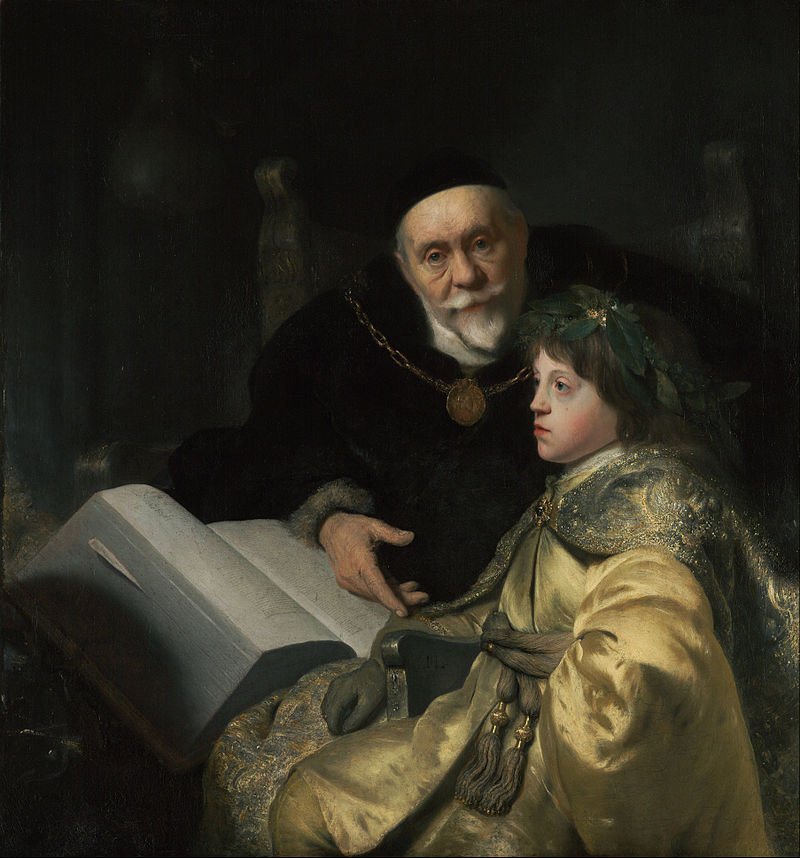
Le tutorat connaît aujourd’hui un regain d’intérêt dans le cadre des apprentissages scolaires et formations professionnelles. Il s’agit d’un processus « d’assistance de sujets plus expérimentés à l’égard de sujets moins expérimentés, susceptible d’enrichir les acquisitions de ces derniers ». C’est ainsi que le tutorat entre enfants, en particulier entre enfants d‘âges différents, est encouragé dès l’école maternelle, jusqu’à l’université avec l’institutionnalisation au niveau du premier cycle du tutorat méthodologique, en passant par l’école élémentaire et le secondaire qui ont vu se développer depuis les années 1980, tant en France qu’à l’étranger, de nombreuses expériences tutorales.
Or, le tutorat n’est que le pâle héritier de l’enseignement mutuel développé en Angleterre puis en France au XIXe siècle.
Il existe une vérité immuable : l’avenir de l’humanité dépend d’une faculté exclusivement humaine : la découverte de principes physiques universels nouveaux, parfois dépassant de loin les bornes de notre appareil sensoriel, permettant à l’Homme d’accroître sa capacité de transformation de l’univers afin d’améliorer de façon qualitative son sort et celui de son environnement. Or, une découverte n’est jamais le fruit d’une somme ou d’une moyenne d’opinions multiples mais bien celui d’un acte unique parfaitement souverain.

Cependant, sans la socialisation de cette découverte, elle ne servira à rien. L’histoire de l’humanité est donc, par sa propre nature, pourrait-on dire, l’histoire d’un « enseignement mutuel ».
Le plus grand plaisir de celui qui vient d’effectuer une découverte, et cela est naturel chez les enfants, n’est-il pas de partager, non seulement ce qu’il ou elle vient de découvrir, mais la joie et la beauté que représente toute percée scientifique ? Et lorsque ceux qui découvrent, enseignent, le plaisir est au rendez-vous. Laissons-donc à nos enseignants professionnels le temps de faire des découvertes, leur enseignement y gagnera en qualité !
3. Précédents
A. En Inde
En 1623, l’explorateur italien Pietro Della Valle (1586-1652), après un voyage en « Indoustan » (Inde), dans une lettre expédiée d’Ikkeri (ville du sud-ouest de l’Inde), rapporte avoir vu :
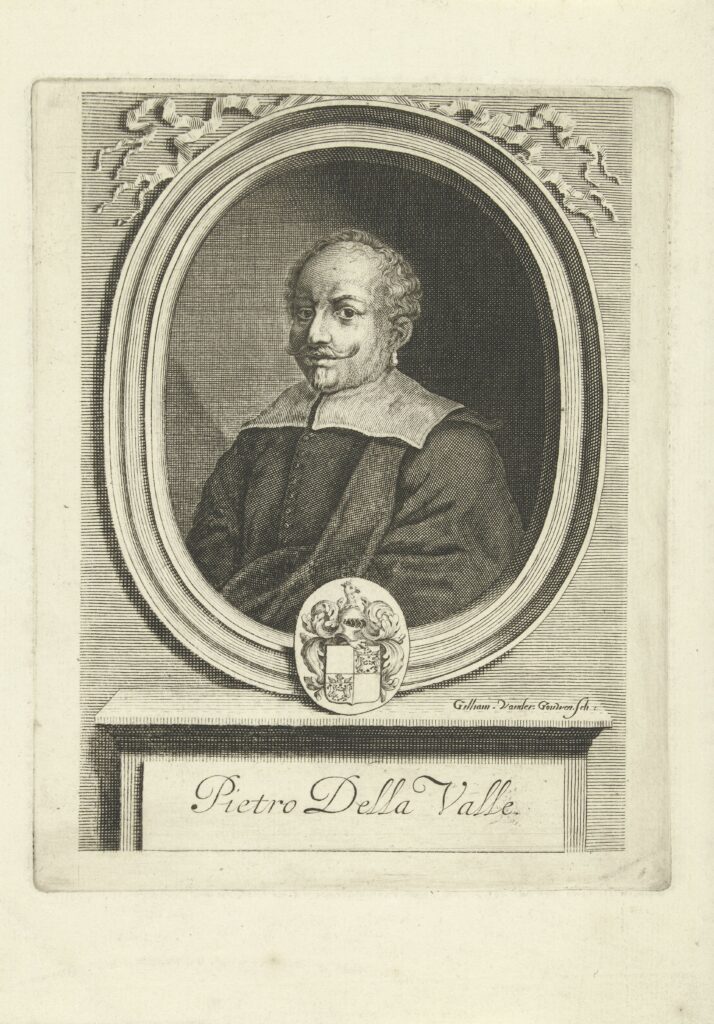
« certains jeunes enfants qui y apprenaient à lire d’une façon extraordinaire (…) Ils étaient quatre et avaient pris du maître une même leçon ; afin de l’inculquer parfaitement dans leur mémoire, de répéter les précédentes qui leur avaient été prescrites, de peur de les oublier, l’un d’eux chantait d’un certain ton musical une ligne de la leçon, comme par exemple deux et deux font quatre. En effet, on apprend facilement une chanson. Pendant qu’il chantait cette partie de leçon pour l’apprendre mieux, il l’écrivait en même temps, non pas avec une plume, ni sur du papier. Mais pour l’épargner et n’en pas gâter inutilement, ils en marquaient les caractères avec le doigt sur le même plancher où ils étaient assis en rond, qu’ils avaient couvert pour ce sujet d’un sable très délié. Après que le premier de ces enfants avait écrit de la sorte en chantant, les autres chantaient et écrivaient la même chose tous ensemble (…) Sur ce que je leur demandais qui (…) les corrigeait lorsqu’ils manquaient, vu qu’ils étaient tous écoliers, ils me répondirent fort raisonnablement, qu’il était impossible qu’une seule difficulté les arrêtât tous quatre en même temps, sans pouvoir la surmonter et que pour le sujet ils s’exerçaient toujours ensemble afin que si l’un manquait les autres fussent ses maîtres. »
Dans ce texte apparaissent déjà les grands principes de l’enseignement mutuel, notamment l’apprentissage simultané de la lecture et de l’écriture, l’utilisation du sable pour les exercices d’écriture afin de ne pas gaspiller le papier qui est rare et fort cher, un cours en collectif donné par un maître, puis un travail en sous-groupes dans lequel les élèves apprennent à s’autoréguler, et enfin, une intégration du savoir qui, grâce à l’utilisation du chant, va faciliter la mémorisation.
B. En France
A Lyon, le prêtre lyonnais Charles Démia figure comme l’un des précurseurs de l’enseignement mutuel qu’il a théorisé dès 1688, et qu’il mettait en pratique dans les « petites écoles » pour enfants pauvres qu’il a fondées. D’après le Nouveau dictionnaire de pédagogie et de l’instruction primaire,

« Démia introduisit dans les classes ce qu’on appela plus tard l’enseignement mutuel : il recommande de choisir, parmi les écoliers les plus capables et les plus studieux, un certain nombre d’officiers, dont les uns, sous le nom d’intendants et de décurions, seront chargés de la surveillance, tandis que les autres devront faire répéter les leçons du maître, reprendre les écoliers quand ils se trompent, guider la main hésitante des ‘jeunes écrivains’, etc. Pour rendre possible la simultanéité de l’enseignement, l’auteur des règlements divise l’école en huit classes, dont le maître devra s’occuper tour à tour ; chacune de ces classes peut se subdiviser en bandes. »
A Paris, dès 1747, l’enseignement mutuel est pratiqué avec un grand succès dans une école de plus de 300 élèves, établie par M. Herbault à l’hospice de la Pitié, en faveur des enfants des pauvres. L’expérience, hélas, ne survécut pas à son fondateur.
En 1772, la charité ingénieuse du chevalier Paulet conçut et exécuta le projet d’appliquer une semblable méthode à l’éducation d’un grand nombre d’enfants, que la mort de leurs parents laissaient sans appui dans la société.
4. Les brigades de Gaspard Monge
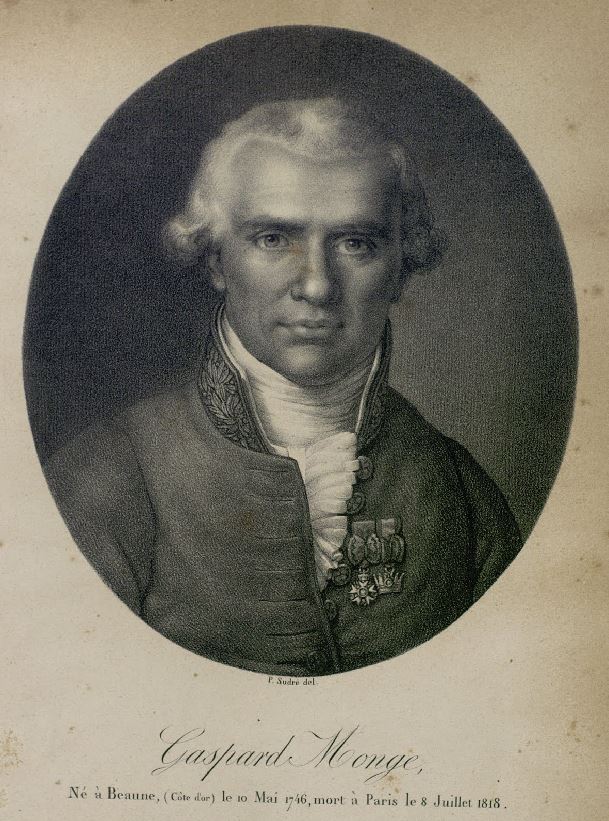
Enfin, comme le raconte, dans sa biographie de Gaspard Monge, son élève le plus brillant, l’astronome François Arago (1786-1853), lui-même un ami proche d’Alexandre de Humboldt, c’est à l’École polytechnique que Monge va peaufiner son propre système d’enseignement mutuel et de tutorat.
Jugeant qu’il était inacceptable de devoir attendre trois ans pour voir sortir les premiers ingénieurs de l’École polytechnique, Monge décida, afin d’accélérer la formation des élèves, d’organiser des « cours révolutionnaires », une formation accélérée pendant trois mois. Pour cela, il perfectionna le concept de « chefs de brigades », une technique qu’il avait déjà pu tester avec succès à l’école du Génie de Mézières.
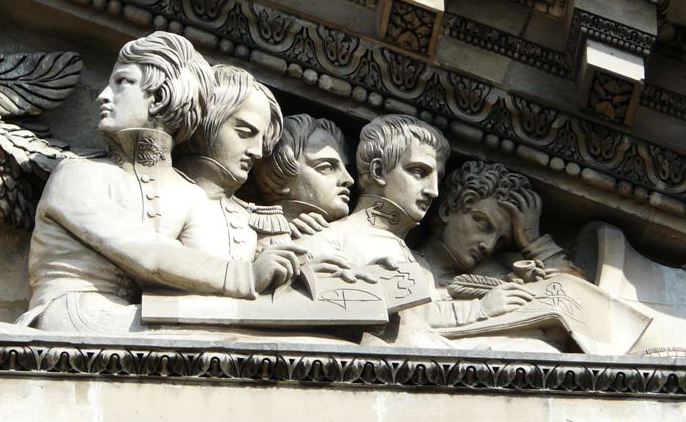
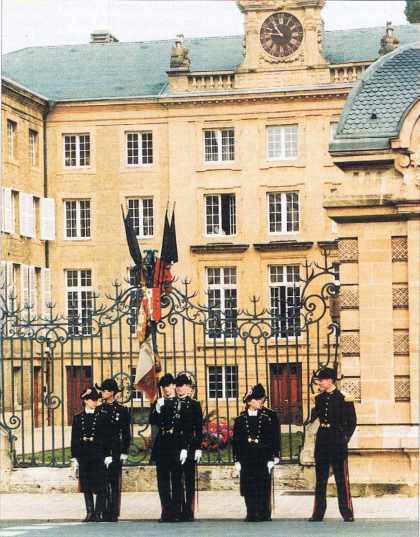
François Arago :
« Les chefs de brigade, toujours réunis à de petits groupes d’élèves dans des salles séparées, devaient avoir des fonctions d’une importance extrême, celles d’aplanir les difficultés à l’instant même où elles surgiraient. Jamais combinaison plus habile n’avait été imaginée pour ôter toute excuse à la médiocrité ou à la paresse.
« Cette création appartenait à Monge. A Mézières, où les élèves du génie étaient partagés en deux groupes de dix, à Mézières, où, en réalité, notre confrère fit quelque temps, pour les deux divisions, les fonctions de chef de brigade permanent, la présence, dans les salles, d’une personne toujours en mesure de lever les objections avait donné de trop heureux résultats pour qu’en rédigeant les développements joints au rapport de Fourcroy, cet ancien répétiteur n’essayât pas de doter la nouvelle école des mêmes avantages.
« Monge fit plus ; il voulut qu’à la suite des leçons révolutionnaires, qu’à l’ouverture des cours des trois degrés, les 23 sections de 16 élèves chacune, dont l’ensemble des trois divisions devait être composé, eussent leur chef de brigade, comme dans les temps ordinaires ; il voulut, en un mot que l’École, à son début, marchât comme si elle avait déjà trois ans d’existence.
« Voici comment notre confrère atteignit ce but en apparence inaccessible. Il fut décidé que 25 élèves, choisis par voie de concours parmi les 50 candidats que les examinateurs d’admission avaient le mieux notés, deviendraient les chefs de brigade de trois divisions de l’école, après avoir reçu à part une instruction spéciale. Le matin, les 50 jeunes suivaient, comme tous leurs camarades, les cours révolutionnaires ; le soir, on les réunissait à l’hôtel Pommeuse, près du Palais-Bourbon, et divers professeurs les préparaient aux fonctions qui leur étaient destinées. Monge présidait à cette initiation scientifique avec une bonté, une ardeur, un zèle infinis. Le souvenir de ses leçons est resté en traits ineffaçables dans la mémoire de tous ceux qui en profitèrent. »
Arago cite alors le témoignage d’Edme Augustin Sylvain Brissot (1786-1819), fils du célèbre girondin et abolitionniste, un des 50 élèves :
« C’est là, que nous commençâmes à connaître Monge, cet homme si bon attaché à la jeunesse, si dévoué à la propagation des sciences. Presque toujours au milieu de nous, il faisait succéder aux leçons de géométrie, d’analyse, de physique, des entretiens particuliers où nous trouvions plus à gagner encore. Il devint l’ami de chacun des élèves de l’Ecole provisoire ; il s’associait aux efforts qu’il provoquait sans cesse, et applaudissait, avec toute la vivacité de son caractère, aux succès de nos jeunes intelligences ».
Si une forme d’enseignement mutuel y est pleinement pratiquée, le dévouement total d’un maître aussi fervent que Monge, vient compléter ce qui ne serait autrement qu’un « système ».
5. Andrew Bell
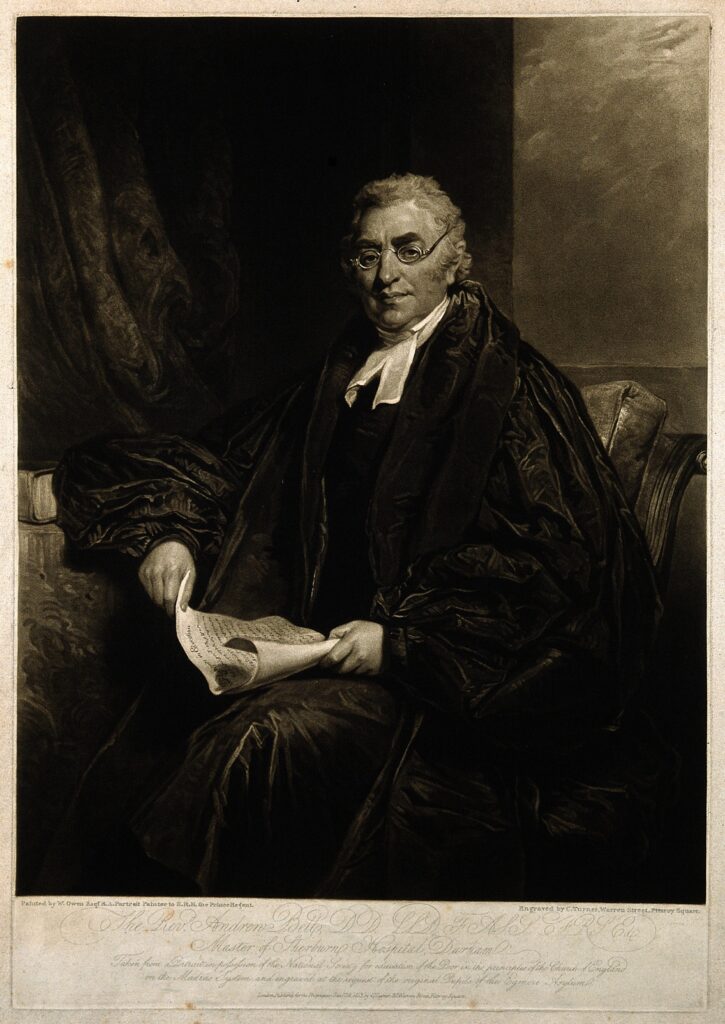
C’est un Écossais, le pasteur anglican Andrew Bell (1753-1832), qui revendique la paternité de l’enseignement mutuel qu’il a pratiqué et théorisé en Inde, à la tête de l’Asile militaire pour orphelins d’Egmore (Inde orientale). Cette institution, créée en 1789, est chargée d’éduquer et d’instruire les orphelins et les fils indigents des officiers et des soldats européens de l’armée de Madras.
Après sept ans sur place, Bell rentre à Londres et en 1797, il rédige un rapport destiné à la Compagnie des Indes (son employeur à Madras) sur les incroyables avantages de son invention.
Le médecin, naturaliste et inventeur russe Iosif Kristianovich (Joseph Christian) Hamel (1788-1862), membre de l’Académie des Sciences, est chargé par le Tsar de Russie Alexandre Ier, de faire un rapport complet sur ce nouveau type d’enseignement dont toute l’Europe discutait alors.
Il relate, dans Der Gegenseitige Unterricht (1818), ce qu’écrivait Bell dans un de ses écrits :
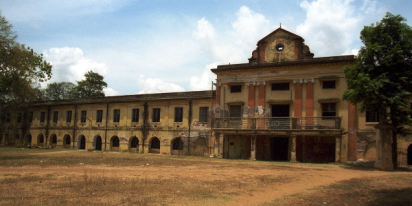
« Il arriva dans ce temps, qu’en faisant un matin ma promenade ordinaire, je passai devant une école de jeunes enfants Malabares, et je les vis occupés à écrire sur la terre. L’idée me vint aussitôt qu’il y aurait peut-être moyen d’apprendre aux enfants de mon école, à connaître les lettres de l’alphabet, en leur faisant tracer sur le sable. Je rentrai sur-le-champ chez moi, et je donnai ordre au maître de la dernière classe, de faire exécuter ce que je venais d’arranger dans mon chemin. Heureusement, l’ordre fût très mal accueilli ; car si le maître s’y fut conformé à ma satisfaction, il est possible que tout développement ultérieur eût été arrêté, et par là, le principe même de l’enseignement mutuel… »
Accueilli avec froideur en Angleterre, l’enseignement mutuel finit par séduire Samuel Nichols, un des dirigeants de l’école de St-Botolph’s Aldgate, la plus vieille paroisse protestante anglicane de Londres. La mise en œuvre des préceptes de Bell est réalisée avec grand succès et sa méthode est reprise par le docteur Briggs lorsqu’il ouvre une école industrielle à Liverpool.
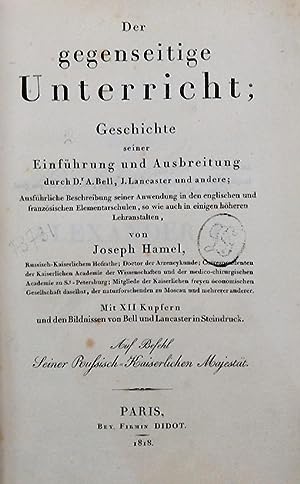
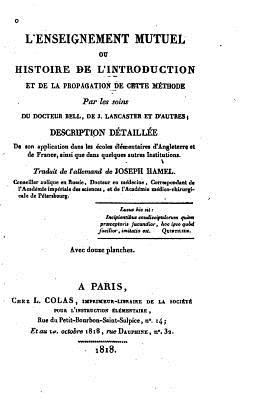

6. Joseph Lancaster

En Angleterre, c’est Joseph Lancaster (1778-1838), un instituteur londonien âgé de vingt ans, qui s’empare de la nouvelle manière d’enseigner, la perfectionne et la généralise à grande échelle.
En 1798, il ouvre une école élémentaire pour les enfants pauvres à Borough Road, un des faubourgs les plus miséreux de Londres. L’enseignement n’y est pas encore totalement gratuit mais 40 % moins cher que dans les autres écoles de la capitale.
Faute d’argent, Lancaster fait tout pour faire baisser encore les coûts de ce qui devient un véritable « système » : emploi de sable et d’ardoises plutôt que d’encre et de papier (Erasme de Rotterdam rapporte en 1528 qu’en son temps il y avait des gens qui écrivaient avec une sorte de poinçon sur des tables recouvertes d’une fine poussière) ; tableaux reproduisant les pages d’ouvrages scolaires suspendus aux murs pour éviter l’achat de livres ; maîtres auxiliaires remplacés par des élèves pour éviter de payer des salaires ; augmentation du nombre d’élèves par classe.
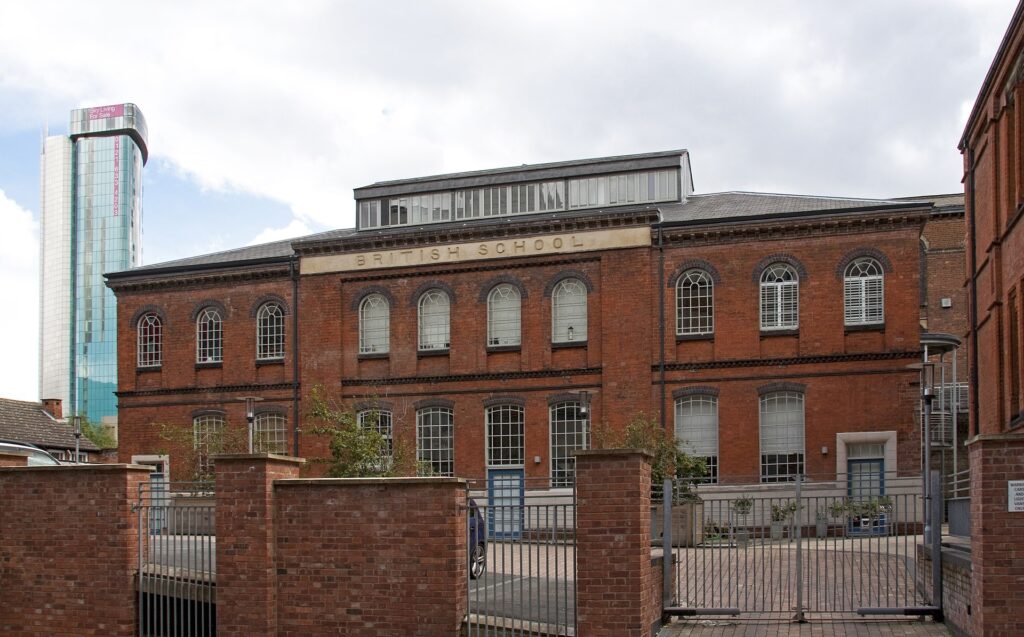
En 1804, son école compte 700 élèves, et douze mois plus tard, un millier. Lancaster, en s’endettant de plus en plus, ouvre une école pour 200 filles. Pour échapper à ses créanciers, il quitte Londres en 1806 et lors de son retour il est enprisonné pour dette. Deux de ses amis, le dentiste Joseph Foxe et le fabricant de chapeaux de paille William Corston, remboursent sa dette et fondent avec lui « La société pour la promotion du système lancastérien pour l’éducation des pauvres ». D’autres quakers viendront alors les soutenir, notamment l’abolitionniste William Wilberforce (1759-1833) que David d’Angers, sur le socle de son célèbre monument commémorant Gutenberg à Strasbourg, fait figurer aux côtés de Condorcet et de l’abbé Grégoire.
A partir de là, comme le relate Joseph Hamel dans son rapport de 1818, la nouvelle approche s’est répandue aux quatre coins du monde : Angleterre, Écosse, Irlande, France, Prusse, Russie, Italie, Espagne, Danemark, Suède, Pologne et Suisse, sans oublier le Sénégal et plusieurs pays d’Amérique du Sud comme le Brésil et l’Argentine et, bien sûr, les États-Unis d’Amérique. L’enseignement mutuel a été adopté comme pédagogie officielle à New York (1805), Albany (1810), Georgetown (1811), Washington D.C. (1812), Philadelphie (1817), Boston (1824) et Baltimore (1829), et la législature de Pennsylvanie a envisagé de l’adopter à l’échelle de l’État.
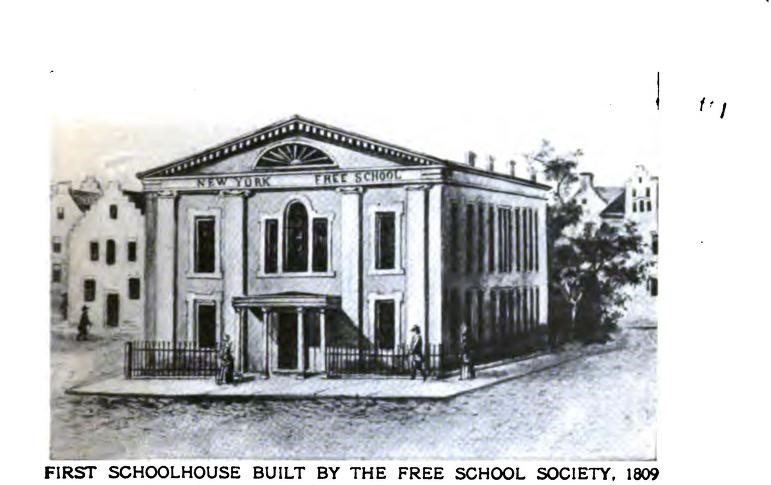
7. Enseignement mutuel, comment ça marche ?
Le principe fondamental de « l’enseignement mutuel », particulièrement pertinent pour l’école primaire, consiste dans la réciprocité de l’instruction entre les écoliers, le plus capable servant de maître à celui qui l’est moins. Dès le début, tous avancent graduellement, quel que soit le nombre d’élèves. Bell et Lancaster, et leurs disciples français, posent en postulat la diversité des facultés, l’inégalité des progrès, des rythmes de compréhension et d’acquisition. Ils sont donc conduits à repartir les élèves en classes différentes suivant les disciplines et suivant le niveau de connaissances des enfants, l’âge n’intervenant aucunement dans cette classification. Les écoliers ainsi réunis prennent part aux mêmes exercices. Leur programme d’étude est identique dans son contenu et dans ses méthodes.
Si l’effectif d’une division est trop élevé dans une discipline, la lecture ou l’arithmétique, par exemple, on constitue des sous-groupes qui évoluent parallèlement, les méthodes et supports de l’enseignement restant identiques.
Comment se présente alors une école du nouveau système ?
A. La salle de classe
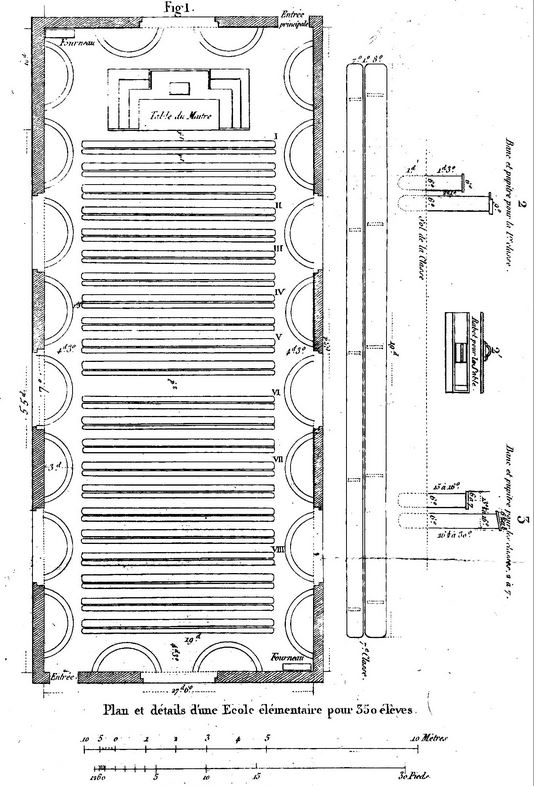
Quel que soit le nombre d’élèves — une centaine dans les bourgades françaises, mille dans l’école de Lancaster à Londres, deux cents dans les écoles parisiennes – ceux-ci sont groupés dans une salle unique, rectangulaire, sans cloisons. Jomard qui déploya dans les premières années de l’installation du mode d’enseignement mutuel une extraordinaire et féconde activité, a fixé les normes souhaitables pour des effectifs variant de 70 à 1 000 élèves. Il indique, par exemple, pour 350 élèves la nécessité d’une salle de 18 m de long sur 9 m de large. En Angleterre et dans les campagnes françaises, on utilise souvent une grange pour la nouvelle école. En France, les édifices religieux désaffectés depuis la période révolutionnaire sont nombreux et répondent parfaitement aux normes souhaitées. Ils accueilleront beaucoup d’écoles mutuelles.
B. Maîtres et « moniteurs »
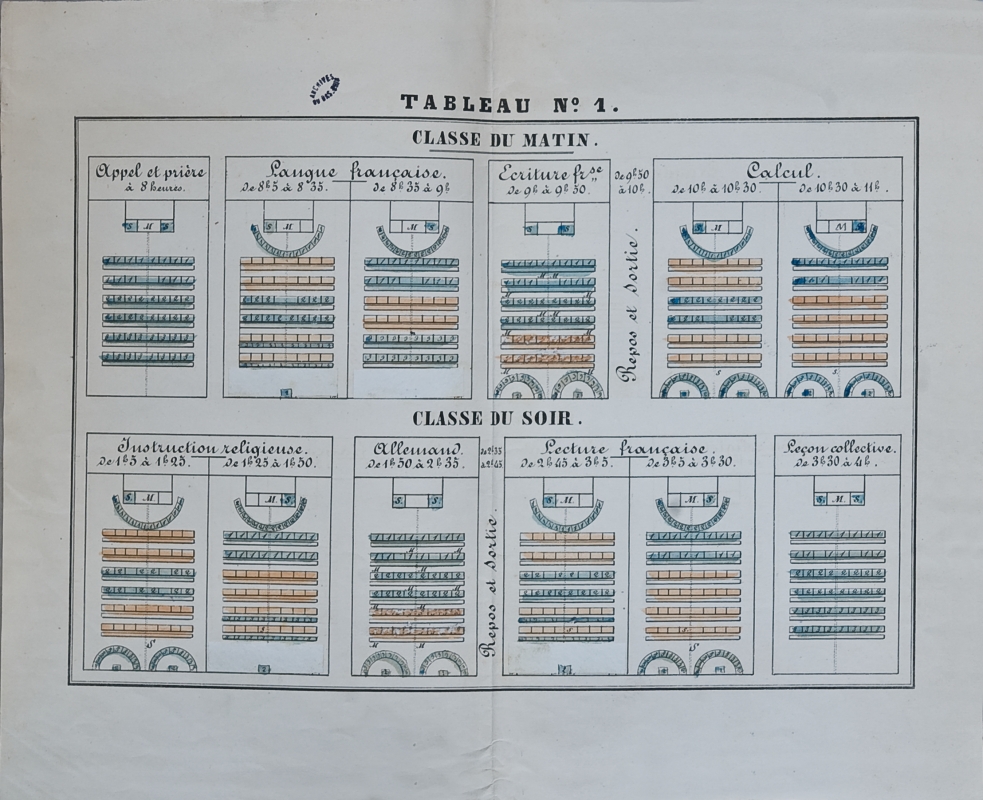
Le mode mutuel répartit la responsabilité de l’enseignement entre le « maître » et des élèves désignés comme « moniteurs » et considérés comme « la cheville ouvrière de la méthode ». Le moniteur (ou admoniteur) est un élève un peu plus grand et plus avancé dans la discipline. Il de doit point enseigner mais s’assurer que les élèves s’enseignent entre eux. Comme le rappelle Bally, dès 1819 :
« La base de l’enseignement mutuel repose sur l’instruction communiquée par les élèves les plus forts à ceux qui sont les plus faibles. Ce principe qui fait le mérite de cette méthode, a nécessité une organisation toute particulière pour créer une hiérarchie raisonnable, qui pût concourir de la manière la plus efficace, au succès de tous. »
Chaque jour, dans une « classe » réservée aux moniteurs, le maître transmet des connaissances et dispense à ses adjoints les conseils techniques pour la bonne application de la méthode. Au cours de la journée, il reste responsable de la 8e classe (celle de l’achèvement du cursus scolaire), et, à ce titre, se charge de la conduite de leurs exercices. Il procède aux examens périodiques, mensuels ou occasionnels, dans les classes et décide, éventuellement, des changements de classe. C’est lui, enfin, qui, au stade ultime, distribue punitions et récompenses.
C. Fonctionnement
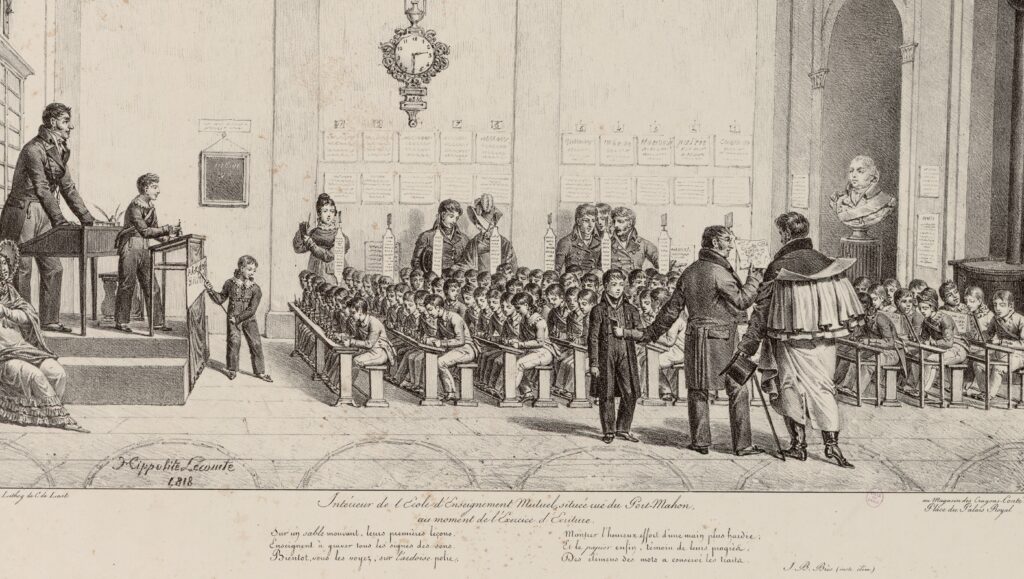
Ainsi, sur une estrade, le bureau du maître avec un large tiroir où sont rangés argent, billets de récompense, registres, modèles d’écriture, sifflets, cahiers des enfants.
Derrière le maître, à côté de l’horloge – instrument essentiel pour organiser la vie de l’enseignement – un tableau noir sur lequel sont écrits sentences et modèles d’écriture.
Au pied de l’estrade, des bancs sont fixés transversalement aux pupitres, de tailles différentes, au milieu de la pièce. Les premières tables, non inclinées, comportent du sable sur lesquelles les petits enfants tracent des signes, les autres tables reçoivent des ardoises ; on trouve également, sur les dernières d’entre elles, des encriers de plomb et du papier, des baguettes pour indiquer les mots ou les lettres à lire.
À l’extrémité de chaque table sont fixés les « tableaux de dictées » ainsi que des signaux télégraphiques indiquant les moments de la leçon, tel par exemple « COR » pour « correction » ou « EX » pour « examen du travail ». Des modèles de table demi-circulaire ont été ensuite proposés afin de faciliter le travail des moniteurs.
D. Progresser en fonction de sa connaissance
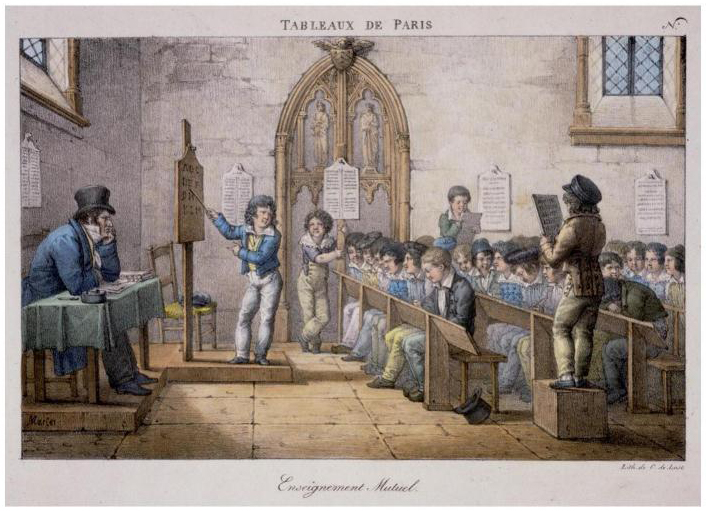
A l’origine, le programme de l’école mutuelle est limité aux trois disciplines fondamentales : lecture, écriture, arithmétique, et à l’enseignement de la religion. S’y ajouteront rapidement, la géographie, la grammaire, la rédaction, le chant et le dessin. Les groupements d’élèves, souples, mobiles, différenciés, sont fonction de la nature des matières d’étude et des activités pratiquées dans la discipline.
Chaque matière enseignée dans les écoles mutuelles repose sur un programme précis et codifié. Ce programme est découpé en 8 degrés hiérarchisés, qui doivent être parcourus successivement. Chaque degré s’appelle « classe » et c’est ainsi que l’on parle de 8 classes d’écriture ou d’arithmétique. Ce terme de « classe » est totalement exclusif de la notion d’architecture ou de local. Il ne s’entend que par rapport aux acquisitions et aux connaissances, la 1ere classe étant celle des débutants et la 8e celle de l’achèvement du cursus scolaire. Les rythmes d’apprentissages et les acquisitions varient suivant les élèves et suivant la discipline.
Ainsi, au bout de six mois de présence, tel élève pourra se trouver en 4e classe de lecture, en 5e classe d’écriture et en deuxième classe d’arithmétique. Comme nous l’avons dit, l’affectation dans la classe se décide en fonction du niveau de connaissance et non pas en fonction de l’âge.
Mais cette première répartition s’assortit, au sein de chaque classe et dans chaque discipline, de la constitution de groupes restreints établis selon les activités qui doivent y être pratiquées. En arithmétique, par exemple, des travaux écrits se font sur l’ardoise. Ils ont lieu, assis, sur les bancs réservés à cet usage, avec 16 à 18 élèves au maximum par banc, selon les normes établies par Jomard.
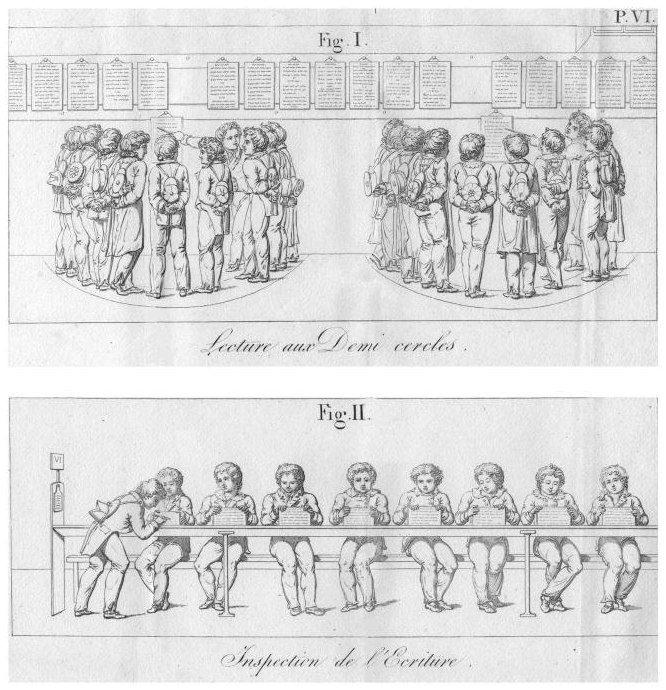
Les exercices oraux, en lecture, en arithmétique ou en dessin linéaire, à l’aide d’un tableau noir, se font debout, par groupes de 9 au maximum, les élèves se tenant côte à côte et formant un demi-cercle. De là, d’ailleurs, l’appellation donnée à ce genre d’activité : « travail au cercle ».
Ainsi, dans une école mutuelle ayant 36 élèves en 3e classe d’arithmétique, le travail aux bancs se fera en deux groupes avec deux moniteurs et les exercices au tableau noir avec 4 groupes et 4 moniteurs. Les effectifs des classes pourront donc varier suivant les écoles et tout au cours de l’année, la seule limitation étant imposée par l’étendue du local.

D. Les outils
Le souci d’économie est l’une des caractéristiques fondamentales du nouvel enseignement. Le mobilier reste donc très sommaire.
- Les bancs et pupitres sont faits de planches très ordinaires, fixées avec de gros clous. Les bancs n’ont pas de dossier : c’est un luxe superflu !
- L’estrade est nettement surélevée : 0,65 m environ. On accède par plusieurs marches au bureau du maître. Celui-ci règne sur la collectivité enfantine autant par sa position matérielle que par son ascendant personnel.
- La pendule est notée comme « indispensable », l’enseignement et les manœuvres étant strictement minutés.
- Les demi-cercles, encore appelés cercles de lecture, donnent aux écoles mutuelles un aspect typique et original. Ce sont, généralement, des cintres de fer, demi-circulaires, qui peuvent se lever ou s’abaisser à volonté. Parfois, la matérialisation est simplement portée sur le plancher : rainures, gros clous ou bandes tracées en forme d’arc.
- Les tableaux noirs ont été systématiquement utilisés pour le dessin linéaire et l’arithmétique. Ils mesurent 1 m de long sur 0,70 m de large et portent à leur partie supérieure un mètre mobile. On les place à l’intérieur de chaque demi-cercle.
- Les télégraphes. Lorsque le travail a lieu aux tables, l’écriture par exemple, on se sert de signaux permettant la liaison et la communication entre le moniteur général et les moniteurs particuliers : ce sont les télégraphes. Une planchette, fixée à l’extrémité supérieure d’un bâton rond de 1,70 m de haut, est installée à la première table de chaque classe, grâce à deux trous percés en haut et en bas du pupitre. Sur l’une des faces est inscrit le numéro de la classe (de 1 à 8) ; sur l’autre, la mention EX (examen) remplacée vers 1830 par COR (correction). Ces télégraphes sont transportables. On les déplace en cas d’augmentation ou de diminution du nombre d’élèves. Le maître et le moniteur général ont ainsi la composition exacte de chaque classe et le nombre de tables occupées par chacune d’elles. Dès qu’un exercice est terminé, le moniteur de classe fait tourner le télégraphe et présente vers le bureau la face EX. Tous les moniteurs font de même. Le moniteur général donne l’ordre de procéder à l’inspection et de faire des corrections éventuelles. Celles-ci achevées, on présente de nouveau le numéro de la classe. Et les exercices reprennent. Près des télégraphes se trouvent aussi, à l’occasion, les porte-tableaux.
- Les baguettes des moniteurs. Elles servent à indiquer sur les tables les lettres ou mots à lire, le détail des opérations à effectuer, les tracés à reproduire. Elles n’existent généralement dans les écoles rurales que grâce à la bonne volonté et à l’ingéniosité des moniteurs qui se les procurent dans les bois avoisinants.
- Le sable (pour l’écriture) puis les ardoises sont constamment utilisés dans toutes les disciplines. C’est là une innovation essentielle du mode mutuel, les autres écoles n’en faisant pas usage.
- Tableaux à la place de livres. La première raison est d’ordre pécuniaire, un seul tableau suffisant jusqu’à neuf élèves. Mais les motifs pédagogiques ne sont pas moindres. Le format permet une lecture aisée et un rangement facile. Le souci de présentation et de valorisation de certains caractères s’accompagne d’un souci de mise en page différent de ceux des manuels.
- Les livres sont réservés à la huitième classe, de même que les plumes, l’encre et le papier.
- Des registres, couramment en service, garantissent une saine gestion des établissements. L’un d’eux mérite une mention particulière : c’est « Le grand livre de l’école », avant tout un cahier- matricule. On y inscrit le nom, le prénom et l’âge de l’enfant, la profession et l’adresse des parents. Le maître y porte la date précise de l’entrée et de la sortie de chaque enfant, dans chaque classe, y compris pour les cours de musique et le dessin linéaire.
E. Le commandement
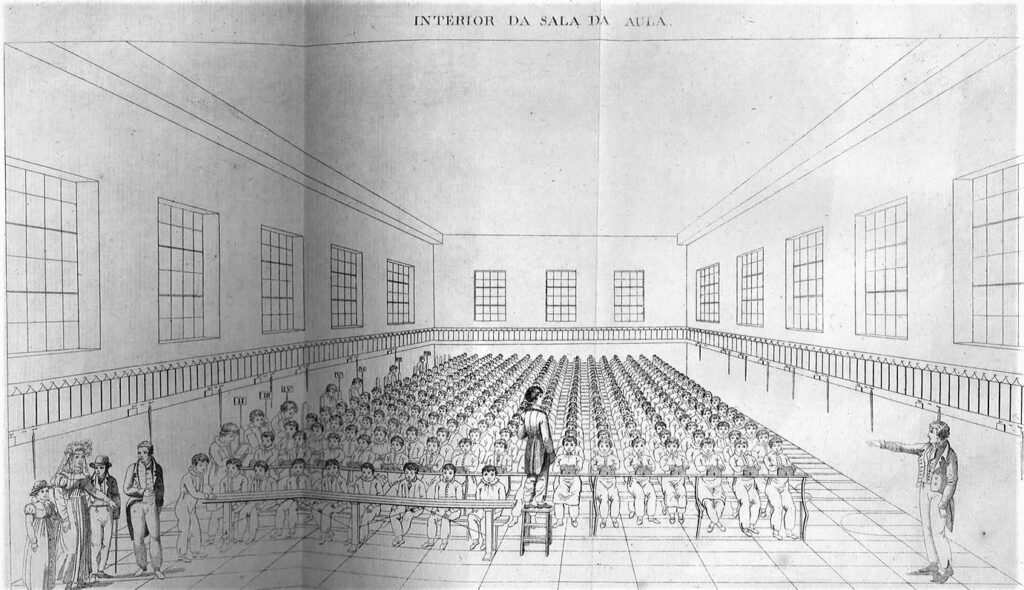
Pour conduire et faire évoluer correctement des dizaines ou centaines d’élèves et éviter toute perte de temps, les responsables de l’enseignement mutuel ont prévu des ordres précis, rapides, immédiatement compréhensibles :
- La voix intervient peu. Les injonctions transmises de cette manière s’adressent généralement aux moniteurs, parfois à une classe tout spécialement.
- La sonnette attire l’attention. Elle précède une information ou un mouvement à exécuter.
- Le sifflet est à double usage. Il permet des interventions dans l’ordre général de l’école, « imposer le silence », par exemple, et il commande le début ou la fin de certains exercices au cours de la leçon, «faire dire par cœur, épeler, cesser la lecture ». Le maître est seul habilité à s’en servir.
- Quant aux signaux manuels, ils ont été beaucoup utilisés. Destinés à évoquer l’acte ou le mouvement à accomplir, ils attirent le regard et doivent apporter le calme dans la collectivité.
Bellistes contre lancastériens
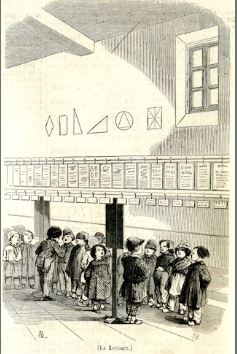
Alors que les deux écoles, celle de Bell et celle de Lancaster sont très proches l’une de l’autre, tant sur le plan des contenus d’enseignement que des méthodes et de l’organisation, elles s’opposeront violemment sur le rôle et la place de l’enseignement religieux. Toutes les autres divergences liées au programme sont affaires de goût, d’habitude ou de circonstances locales.
Comme le précisent Sylvian Tinembert et Edward Pahud dans Une innovation pédagogique, le cas de l’enseignement mutuel au XIXe siècle (Editions Livreo-Alphil, 2019), Lancaster, en tant qu’adepte du mouvement dissident quaker,
« reconnaît le christianisme mais professe que la croyance appartient à la sphère personnelle et que chacun est libre de ses convictions. Il prône également l’égalitarisme, la tolérance et défend l’idée que, dans le pays, il y a une telle variété de religions et de sectes qu’il est impossible d’enseigner toutes les doctrines. Par conséquent, il faut rester neutre, limiter cet enseignement à la lecture de la Bible, en évitant toute interprétation, et laisser l’instruction religieuse fondamentale aux diverses Églises en s’assurant que les élèves suivent les offices et les enseignements de la confession à laquelle ils appartiennent ».
N’empêche que Bellistes et Lancastériens vont s’écharper. Pour les Lancastériens, Bell n’a rien inventé et ne fait que décrire ce qu’il a vu en Inde. Pour les Bellistes, furieux que Lancaster trouve un répondant positif de la part de certains membres de la famille royale, il est dépeint comme le diable, un « ennemi » de la religion anglicane officielle, lui qui admet dans ses écoles des enfants de toutes les confessions !
9. Lorsque la méthode intéresse les Français
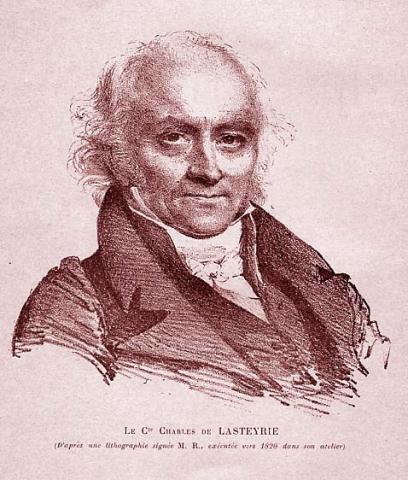
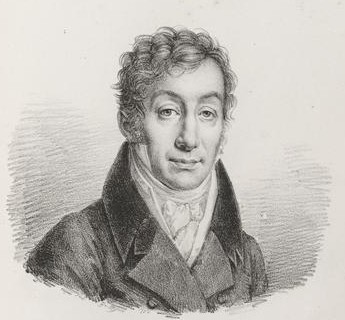
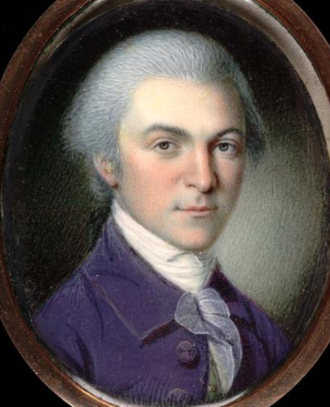
A Londres, l’association de Lancaster sera rejointe par de nombreuses personnalités de haut rang, aussi bien anglaises qu’étrangères. On y retrouve notamment le physicien genevois Marc Auguste Pictet de Rochemont (1752-1825), l’anatomiste et paléontologue français Georges Cuvier (1769-1832) et ses compatriotes, l’agronome Charles Philibert de Lasteyrie et le futur traducteur de Lancaster, l’archéologue Alexandre de Laborde (1773-1842).
Après la paix de 1814, de nombreux pays, notamment l’Angleterre, la Prusse, la France tout comme la Russie, rendus exsangues par les guerres napoléoniennes qui provoquèrent la perte de milliers de jeunes enseignants et cadres qualifiés sur les champs de bataille, font de l’éducation leur priorité notamment pour être à la hauteur de la révolution industrielle qui vient les bousculer.
A cela il faut ajouter que le nombre d’orphelins en Europe est devenu un problème majeur pour tous les États, d’autant plus que les coffres sont vides. Pour occuper les enfants de la rue, il faut des écoles, beaucoup d’écoles à construire avec très peu d’argent et beaucoup de professeurs… inexistants. Apprenant le succès retentissant de l’enseignement mutuel, plusieurs Français se rendent alors outre-Manche pour y découvrir la nouvelle méthode.
De Laborde en rapporte un « Plan d’éducation pour les enfants pauvres, d’après les deux méthodes (du docteur Bell et de M. Lancaster) », et Lasteyrie son « Nouveau système d’éducation pour les écoles primaires ». En 1815, le duc de la Rochefoucauld-Liancourt (1747-1827), publie son livre sur le « Système anglais d’instruction de Joseph Lancaster ».
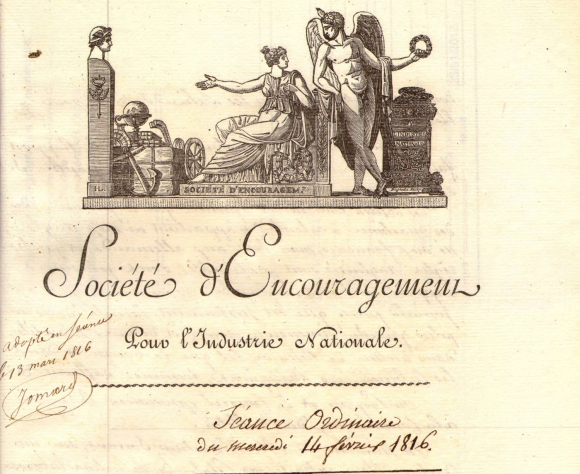
Depuis 1802, il existait à Paris la « Société d’encouragement pour l’industrie nationale », dont le secrétaire général était le linguiste Joseph-Marie de Gérando (1772-1842) et dont Laborde était un des fondateurs. Sans surprise, Gérando avait été élevé par les Oratoriens et se destinait initialement à l’Église.
Le 1er mars 1815, Lasteyrie, Laborde et Gérando proposent à la Société d’encouragement la création d’une association qui aurait pour objet
« de rassembler et de répandre les lumières propres à procurer à la classe inférieure du peuple le genre d’éducation intellectuelle et morale le plus approprié à ses besoins ».
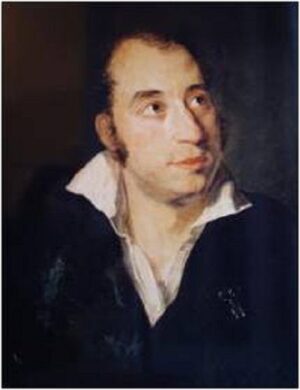
Dans son rapport présenté le 20 mars 1815 devant la Société d’encouragement, Gérando propose de solliciter le tout nouveau ministre de l’Intérieur Lazare Carnot (du 20 mars au 22 juin 1815) pour qu’il favorise « l’adoption des procédés propres à régénérer l’instruction primaire en France », c’est-à-dire le système d’enseignement mutuel.
L’intérêt politique et social ne sont pas seuls en jeu. L’économie française aussi doit tirer profit du développement de l’instruction. Qu’espérer, dit Carnot en 1815,
« si l’homme qui conduit la charrue est aussi stupide que les chevaux qui la tirent ? »
Gérando propose également la création d’une société dédiée spécifiquement à sa propagation en soulignant les avantages de la nouvelle approche : avantage économique d’abord, puisqu’il s’agit d’« employer les enfants eux-mêmes, les uns vis-à-vis des autres, comme auxiliaires de l’enseignement » et qu’un seul maître suffit pour 1000 élèves ; avantage éducatif ensuite, puisqu’il est possible « d’enseigner, en deux ans, tout ce que les enfants des conditions inférieures ont besoin de savoir et beaucoup plus qu’ils n’apprennent aujourd’hui par des procédés bien plus longs » ; avantage moral et social enfin, dans la mesure où les enfants « se pénètrent de bonne heure du sentiment du devoir, sentiment qui garantira un jour leur obéissance aux lois et leur respect pour l’ordre social ».
L’ingénieur-géographe et polytechnicien Edme-François Jomard (1777-1862), pour qui l’instruction du peuple est une obligation de la société vis-à-vis d’elle-même, ne disait rien d’autre: « Comment exiger d’infortunés, dénués de toutes lumières, qu’ils connaissent le pacte social et s’y soumettent ? ou comment pourrait-on, sans être insensé, compter sur leur invariable et aveugle soumission ? »
La Société d’encouragement valida alors les conclusions de son rapport en souscrivant pour une somme de 500 francs en faveur de l’association nouvelle et en décidant qu’elle mettrait à la disposition de celle-ci, outre son influence morale, les divers moyens d’exécution qui pouvaient lui appartenir.
10. Lazare Carnot à la manœuvre
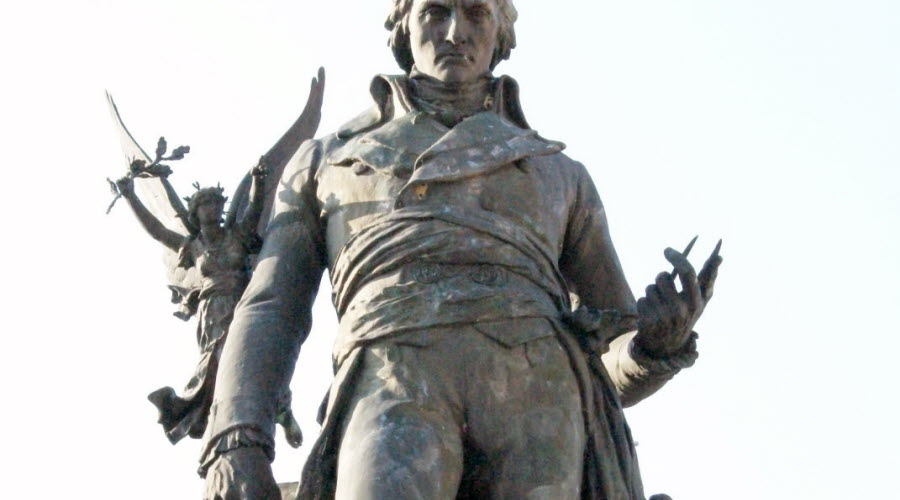
Suite au Concordat entre Napoléon et le Vatican, l’Empereur, par son décret du 15 août 1808 sur l’éducation, décide que les écoles doivent désormais suivre les « principes de l’Église catholique ».
Les « Frères des écoles chrétiennes » (ou Lasalliens), partisans inconditionnels de « l’enseignement simultané », théorisé par leur fondateur Jean-Baptiste de La Salle, s’occuperont désormais de l’enseignement primaire et formeront les instituteurs.
Dispersés lors de la Révolution, ils reprennent leurs fonctions en 1810. Encouragés à se développer pour contrer l’influence des jésuites, autorisés en 1816 à revenir en France, ils se développent rapidement dans toute la France.
Mais la situation de l’éducation est pitoyable. C’est ce que constatent des hauts fonctionnaires français lorsqu’ils se rendent dans les territoires annexés par l’Empire, notamment l’Allemagne du Nord et la Hollande. La comparaison avec la France les fait rougir de honte.
« Nous aurions peine, écrit en 1810 le naturaliste Georges Cuvier dans son rapport, à rendre l’effet qu’a produit sur nous la première école primaire où nous sommes entrés en Hollande. »
Enfants, maîtres, local, méthodes, enseignement, tout est d’une tenue parfaite : « Plusieurs préfets ont assuré qu’on ne trouverait pas aujourd’hui dans leur département un seul jeune garçon qui ne sût lire et écrire. » Devant un tel contraste, qui ne tournait pas à l’avantage du conquérant, l’Université impériale, comme la Rome antique, se mit à l’école du pays conquis. Dans son décret du 15 novembre 1811 l’Empereur décide : « Le conseil de notre Université Impériale nous présentera un rapport sur la partie du système établi en Hollande pour l’instruction primaire qui serait applicable aux autres départements de notre Empire. »
L’Empereur abdique le 4 avril 1814 avant qu’une décision ait été prise pour régénérer les « petites écoles » françaises. Du moins l’Université Impériale avait-elle, par ses rapports, étalé au grand jour leur misère, attirant sur elles l’attention de l’opinion.
Nommé ministre de l’Intérieur, et donc en charge de l’Education lors des Cent-Jours, Lazare Carnot est persuadé du potentiel d’excellence de « l’enseignement mutuel ».
Il crée, le 10 avril 1815, un Conseil d’industrie et de bienfaisance, à la première séance duquel il donne lui-même communication du rapport de Gérando ;
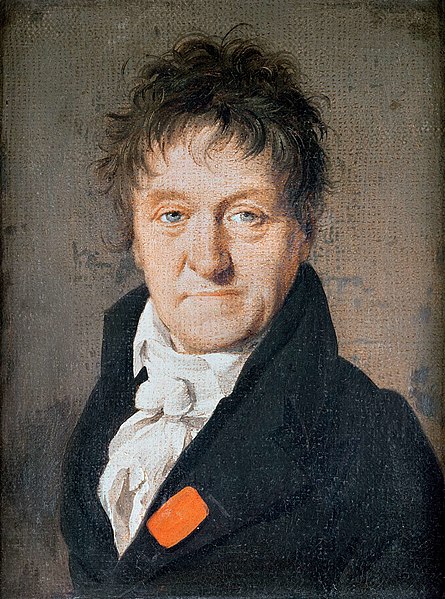
Le 27 avril 1815, Lazare Carnot fait un rapport à l’Empereur où il dit :
« Il y a en France, 2 millions d’enfants qui réclament l’éducation primaire, et, sur ces 2 millions, les uns en reçoivent une très imparfaite, tandis que les autres en sont complètement privés. »
Il recommande alors l’enseignement mutuel :
« Elle a pour objet de donner à l’éducation primaire le plus grand degré de simplicité, de rapidité et d’économie, en lui donnant également le degré de perfectionnement convenable pour les classes inférieures de la société et aussi en y portant tout ce qui peut faire naître et entretenir dans le cœur des enfants le sentiment du devoir, de la justice, de l’honneur et le respect pour l’ordre établi ».
Il fait signer le même jour à l’empereur le décret suivant :
« Article 1er. – Notre ministre de l’Intérieur appellera près de lui les personnes qui méritent d’être consultées sur les meilleures méthodes d’éducation primaire. Il examinera ces méthodes, décidera et dirigera l’essai de celles qu’il jugera devoir être préférées.
« Art. 2. – Il sera ouvert, à Paris, une École d’essai d’éducation primaire, organisée de manière à pouvoir servir de modèle et à devenir école normale, pour former des instituteurs primaires.
« Art. 3. – Après qu’il aura été obtenu des résultats satisfaisants de l’École d’essai, notre ministre de l’Intérieur nous proposera les mesures propres à faire promptement jouir tous les départements des nouvelles méthodes qui auront été adoptées ».
Pour Carnot, en rupture avec ceux qui ne pensaient qu’en termes de philanthropie, il n’y avait plus d’enfants riches ou pauvres. En tant que citoyens, tous devraient désormais pouvoir disposer de la meilleure éducation possible.
Le conseil consultatif constitué par Carnot comprend ses amis Laborde, Jomard, l’abbé Gaultier, puis Lasteyrie et Gérando, c’est-à-dire les promoteurs mêmes ou les premiers fondateurs de la Société en formation.
Ainsi naîtra, le 17 juin 1815 (c’est-à-dire la veille de la défaite de Waterloo) la Société pour l’instruction élémentaire (SIE), toujours sous l’impulsion de Carnot bien décidé à gagner la guerre pour l’instruction. La première assemblée générale de la SIE se tient dans les locaux de la Société d’encouragement. À sa tête, on retrouve plusieurs protagonistes de la commission ministérielle : Jomard devient l’un des secrétaires de la nouvelle société, aux côtés de Gérando (président), Lasteyrie (vice-président) et Laborde (secrétaire général).

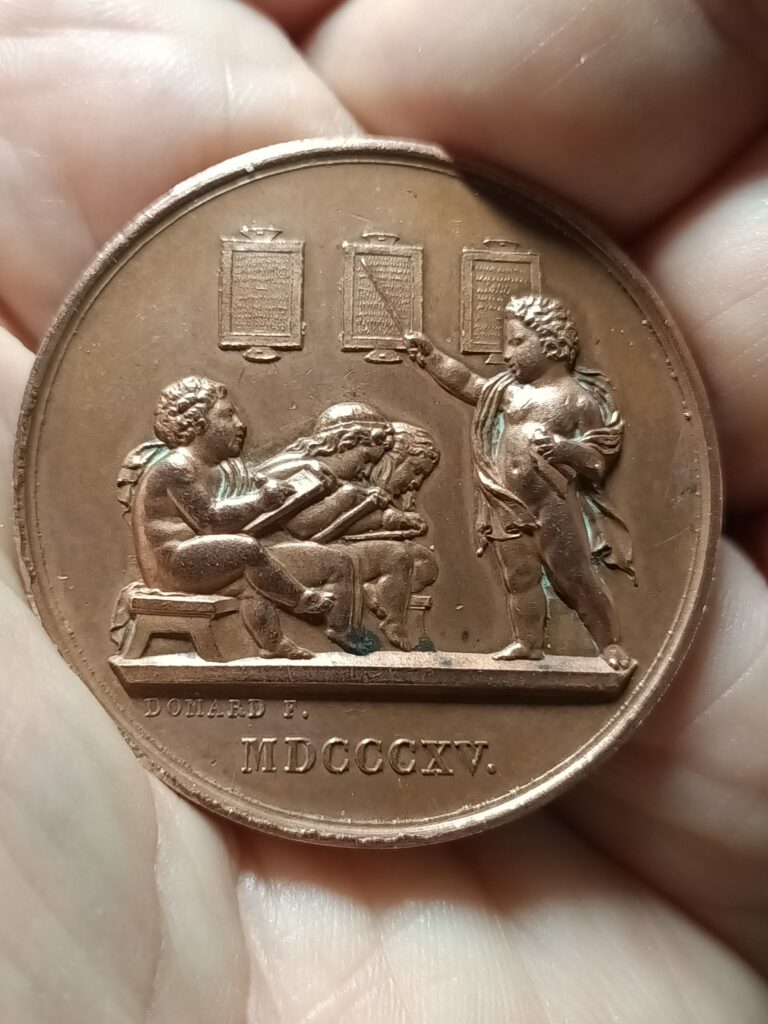
Avant l’ordonnance de 1816, le nombre d’enfants qui suivaient les petites écoles était de 165 000 dans toute la France, et il se trouve porté à 1 123 000 à la fin de 1820.
Lazare Carnot a clairement voulu pérenniser son offensive lancée durant les Cent-Jours en faveur de la propagation de l’enseignement mutuel à travers le pays et, ce faisant, en participant au développement rapide de l’instruction de tous les enfants de la Patrie.
Après sa création, les souscriptions pour la SIE affluent, et en peu de temps 150 noms s’ajoutent à ceux des fondateurs pour promouvoir et organiser l’enseignement mutuel en France. L’un de ces souscripteurs est forcément Lazare Carnot.
Au cours de sa première année d’existence, la SIE recueille l’adhésion de près de 700 membres, dans un premier temps des enseignants de l’École polytechnique (Ampère, Berthollet, Chaptal, Guyton de Morveau, Hachette, Mérimée, Thénard), et ensuite une trentaine d’anciens élèves, dont environ la moitié est issue de la première promotion (1794) de l’École polytechnique. Parmi ces derniers, un camarade de Jomard à l’Ecole des géographes, Louis-Benjamin Francœur, professeur d’algèbre supérieure à la Faculté des sciences de Paris, des camarades de la campagne d’Egypte ou encore Chabrol de Volvic, préfet de la Seine depuis 1812.
Tous n’ont qu’un seul espoir : que les méthodes géniales de Monge, brigades et enseignement mutuel, diminuées et interdites depuis que Napoléon a transformé Polytechnique en une simple école militaire sous la direction du mathématicien Pierre-Simon Laplace (1749-1827), puissent profiter au plus grand nombre et organiser un redressement national.
De Paris, la sollicitude de la SIE s’étend à la province ; elle y encourage la fondation de sociétés filiales, à qui elle offre « de leur envoyer des maîtres, de leur communiquer les renseignements dont elles pourraient avoir besoin, de leur donner au prix coûtant les tableaux et les livres… ».
La SIE se mobilise également pour l’éducation publique des filles (art. 10). Elle met sur pied, pour s’occuper d’elles, un comité de dames : présidente, la baronne de Gérando ; vice-présidente, la comtesse de Laborde. Des filles, le mouvement gagne les adultes sans instruction, si nombreux alors.
Le 1er mai 1816 la Société créait une commission pour l’établissement d’écoles d’adultes. Elle s’occupe aussi des casernes, dont on veut faire des écoles pour militaires ; des prisons, prisons d’enfants surtout; des habitants des colonies, que l’on pense élever par le développement de l’instruction.
Enfin les membres de la Société, attribuant une valeur humaine et générale à leur mission, rêvent de fonder des filiales à l’étranger. En novembre 1818, Laborde demande la création d’un comité spécial pour les écoles étrangères.
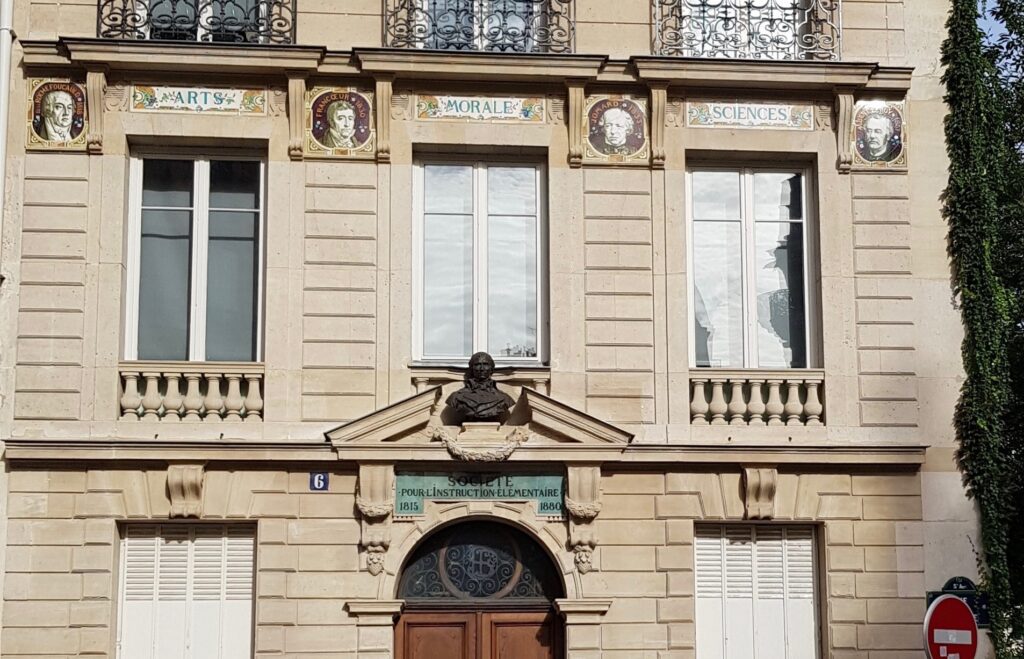
La Société enfin, ne bornant pas son activité à la simple création d’écoles, organisait des inspections, des examens. Elle assurait la publication d’ouvrages (ouvrages relatifs à la méthode mutuelle, livres élémentaires de lecture, de grammaire et d’arithmétique). Elle distribuait des récompenses aux meilleurs maîtres et moniteurs. Elle demandait aux maîtres, après promulgation de l’ordonnance du 29 juillet 1818 autorisant les sociétés de Caisse d’Epargne, de confier à ces Caisses une partie de leurs gages pour assurer leurs vieux jours. Donnant l’exemple, elle déposait à la Caisse des fonds pour les maîtres des écoles créées par elle.
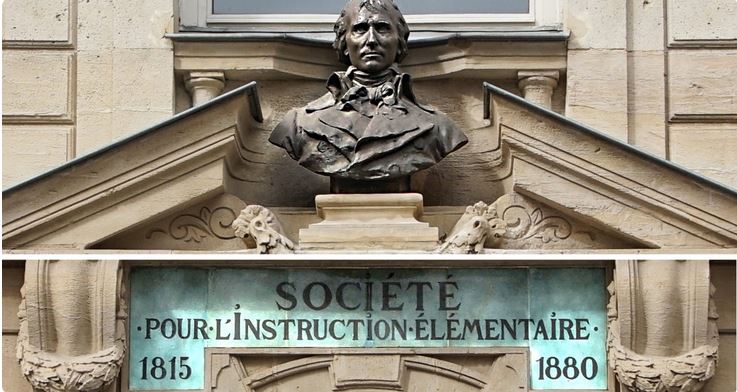
La SIE, dont le siège est un local spécialement construit pour elle, situé au 6, rue du Fouarre à Paris 5e, reste aujourd’hui la plus ancienne et la plus grande association laïque d’enseignement primaire que nous possédons en France.
11. Le projet pilote de la rue Saint-Jean-de-Beauvais
Après son voyage en Angleterre, Jomard, dont le portrait figure en médaillon sur la façade de la SIE est lui aussi acquis au nouveau système. Faisant part de ses « réflexions sur l’état de l’industrie anglaise », il écrit, après s’être enthousiasmé pour diverses inventions observées outre-Manche :
« Il y a cependant quelque chose de plus extraordinaire encore : ce sont des écoles sans maîtres : rien, pourtant, n’est plus réel. On sait à présent qu’il existe des milliers d’enfants enseignés sans maître proprement dit, et sans qu’il n’en coûte rien à leur famille, ni à l’État : admirable méthode qui ne peut tarder à se propager en France. »
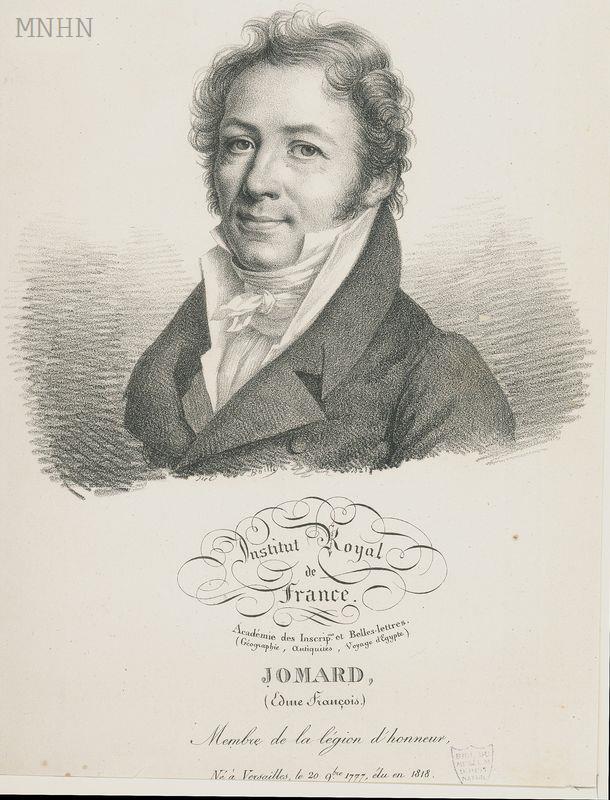
Polytechnicien, Jomard est l’homme idéal pour piloter l’organisation matérielle de l’école d’essai, s’attachant notamment à faire réaliser le mobilier et imprimer les supports pédagogiques conformément aux principes anglais. Il supervise également la formation au rôle de « moniteur » d’un petit noyau d’élèves – ils sont une vingtaine – avant l’ouverture en septembre 1815 de l’école proprement dite, prévue pour 350 élèves : une modalité qui n’est pas sans rappeler les « chefs de brigade » de la première promotion de l’École polytechnique.
Cependant, très rapidement, les membres de la SIE se rendent à l’évidence qu’il faut former des formateurs. Les Anglais accueillent alors plusieurs Français pour les former à l’enseignement mutuel. Un pasteur cévenol, François Martin (1793-1837), après sa formation comme « moniteur » en Angleterre, est appelé par Lasteyrie pour diriger la première école mutuelle, qui ouvre ses portes le 13 juin 1815, rue Saint-Jean-de-Beauvais à Paris. Il s’agit de l’école modèle qui doit permettre l’ouverture d’autres écoles mutuelles grâce à la formation de « moniteurs » compétents. Rapidement, elle ne peut plus faire face à la demande de centaines de communes qui envisagent d’y envoyer l’un des leurs pour se former à la nouvelle méthode.
Le pasteur Paul-Emile Frossard, lui aussi formé par les Anglais, prend la tête d’une école parisienne rue Popincourt, Bellot en dirige une autre. En juillet, Martin rend son rapport. La classe modèle accueille une quinzaine d’élèves destinés à devenir moniteurs et directeurs d’écoles élémentaires qui comptent jusqu’à 350 enfants. Martin rapporte qu’en six semaines, ils lisent, écrivent, calculent et « savent exécuter les mouvements qui forment la partie gymnastique du nouveau système d’éducation ».
12. Enseignement mutuel et chant choral
Or, comme le documente amplement Christine Bierre dans son article « La musique et formation du citoyen à l’ère de la Révolution française » (1990),
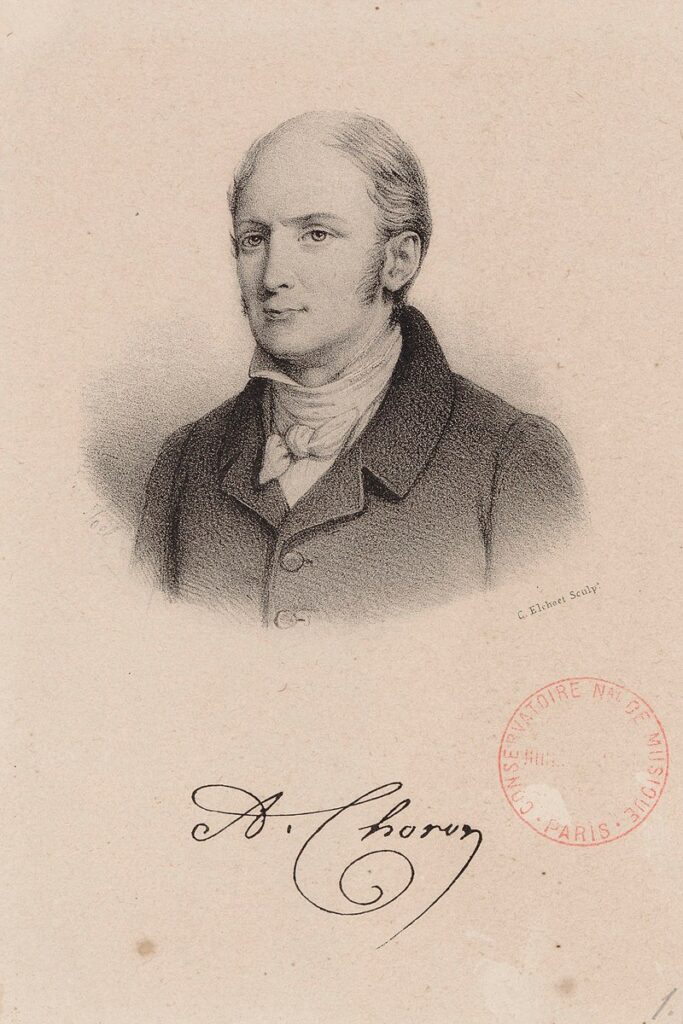
« C’est à cette école de la rue Saint-Jean-de-Beauvais, sous la direction d’une Commission comprenant Gérando, Jomard, Lasteyrie, Laborde et l’abbé Gaultier, que fut testée pour la première fois, l’application de l’enseignement mutuel à l’apprentissage du solfège et du chant.
Alexandre Choron, qui depuis 1814 avait ouvert deux écoles de musique de garçons et de filles, faisait également partie de la Commission.
Il n’est donc pas étonnant de découvrir que ce fut à l’initiative du baron de Gérando, que l’idée d’introduire le chant dans l’instruction primaire a été adoptée. ‘Quant Monsieur le baron de Gérando vous a fait la proposition d’introduire le chant élémentaire dans les écoles de premier degré’, dit Jomard dans un rapport présenté au Conseil d’administration de la Société pour l’Enseignement mutuel, ‘vous avez tous été frappés de la justesse des vues développées par notre collègue (…) Il a fait voir l’influence heureuse que pourrait avoir une pareille pratique, et la connexion réelle qui existe entre un bon emploi du chant et le perfectionnement de la morale, but final de l’instruction et de tous nos efforts. Non seulement, l’application de l’enseignement mutuel à la musique était révolutionnaire en elle-même, mais ce qui l’était tout autant, c’est le fait que les enfants apprenaient à lire et à écrire, de façon presque aussi intensive. Les enfants étudiaient le chant, à raison de quatre à cinq heures par semaine ! »
En réalité, c’est Lazare Carnot lui-même qui a voulu introduire la musique dans les écoles d’enseignement mutuel. Dans cette intention, il rencontre plusieurs fois Alexandre Choron, qui réunit un certain nombre d’enfants et leur fait exécuter en sa présence plusieurs morceaux appris en fort peu de leçons. Carnot connaît Wilhem depuis dix ans. Il entrevoit donc la possibilité d’introduire, par lui, le chant dans les écoles, et tous deux visitent ensemble celle de la rue Saint-Jean-de-Beauvais, école pilote gratuite d’enseignement mutuel ouverte à Paris à trois cents enfants.
L’article récent de Michael Werner, « Musique et pacification sociale, missions fondatrices de l’éducation musicale (1795-1860) » dans la revue Gradhiva (N° 31/2020), vient en écho confirmer les recherches initiées par Christine Bierre en 1990.
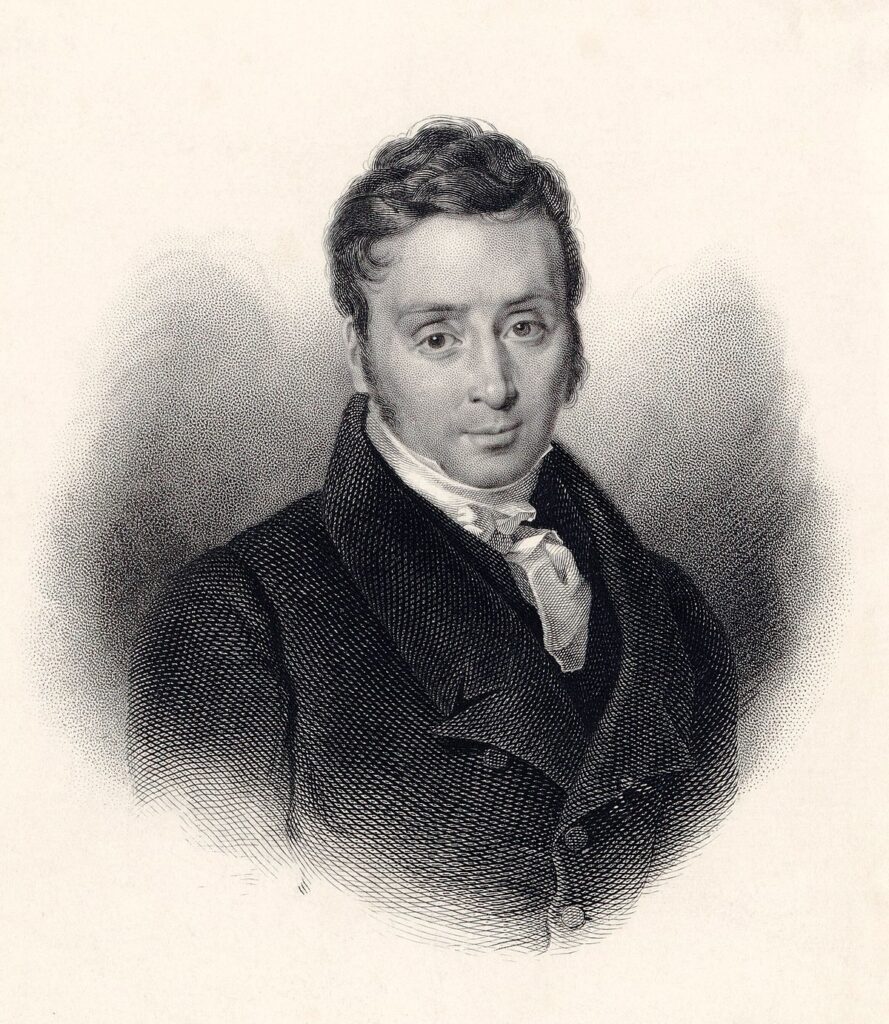
Extrait :
« L’un des domaines où les résultats de la pédagogie mutualiste sont bien visibles est précisément l’éducation musicale. Plusieurs acteurs y ont joué un rôle décisif et méritent qu’on s’y attarde un moment. Le premier est Guillaume-Louis Bocquillon, dit Wilhem. Fils d’officier et lui-même issu d’une formation militaire, il s’est ensuite consacré à la composition et à l’enseignement musicaux, en particulier au lycée Napoléon (ultérieurement collège Henri-IV). Son ami Pierre Jean de Béranger le met en contact avec Joseph-Marie de Gérando et François Jomard, grands animateurs de la SIE. Par leur intermédiaire, il prend connaissance de l’enseignement mutuel et comprend immédiatement les apports de cette méthode à l’éducation musicale. En 1818, la municipalité de Paris lui permet de monter une première expérience à l’école élémentaire de la rue Saint-Jean-de-Beauvais.
Wilhem élabore une méthode, le matériel pédagogique nécessaire (sous forme de tableaux) et instruit les élèves moniteurs choisis. Les résultats sont, aux dires de Jomard, spectaculaires. Au terme d’un enseignement de quelques mois, les élèves ont non seulement acquis les notions de base du solfège et de la notation musicale, les gammes chromatiques, les intervalles et mesures, mais exécutent aussi des chants collectifs à plusieurs voix (Jomard 1842 : 228 sq.).
La réussite conduit la SIE à proposer au préfet et au ministre de l’Intérieur d’introduire la musique dans l’enseignement des écoles élémentaires de la ville de Paris, ce qui sera officiellement entériné en 1820. Wilhem lui-même est nommé professeur titulaire d’enseignement musical à Paris et les cours de musique se généralisent dans un grand nombre d’écoles de la ville avant de se répandre dans les départements et en région. En même temps, la municipalité ouvre deux écoles normales chargées de former les futurs professeurs de chant.
Le deuxième acteur à intervenir très tôt dans le débat est le compositeur Alexandre Choron. Membre, comme Jomard et Francœur, de la première promotion de l’École polytechnique (1795), compositeur et ami d’André Grétry, il s’est dès 1805 préoccupé du dépérissement du chant choral consécutif à la suppression des maîtrises. Adversaire du Conservatoire dont il critique l’académisme et le désintérêt pour l’enseignement du chant choral, il est chargé par le ministère en 1812 d’une mission de « réorganisation du chœur et des maîtrises de musiques des églises de France ». Il élabore une méthode d’enseignement appelée « méthode concertante », mais reste également attaché à la vocation sociale de la musique chorale. Choron fait par ailleurs partie des membres fondateurs de la SIE en 1815, signe de son engagement dans les questions éducatives. Pendant la Restauration, il se tourne davantage vers les chants religieux qu’il considère comme le cœur historique de la pratique de la chorale.
(…) Enfin, il fonde, avec l’appui du roi l’Institution royale de musique classique et religieuse, concurrençant avec succès le Conservatoire dans l’enseignement de l’art vocal. Pour le grand public, il fait exécuter, à grand renfort de chanteurs issus de son école, des oratorios, requiem et cantates dans quelques églises spacieuses, assurant ainsi à la musique sacrée une nouvelle présence sur la scène parisienne. Pour certains de ces concerts, il lui arrive de mobiliser des élèves chanteurs des écoles élémentaires et des écoles des pauvres qu’il n’a jamais cessé de suivre tout au long de sa carrière.
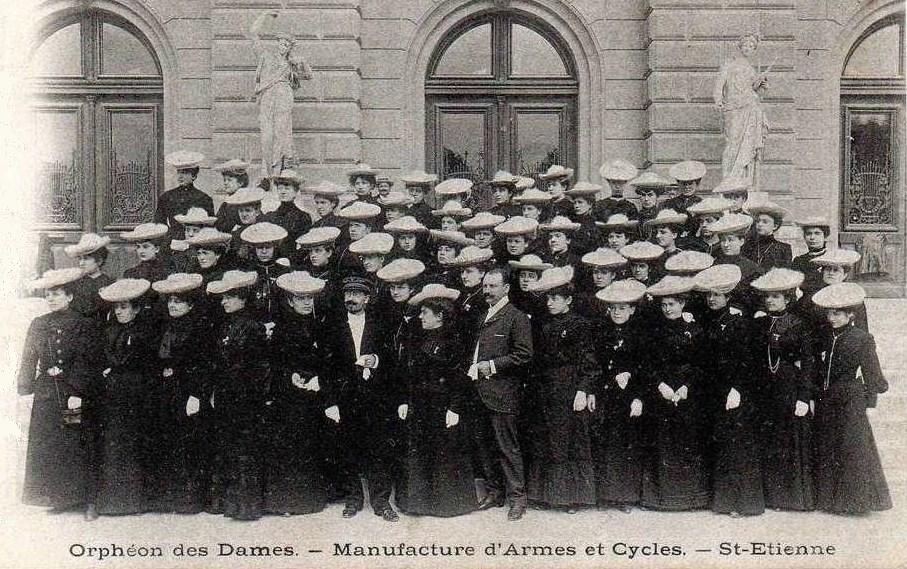
« (…) Ce qui a favorisé cette expansion de l’enseignement de la musique à destination des jeunes et des couches populaires à partir de 1820 était bien une volonté politique partagée par un large spectre de responsables et d’intervenants. Du côté des libéraux qui constituaient le noyau de la SIE, on continuait de s’inscrire dans la mission émancipatrice de l’éducation, fixée par la Convention. En pointant à la fois la formation intérieure de l’âme et l’épanouissement d’une conscience collective, la musique, et en particulier le chant, devient un terrain de choix pour l’éducation populaire. Les libéraux insistent donc sur les bienfaits moraux de la musique. Ainsi, dans sa proposition d’introduire le chant dans les écoles primaires, Gérando remarque-t-il : ‘Ceux d’entre nous qui ont visité l’Allemagne ont été surpris de voir toute la part qu’a une musique simple aux divertissements populaires et aux plaisirs de famille, dans les conditions les plus pauvres, et ont observé combien son influence est salutaire sur les mœurs.’
« Et Joseph d’Ortigue constate de façon lapidaire : ‘Un peuple qui chante est un peuple content, et par conséquent un peuple moral.’ Cette mise en avant des bienfaits sociaux de l’activité musicale correspond bien à l’idée d’une ‘éducation universelle’, héritée des Lumières et au fondement des pédagogies de Lancaster en Angleterre ou de Johann Heinrich Pestalozzi en Suisse.
« Le chant, après l’essai fait à l’école St-Jean-de-Beauvais en 1819, pénètre très rapidement dans toutes les écoles mutuelles. Wilhem est à la fois le créateur et l’artisan du développement de cet enseignement qui gagne bientôt les cours d’adultes et d’apprentis. Des réunions périodiques d’enfants initiés à la musique vocale furent organisées. Ainsi naquit la première œuvre post-scolaire française : l‘Orphéon qui, après Wilhem, compte parmi ses directeurs Charles Gounod et Jules Pasdeloup. »
Dans un discours de 1842 devant la SIE, Hippolyte Carnot (fils de Lazare Carnot) affirme que Wilhem « a élevé la musique au rang d’une institution civique » et que « l’ennoblissement » de l’âme individuelle doit s’accomplir dans le nouvel ordre collectif de la nation réunie.
13. Jomard, Choron, Francoeur et savoirs « élémentaires »
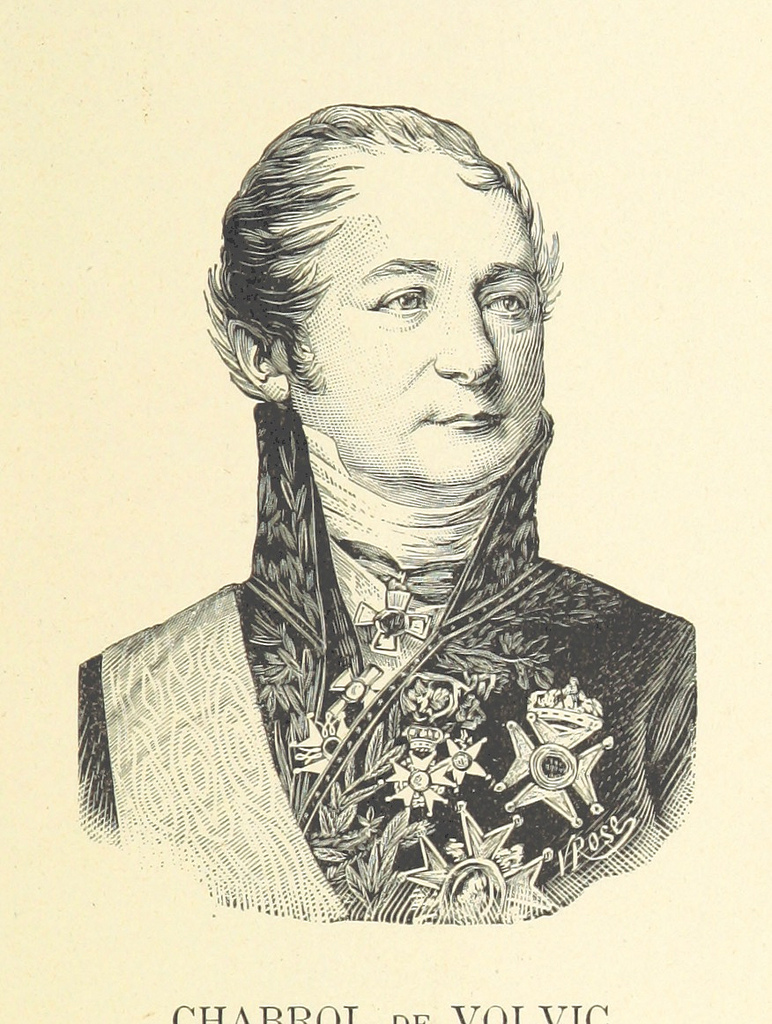
L’article très complet de Renaud d’Enfert, publié sur le site de la Société de la bibliothèque et de l’histoire de l’Ecole polytechnique (SABIX), permet de compléter le tableau en faisant un gros plan sur l’action de Jomard et Francoeur dont les portraits figurent d’ailleurs en médaillon sur la façade du siège de la SIE rue du Fouarre à Paris.
Dès le début de la Seconde Restauration, la SIE reçut l’adhésion et l’appui du préfet de la Seine, Gaspard Chabrol de Volvic (1773-1843). Ce dernier va nommer dès l’été 1815 Jomard, le linguiste en contact avec les frères Humboldt qui a fait partie de l’éphémère commission sous Carnot et qui l’a protégé pendant les Cent-Jours, « chef de bureau d’instruction publique et arts », poste qu’il occupe jusqu’en 1823.
Par un arrêté du 3 novembre 1815, Volvic, afin d’arrêter « les mesures nécessaires pour étendre le bienfait de l’instruction à toutes les familles pauvres domiciliées dans l’étendue de la préfecture » et de développer « le nouveau système d’instruction élémentaire » dans l’ensemble du département de la Seine, crée, « pour étendre les bienfaits de l’instruction gratuite au département de la Seine » un comité de onze personnes, et y fait entrer tous les membres influents de la SIE (Jomard, Gérando, Laborde, Doudeauville, Lasteyrie, Gaultier, etc.).
Dans ces fonctions, Jomard est chargé de trouver des sites pour établir de nouvelles écoles. Celles-ci se multiplient rapidement dans la capitale et ses environs : en 1818, il comptabilise 18 écoles mutuelles gratuites et 32 payantes couvrant l’ensemble des arrondissements de la capitale, ainsi que 13 écoles dans les arrondissements de Sceaux et de Saint-Denis. De ce travail, il tire son « Abrégé des écoles élémentaires » (1816), sorte de guide pratique dans lequel il réunit tout ce que doit savoir, du point de vue de l’organisation matérielle, tout citoyen décidé à fonder une école mutuelle.
Sur le plan pédagogique, Jomard est l’auteur, en 1816, d’une méthode de lecture réalisée en collaboration avec le compositeur et musicien Alexandre Choron qui avait publié dès 1802 une méthode pour apprendre à lire et à écrire, et l’abbé Gaultier, un pédagogue qui avait développé une méthode d’enseignement sous le nom de « jeux instructifs » et s’était rendu à Londres pour étudier les méthodes anglaises.

Conçue pour la nouvelle école normale élémentaire de la rue Saint-Jean-de-Beauvais, où Choron a été nommé comme enseignant de musique, elle rompt avec la méthode traditionnelle d’épellation. Au lieu de dire « b-o-n = bon », elle part des sonorités musicales de la langue pour dire « b-on = bon ».
Jomard fait également paraître, en 1821-1822, une « Arithmétique élémentaire », destinée à pallier les faiblesses constatées de la méthode d’arithmétique de Lancaster : celle-ci est en effet accusée de « faire contracter aux enfants une simple habitude routinière et mécanique » au lieu de servir « à fortifier leur attention et à les former au raisonnement ». Dans l’intervalle, il a mis au point avec Francœur et Lasteyrie, au sein d’une « Commission de calligraphie » de la SIE, les principes qui doivent guider l’apprentissage de l’écriture dans les écoles mutuelles, une écriture voulue « nationale », afin de remplacer les modèles anglais.
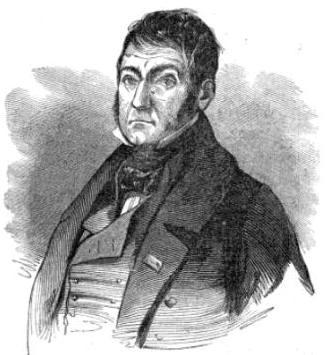
Pour sa part, Louis-Benjamin Francoeur (1773-1849) fournit, selon Jomard, « une longue suite de rapports lumineux sur les traités d’arithmétique, de poids et mesures, de chant et d’art musical, de dessin et de géométrie, qu’il serait bien trop long de rapporter ou de citer ».
Comblant un manque, Francœur publie en 1819 « Le dessin linéaire », une méthode de dessin basée sur le dessin à main levée des figures géométriques qui rompt avec les modalités traditionnelles d’enseignement et d’apprentissage du dessin, inspirées de pratiques académiques.
Pour Jomard et Francoeur, il s’agit, avec l’enseignement mutuel, d’élargir le nombre des matières de l’instruction primaire au-delà du traditionnel « lire, écrire, compter » : outre le dessin, des matières comme le chant, la gymnastique, la géographie ou la grammaire font ainsi leur apparition dans les écoles primaires via l’enseignement mutuel. Le dessin linéaire n’en apparaît pas moins comme un savoir élémentaire à part entière, au même titre que la lecture, l’écriture et l’arithmétique.
Présentant la méthode de Francœur à la Société d’encouragement, Jomard déclare ainsi :
« L’utilité que l’industrie en peut retirer un jour est si grande et si visible, qu’il serait superflu d’y insister. Ce n’est pas sans raison qu’on a regardé ce résultat comme aussi précieux pour le peuple, que la connaissance de la lecture et de l’écriture. »
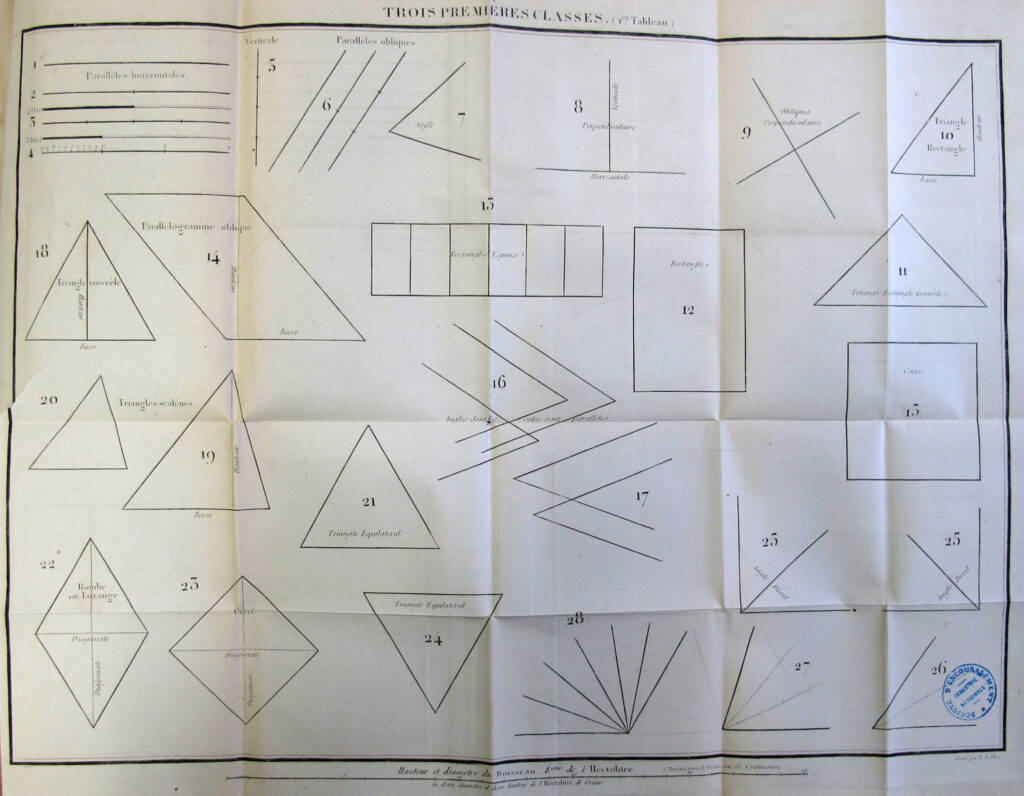
Enfin, pour Jomard, l’apprentissage généralisé de la lecture, de l’écriture, du calcul, du dessin linéaire et du chant, est le préalable obligé à l’éducation scientifique du peuple :
« On a dans ces derniers temps, avec grande raison, insisté sur l’utilité de l’enseignement des éléments des sciences physiques et mathématiques à la classe ouvrière. C’est de là que dépend l’avancement de l’industrie et de l’agriculture, qui, malgré tous leurs progrès, sont encore arriérées chez nous sous plusieurs rapports. Ce n’est que par la possession de ces notions élémentaires que les ouvriers perfectionneront leurs procédés, leurs moyens, leurs instruments, leurs produits, et pourront devenir d’habiles contremaîtres et de bons chefs d’ateliers. Mais comment arriver à ce résultat, quand la masse de la population est encore si ignorante.
« Comment, sans l’art de lire et d’écrire, pourrait-elle, non pas comprendre un seul mot des arts chimiques et mécaniques, mais seulement en sentir l’avantage et consentir à se livrer à des études pénibles ? Quoi ! 15 millions de Français et plus peut-être, ne savent pas faire les deux premières règles de l’arithmétique, et l’on se flatterait de propager parmi eux les premiers principes de la mécanique et de la géométrie ! La base de cette amélioration est évidemment l’instruction primaire rendue plus générale ou même universelle. »
14. Rayonnement au niveau national
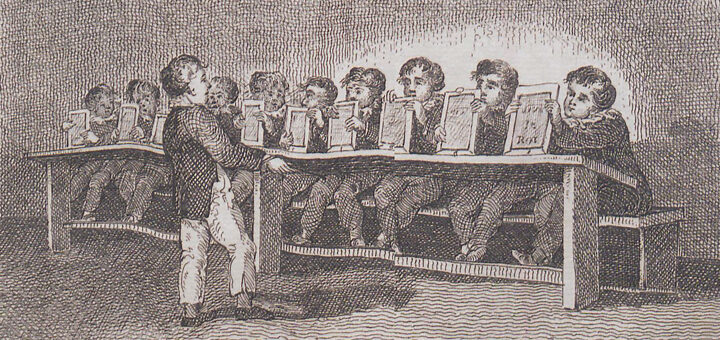
Les résultats de l’enseignement mutuel sont spectaculaires et rapides, qu’il s’agisse de la durée des apprentissages ou de la qualité des acquis. Alors que dans les écoles des Frères il fallait 4 années pour apprendre à lire, ce temps est réduit à une année et demie dans les établissements mutuels !
Les Français de 1815, à l’enthousiasme si prompt, et à l’imagination si vive, virent dans ce système d’enseignement, une véritable panacée. Il présentait certes d’incontestables avantages. D’abord il est économique puisqu’il exige peu de maîtres, et permet d’instruire à peu de frais un nombre considérable d’enfants. On estime qu’il suffisait de 4000 à 5000 fr. par an pour entretenir une école de 1000 enfants : 4 francs par élève ! Jamais l’instruction n’aura été donnée à si bas prix. Il permettait aussi d’assurer un développement rapide de l’enseignement primaire puisque l’on n’était plus arrêté désormais par la pénurie de maîtres. Chiffres à l’appui, on calculait qu’il suffirait d’une douzaine d’années pour étendre à la France entière les bienfaits de l’instruction primaire !
A ces avantages indiscutables, ceux qui avaient visité l’Angleterre en 1815 ajoutaient des arguments qualitatifs. Ils estimaient l’enseignement des instructeurs supérieur à celui des maîtres :
« Il ne sait pas sa leçon mieux que le maître, écrivait Laborde, mais il la sait autrement ».
L’enfant instructeur (moniteur) a plaisir à communiquer à ses camarades ses connaissances nouvellement acquises, il fait son travail
« avec autant de charme qu’un précepteur y trouve de dégoût » (Laborde).
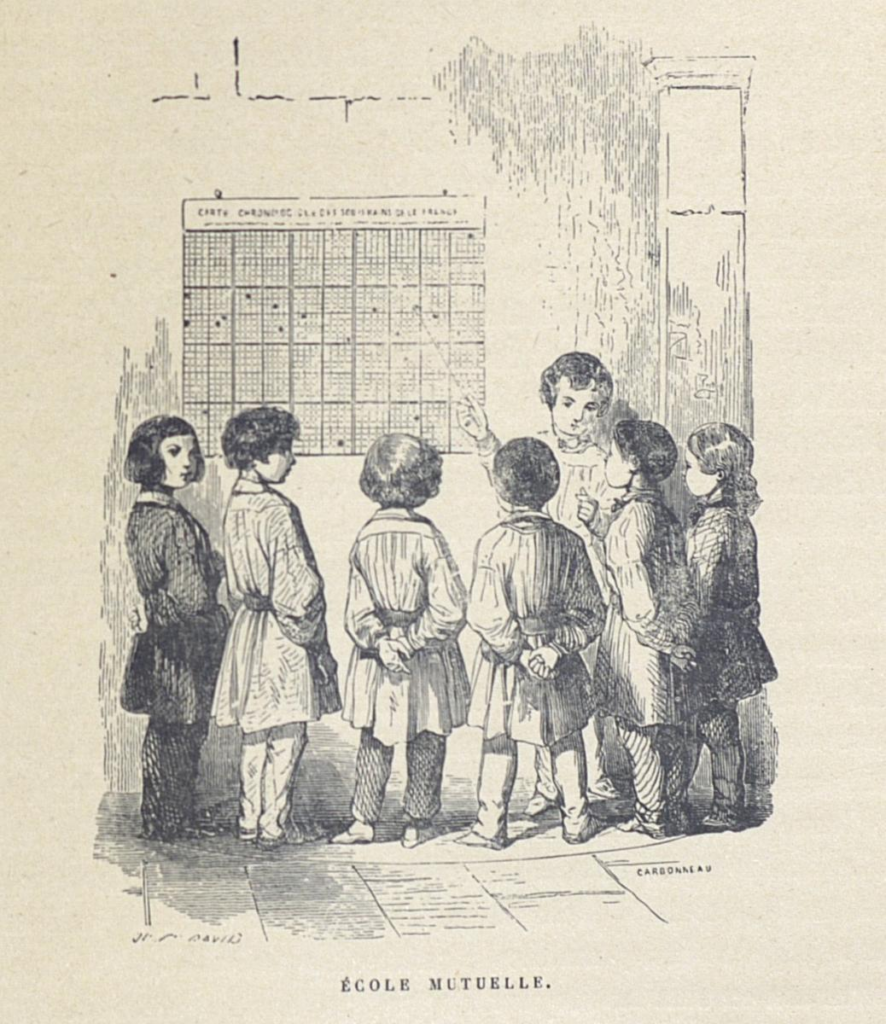
D’autre part, étant enfant lui-même, il connaît mieux que le maître les difficultés de la tâche, les embûches de la leçon, sur lesquelles il vient juste de trébucher. Il conduira donc ses camarades plus lentement, plus sûrement, sera pour eux un meilleur guide.
Mais l’enseignement ne sera pas seul à profiter du système mutuel ; la discipline de l’école et la morale y trouveront aussi leur compte. L’enfant, soumis à son camarade, lui obéira plus volontiers qu’au maître, puisque le jeune instructeur ne doit sa supériorité qu’à son mérite. Enfin l’enfant, avec son camarade qui le connaît bien puisqu’il vit avec lui, n’aura pas, comme avec le maître, la ressource de mentir pour cacher ses pensées intimes ou ses fautes ; et la dissimulation, fléau social que l’on apprenait dès les bancs de l’école, disparaîtra ainsi des établissements mutuels. Et Laborde concluait son apologie de la méthode par ce chant de triomphe : dans les nouvelles écoles,
« le travail est pour eux un jeu, la science une lutte, l’autorité une récompense ».
Les bienfaits de cet enseignement ne devaient d’ailleurs pas se limiter au cadre de l’école : les enfants rentrés chez eux exerçaient à leur tour sur leurs parents une heureuse influence ; ils devenaient des « missionnaires », à la fois de la morale et de la vérité dans leur famille.
« Et que de mauvais esprits n’aillent pas dire qu’il s’agit là de rêveries et d’utopies d’idéalistes ! » écrit Gontard en 1956. Des preuves existent, et irréfutables, de la valeur de la méthode. Regardez l’Ecosse. C’était à la fin du XVIIe siècle une terre de mendicité et de misère, vivant sans loi, sans religion, sans morale, les hommes buvant, les femmes blasphémant, tous se battant. En 1815, grâce à la baguette magique de l’école mutuelle, l’Ecosse est devenue un paradis.
«Il n’est pas rare de trouver en Ecosse un berger lisant Virgile… mais il est presque inconnu d’y rencontrer un malfaiteur », renchérit Laborde. Que l’on développe la méthode en France et celle-ci, en 1850, sera une terre de prospérité et de bonheur, d’où seront bannis l’immoralité, le fanatisme, les révolutions, les troubles sociaux, tous fils et filles de l’ignorance.
En 1818 Joseph Hamel, dans son rapport à l’Empereur de Russie, constate que
« la méthode d’enseignement mutuel s’est introduite dans toute la France avec une rapidité et un succès fort supérieur à ce qu’on pouvait raisonnablement en attendre, et, en moins de trois années, on a déjà fondé plus de 400 écoles. Tout porte donc à espérer que, dans un temps peu éloigné, plus de 2 millions d’enfants qui restaient dans l’ignorance la plus complète, pourront recevoir chaque année les bienfaits d’un enseignement gratuit, suffisant pour leur vocation ultérieure ».
D’emblée, toute la France s’y met ! A titre d’exemple, le récit de l’arrivée à Amiens et dans le département de la Somme.
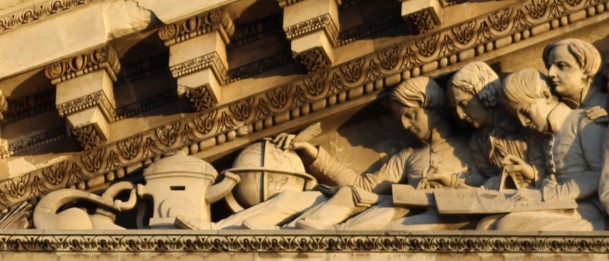
A Amiens et dans la Somme
Après beaucoup de méfiance et bien des hésitations, la mairie d’Amiens fonde, le 15 mai 1817, une société d’encouragement de l’instruction élémentaire dans le département. Plus que l’ennoblissement de l’âme des élèves, pour le recteur, il s’agit,
« en donnant aux enfants de ces ouvriers l’instruction élémentaire, [de les préparer] non seulement à l’habitude de l’ordre et de la subordination que l’on puise dans les écoles d’enseignement mutuel et qu’ils reportent dans les ateliers, mais encore que cela les mette en état de servir plus utilement dans l’intérieur des fabriques comment pouvoir étudier les procédés industriels dont la conservation et le perfectionnement sont si essentiels à la prospérité nationale ».
Pour le recteur, la rapidité d’acquisition est un gage de succès de la nouvelle méthode par rapport à la « méthode simultanée » :
« Qu’une instruction primaire qui enlève pendant des années entières les enfants à un travail nécessaire à la subsistance de la famille devienne pour les pauvres une charge très onéreuse ; mais que l’expérience apprenne au père de famille que quelques mois suffiront pour procurer à ses enfants un avantage dont il a regretté tant de fois dans le cours de la vie de n’avoir pas pu jouir lui-même, on doit espérer qu’il ne balancera pas pour faire un léger sacrifice pour obtenir un résultat important ».
Ce sont principalement des écoles de garçons. Il existe quelques écoles de filles et des cours du soir pour adultes. Elles accueillent surtout des enfants de petits artisans : teinturier, employé d’octroi, cabaretier, contremaître, tailleur, garçon meunier, apprêteur, tonnelier, couturier, serrurier, boucher, fileur, repasseur, ouvrier, chargeur de voiture, menuisier, bouquiniste, allumeur de réverbère, coutelier, relieur, etc.
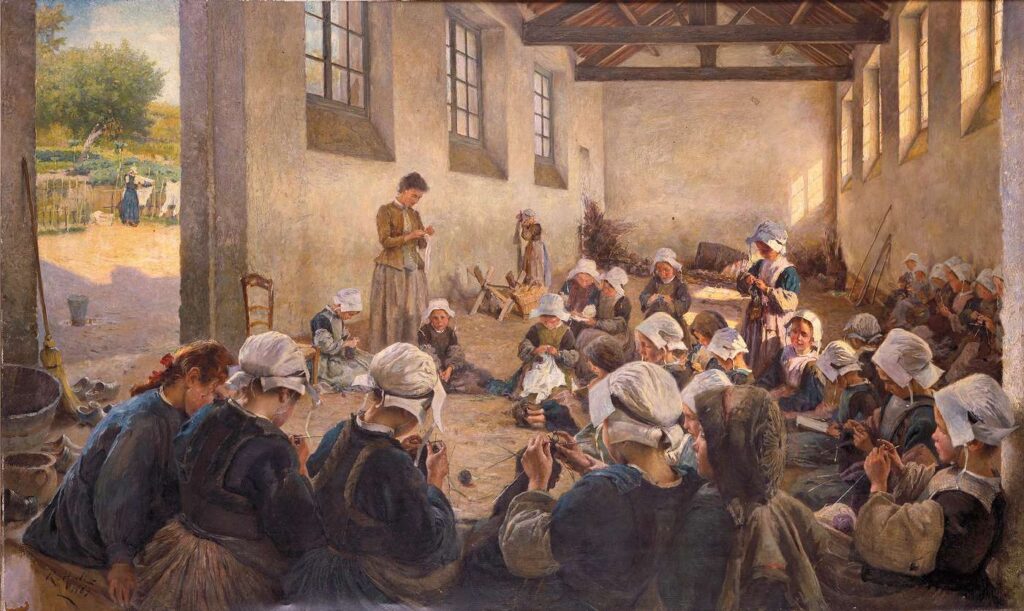
À son apogée, en 1821, l’enseignement mutuel comporte dans le département de la Somme non pas une école mais 25 dont 4 (payantes) pour des filles : près de la moitié sont situées en ville. Il en comportera encore 16 en 1833. Le réseau se réduira considérablement ensuite, toutefois, il ne disparaîtra pas complètement. Les deux dernières écoles d’Amiens fermeront involontairement leurs portes en 1879 et celle d’Abbeville en 1880 : jusqu’à cette date, elle jouera un rôle important dans la préparation des candidats aux examens.
L’école modèle d’Amiens – la première école modèle d’enseignement mutuel de province – prépare les futurs instituteurs à la pratique de l’enseignement mutuel. Elle est fondée le 26 mai 1817. Elle accueille plus de 200 élèves. Dès 1818, 6 instituteurs de la Somme en sortaient. La plupart des maîtres de l’Aisne, de l’Oise et du Pas-de-Calais y font un séjour avant de prendre leur fonction. C’est dire son importance, au point d’ailleurs que lorsque le préfet a créé l’école normale de garçons en 1831, elle s’appelle « école normale primaire d’enseignement mutuel ». Elle servit d’abord d’école d’application : les élèves maîtres devaient se rendre une fois par semaine dans ses locaux afin d’observer et de pratiquer, en s’exerçant, la méthode mutuelle.
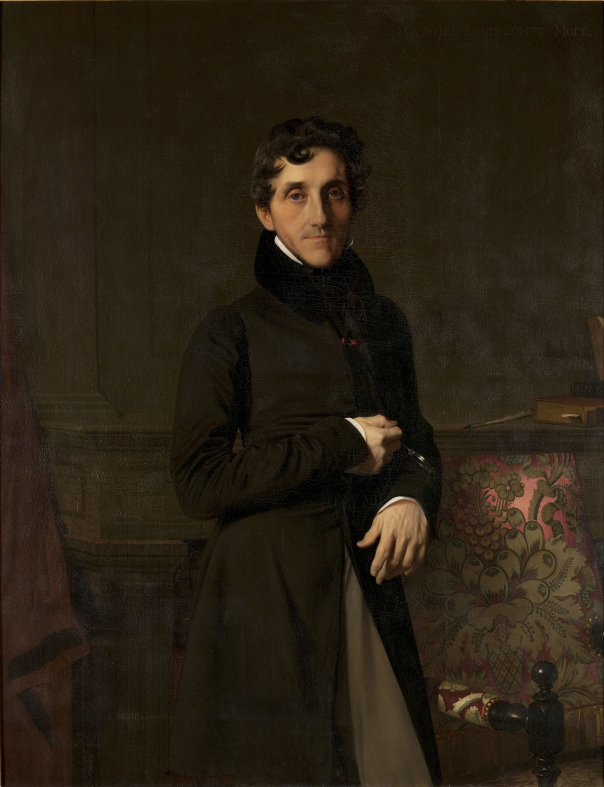
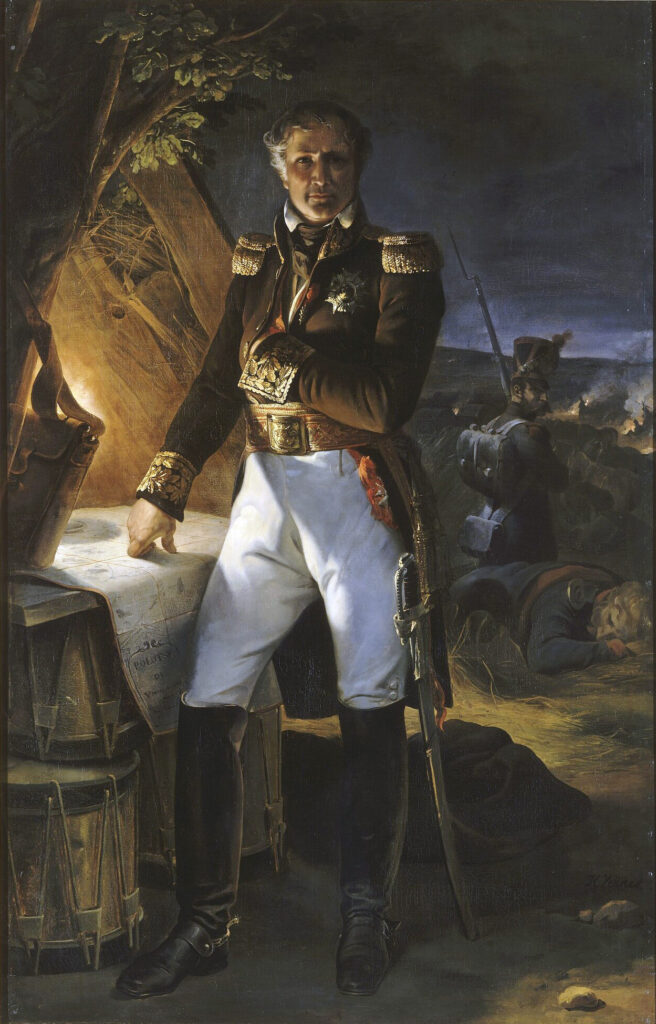

Après les remaniements de 1817-1818, plusieurs membres de la SIE accèdent à des ministères importants : Mathieu Molé (1778-1838) à la Marine, Laurent Gouvion-Saint-Cyr (1764-1830) à la Guerre, Elie Decazes (1780-1860) surtout, à l’Intérieur, ministère dont dépend l’enseignement primaire. Le soutien gouvernemental devient alors systématique.
Le ministre de l’Intérieur soutient la SIE de Paris et ses filiales par des subventions pour fondation ou entretien d’écoles. Il invite les préfets à concourir par tous moyens au développement de la méthode. Les préfets prennent l’initiative de constituer des sociétés locales, ils interviennent auprès des assemblées pour solliciter des subventions.
Des conseils généraux et municipaux, en nombre croissant, votent des crédits pour l’établissement d’écoles mutuelles. L’école fondée, les autorités locales, préfet, maire, la visitent, et président sa distribution des prix. De son côté, la commission d’instruction publique, qui depuis 1815 remplace le Grand Maître de l’Université, décide le 22 juillet 1817 d’établir dans les chefs-lieux des douze Académies de France une école modèle pour l’enseignement mutuel, pépinière des futurs maîtres. Les autres ministres, chacun dans leur sphère, soutiennent la méthode.
Mathieu Molé, chargé de colonies, fonde des écoles d’enseignement mutuel au Sénégal.
En 1818, Laurent Gouvion-Saint-Cyr établit à Paris, dans la caserne Babylone, une véritable école normale militaire d’enseignement mutuel. Chaque régiment de Paris et de province doit y envoyer un officier et un sous-officier qui, de retour après quelques mois de stage, dispenseront à la troupe les bienfaits de l’instruction primaire.
En 1817-1818, l’enseignement mutuel triomphe. Un enthousiasme irrésistible porte la France vers lui. Le réseau des écoles ne cesse de s’étendre. De trimestre en trimestre, toujours plus nombreux, arrivent à Paris les comptes-rendus de la province, dénombrant les écoles et leurs élèves.
C’est un chant de victoire que peut entonner Jomard à la séance de la SIE de janvier 1819. Sur les 81 départements que compte la France, 5 seulement sont dépourvus d’école mutuelle ; les 76 autres groupent 687 écoles, fréquentées par plus de 40 000 élèves. On compte en outre 105 écoles régimentaires, 5 écoles d’adultes, 4 écoles de prisons, 2 ou 3 écoles au Sénégal.
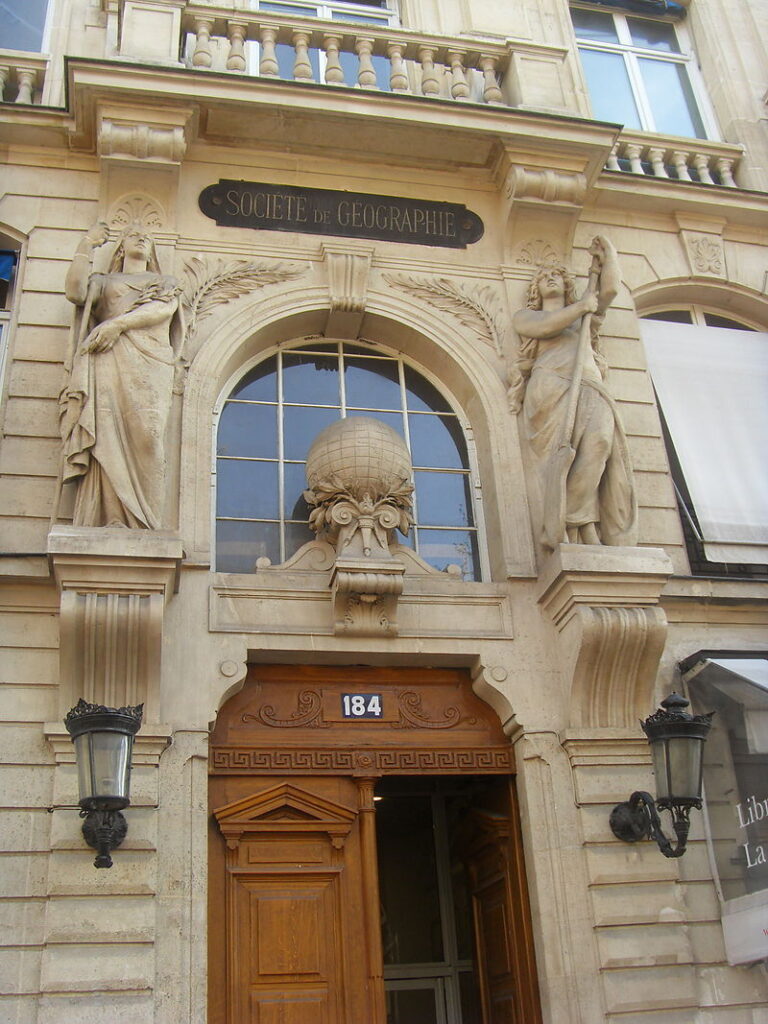
Exemplaire de ce qui devient alors un nouveau paradigme prométhéen d’optimisme scientifique, le 15 décembre 1821, lors d’une réunion à l’hôtel de ville de Paris, est fondée la Société de géographie par 217 personnalités dont les plus grands savants de l’époque, notamment Jomard, Champollion, Cuvier, Chaptal, Denon, Fourier, Gay Lussac, Berthollet, von Humboldt, Chateaubriand. Parmi ses membres illustres, on peut citer également Jean-Baptiste Charcot, Dumont d’Urville, Élisée Reclus et Jules Verne.
La collecte et l’étude des données géographiques de nombreux continents vont permettre à certains membres, comme Gustave Eiffel et Ferdinand de Lesseps, de proposer de grands projets d’infrastructure, notamment le canal de Suez et le canal de Panama.
15. Critiques
Les premières critiques contre l’éducation mutuelle ne proviennent pas de son échec mais de son succès. Le premier « risque » venait du fait que les enfants, ayant appris trop efficacement et trop vite (de 2 à 3 fois plus rapidement), allaient retourner dans la rue trop tôt, n’ayant pas encore l’âge d’aller travailler !
Les enfants n’étaient pas « enfermés » à l’école assez longtemps, et donc l’enseignement mutuel troublait l’ordre social existant. Ainsi entendit-on au sein du Conseil général du Calvados en 1818 :
« Le plus grand service à rendre à la société serait peut-être d’imaginer une méthode qui rendît l’instruction destinée à la classe inférieure et indigente de la société plus difficile et plus longue »…
Le deuxième « risque » était qu’en continuant à utiliser l’enseignement mutuel, ces nouvelles personnes instruites, pour la plupart issues des classes les plus pauvres, deviennent trop intelligentes, trop « éveillées », et commencent à exprimer des revendications politiques ou sociales, et notamment que chacun ait les mêmes droits que les classes sociales les plus aisées.
Imaginez le chaos si l’ordre social est remis en question ! L’urbaniste et sociologue Anne Querrien remarque qu’en effet, une majorité des organisateurs du mouvement ouvrier à l’époque sont issus de l’école mutuelle au sein de laquelle ils avaient bien sûr appris à lire, à écrire, à compter, mais aussi à se faire confiance et à faire confiance à leurs camarades. L’école mutuelle pousse ses élèves à réfléchir, et notamment à réfléchir à l’organisation de la société, société qui leur assignait alors un destin de soumission et d’obéissance.
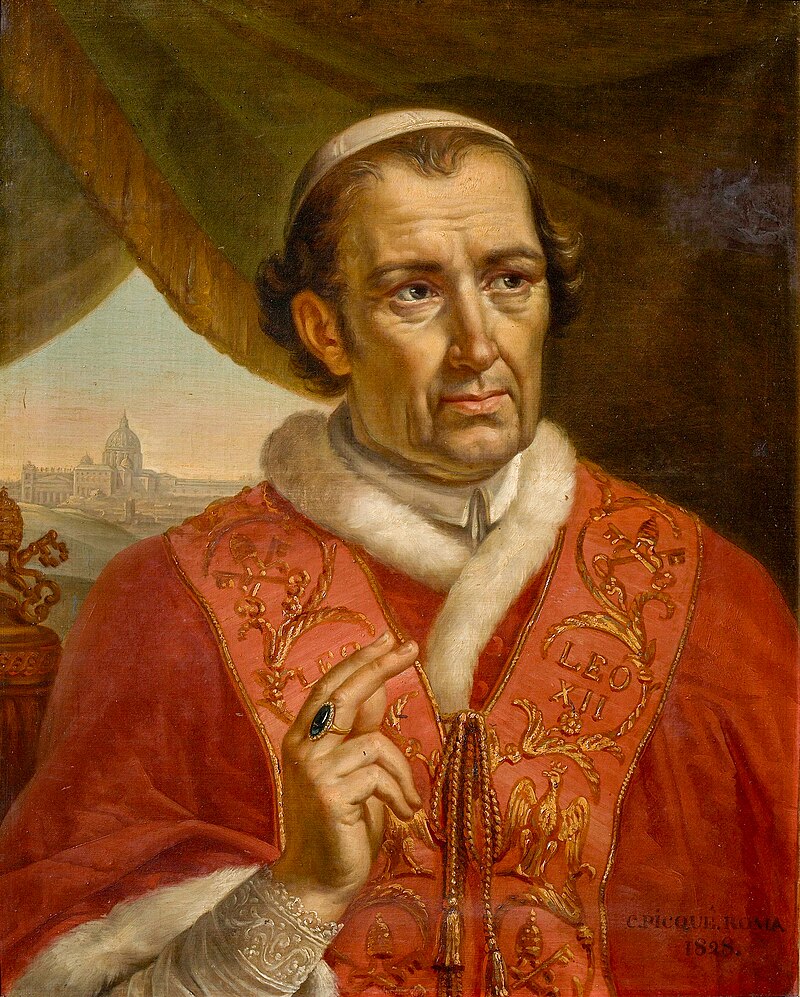

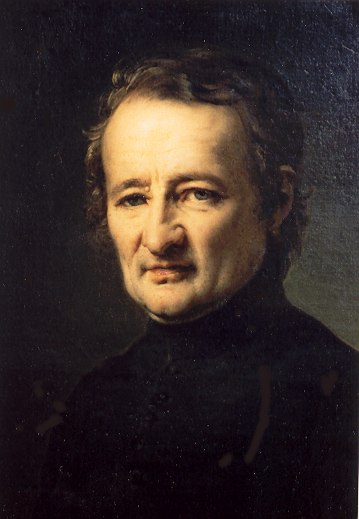
Pour l’influent théologien et homme politique breton, Félicité Robert de Lamennais (1782-1854),
« Les écoles à la Lancaster sont la folie du jour. Toutes les autorités de ce pays, et surtout le Préfet, en sont engouées au-delà de toute expression. La haine pour les prêtres entre pour beaucoup dans cette manie. Le fait est que tout ce qu’il y a de bon dans cette méthode, était pratiqué depuis plus d’un siècle par les Frères des Écoles chrétiennes ; le reste est pur charlatanisme. On parle d’apprendre à lire et à écrire en quatre mois aux enfants : d’abord ce serait un grand malheur, car que faire de ces enfants si bien instruits, et à qui leur âge ne permettrait pas encore de travailler ? En second lieu, rien n’est plus faux que ces résultats merveilleux ».
S’il faut « se prononcer entre l’instruction de l’abbé de La Salle et celle de Lancaster, la question est bien simple ; il s’agit de choisir entre la société et l’anarchie ».
Son frère, le vicaire Jean-Marie de la Mennais (1780-1860) prendra alors la tête de ce qu’il faut bien qualifier de chasse aux sorcières. Il dit :
« L’enseignement mutuel fut introduit en France par des protestants, dans les funestes cent jours. M. Carnot était alors ministre de l’Intérieur ; sous ses auspices, la société d’encouragement, établie pour propager cette méthode, tint sa première séance le 16 mai 1815 ».
Il se démène pour prouver que « la méthode lancastérienne est défectueuse dans ses procédés, dangereuse pour la religion et les mœurs dans ses résultats » et dans une brochure, De l’Enseignement mutuel, publiée en 1819 à Saint-Brieuc, il attaque vigoureusement ce mode d’enseignement.
Il n’est pas faux que la remise en question de l’autorité et de l’ordre établi est en soi inhérente à l’enseignement mutuel. L’école « simultanée » se base sur le postulat que pour transmettre un savoir il faut être diplômé (être le professeur). À l’inverse, au sein de l’école mutuelle, le professeur n’est plus le dépositaire du savoir, chaque élève pouvant expliquer à ses camarades.
Un autre souci pour les élites était lié au fait qu’avec cette méthode, les enfants ne sont plus qu’instruits et non pas « éduqués », qu’aucune éducation morale chrétienne ne leur est transmise.
Enfin, l’enseignement mutuel s’appuyait sur un nombre d’encadrants plus faible, du fait du rôle des élèves comme créateurs, transmetteurs et porteurs de savoirs. Certains ont peut-être eu peur pour leur poste…
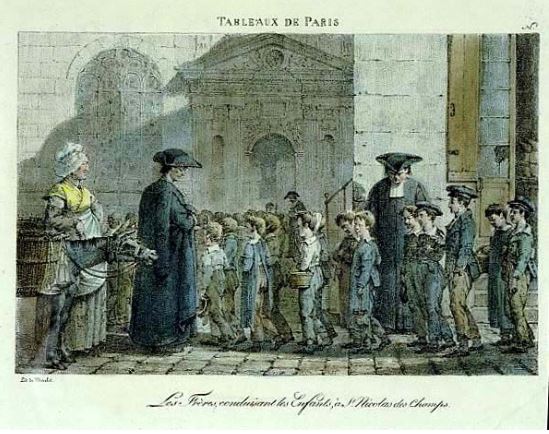
Joseph Hamel, en 1818, dans son rapport à l’Empereur de Russie, répond aux principaux adversaires des mutualistes, les « Frères des écoles chrétiennes », qu’ils ignorent presque entièrement ce qu’ils dénoncent. Hamel rappelle également qu’il y a 40 000 communes à prévoir des écoles primaires et que le nombre d’écoles des Frères ne « s’élève pas à plus de 100 dans le royaume… »
Du côté négatif, ce qui frappe, lorsqu’on examine les incriminations, c’est qu’on dise une chose le matin et son contraire l’après-midi. Le matin on dit que l’enseignement mutuel brouille les esprits en diluant l’autorité des maîtres, l’après-midi on affirme qu’il « militarise » à outrance l’éducation par une structure de commandement totalement hiérarchisée ! Allez comprendre…
Sur la question de la moralité, jamais Lazare Carnot n’aurait cautionné une éducation ruinant l’esprit chrétien et encore moins la notion d’autorité légitime, tout en combattant avec vigueur celle qui en manquait, comme par exemple celle de la Monarchie de droit divin ou du Consulat à vie imposé par Napoléon. De la même façon, le matin on accuse le système mutualiste de ne pas transmettre « la morale » chrétienne, l’après-midi on y voit un complot protestant…
Or, l’élan national en faveur de « la patrie » et des générations futures, a justement réussi à unir, dans un même effort, des personnalités de tout bord politique et religieux. Cuvier (protestant) et Gérando (catholique), tous deux fervents républicains et promoteurs du mode mutuel, ainsi que l’inspecteur général de l’Université, Ambroise Rendu (1778–1860, catholique), participent même à la rédaction de l’ordonnance du 29 février 1816 promulguée par Louis XVIII et le ministre de l’Intérieur, de Vaublanc (1756–1845).
Suite aux pressions massives des congrégations, les enseignants mutualistes Martin, Frossard et Bellot, tous trois protestants, se voient contraints de quitter leur direction d’école. Martin se rendra fort utile dans d’autres pays européens, notamment à Bruxelles où il organise, en 1820, une école mutuelle aux Minimes.
16. Dérive mécaniste ?
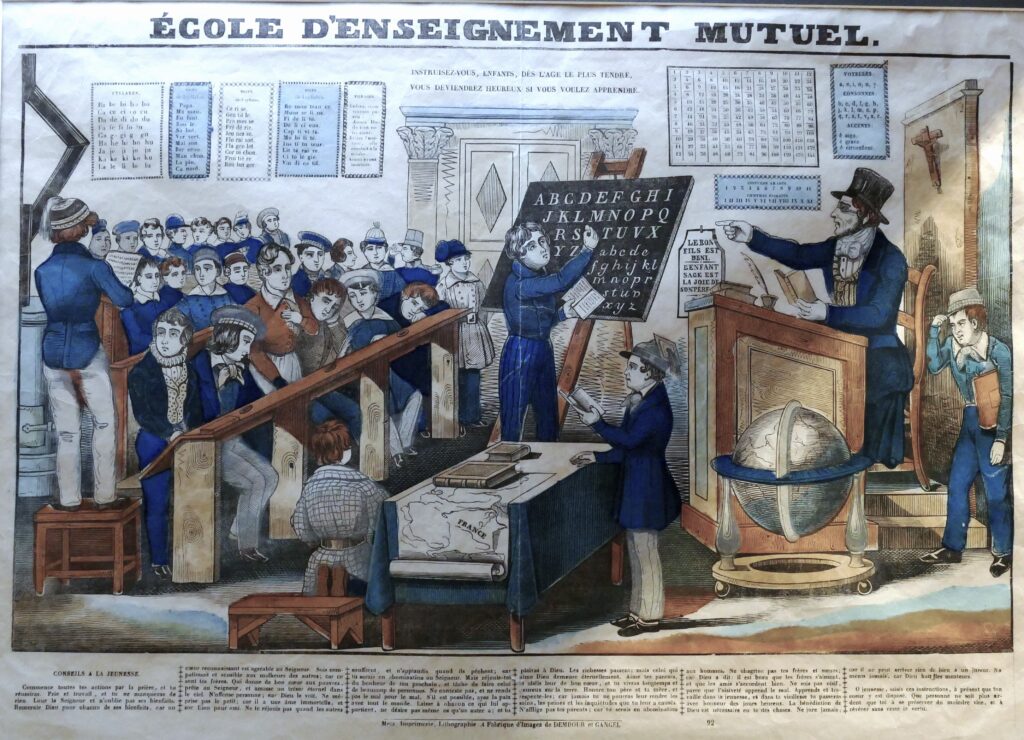
Sans appréhender l’état d’esprit et l’enthousiasme que pouvaient avoir des jeunes polytechniciens pour l’éclosion d’une culture industrielle et les merveilles du machinisme, les défenseurs d’une France cul-terreuse et féodale n’y voient qu’une « vision foncièrement mécaniste », lorsque Jomard compare la méthode mutuelle à une machine, avec ses rouages et ses ressorts, dont le maître n’est qu’un simple opérateur :
« Une fois l’école disposée et garnie de tout le mobilier qui lui est nécessaire, il ne s’agira plus que d’introduire les élèves et le maître, et de mettre ensuite en mouvement tous les ressorts de cette espèce de mécanisme, au moyen des nouvelles pratiques ».
Alors que Victor Hugo y évoquait un « essaim heureux », on accuse Laborde de dérive « mécaniste » lorsqu’il compare le bourdonnement produit par l’activité des élèves dans les écoles mutuelles anglaises au bruit des machines dans les filatures de coton.
La communication, disent-ils, y est « toute mécanique et entièrement hiérarchisée ». Elle ne s’exerce « que du maître ou du moniteur général vers les moniteurs et vers les élèves, non dans l’autre sens. C’est un moyen d’action, non un moyen d’échange. »
Admettons que toute approche pédagogique, peu importe laquelle, érigée en système et postulant qu’il suffit de l’appliquer mécaniquement à une personne humaine, peut faire dans l’horreur. Facile donc d’accuser l’enseignement mutuel de tous les maux dont souffraient, peut-être bien plus, ceux qui l’en accusaient.
A l’école mutuelle, les châtiments corporels sont bannis. C’est une décision courageuse qu’Octave Gréard (1828-1904) ne manquera de souligner :
« C’est l’un des titres des fondateurs des écoles mutuelles à la reconnaissance publique d’avoir proscrit les peines corporelles, férules et fouets, qui étaient encore en usage, et l’on ne saurait trop leur savoir gré d’avoir cherché à remplacer dans le cœur des élèves le sentiment de la crainte par le sentiment de l’honneur, ou, comme disait M. de Laborde, le sentiment de la honte bien administrée. »
Connaissant l’immense bonheur des milliers d’enfants qui ont accédé rapidement à un minimum d’instruction publique et qui ont connu la joie indescriptible d’instruire leurs camarades, on ne peut que soupçonner la plume des congrégations jalouses derrière ce poème se désolant faussement du malheur des pauvres petits :
« Ce système, dit l’un, né de l’anglomanie,
Contraste horriblement avec notre génie.
Là, tout est mécanisme et nos tristes enfants
Semblent une machine, au milieu de leurs bancs ;
Leur discipline absurde, et sans doute funeste,
Règle même les pas, l’attitude ou le geste :
On peut, dès aujourd’hui, prophétiser le sort
De ce peuple automate ainsi mu par ressort ».
17. Mort de l’enseignement mutuel en France
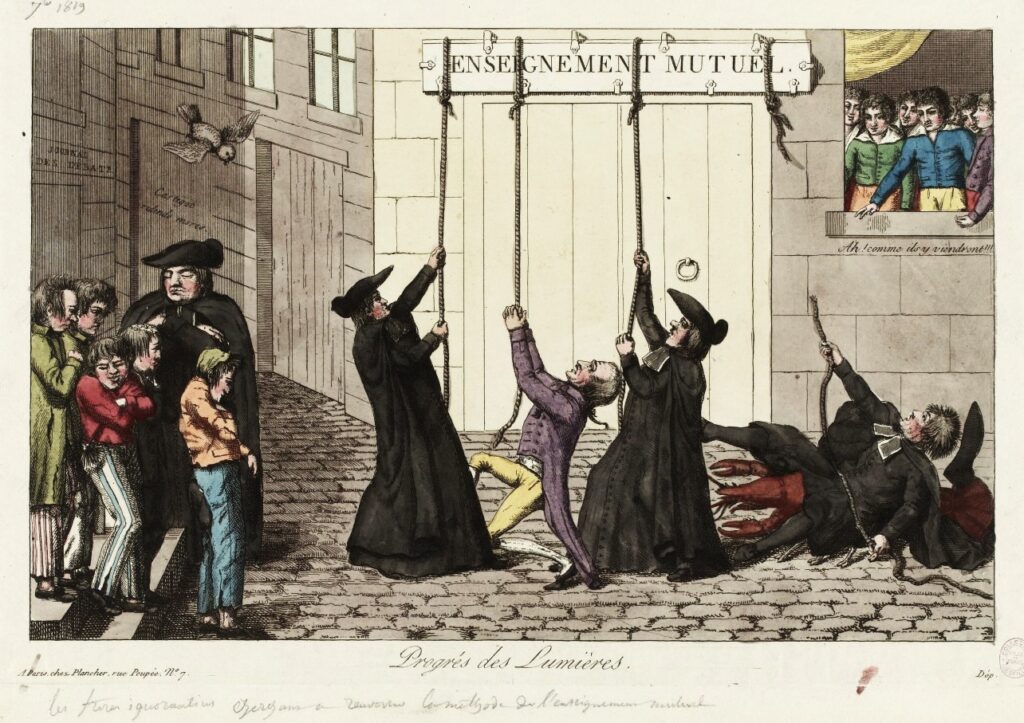
En 1815, après Waterloo, Louis XVIII, qui avait fui, revient le 8 juillet 1815. Contrairement à son frère, le futur Charles X, chef des ultra-royalistes, il a pleinement conscience que l’on ne peut effacer les pages de l’histoire de la Révolution. Il constate que la France ne peut plus redevenir un pays de « sujets » et qu’elle est devenue une Nation. D’où la « Charte constitutionnelle » qu’il promulgue, et qui a valeur de constitution. Dans le même esprit, face à la popularité de l’enseignement mutuel, il lui accorde ses faveurs (subsides, création d’écoles modèles, protection du ministère de l’Intérieur).
L’enseignement mutuel va rapidement perdre ses protecteurs, la commission ministérielle créée par le décret du 27 avril ne survivant pas à la chute de Napoléon en juin 1815.
Dès l’automne 1816, alimentées par les congrégations, les critiques pleuvent. Le Grand Aumônier de France, cardinal de Talleyrand-Périgord, archevêque de Reims (ville natale de Jean-Baptiste de La Salle…), s’adressa de son côté au Roi pour lui faire connaître les alarmes des catholiques.
Si, en 1820, la SIE possède déjà un réseau de 1 500 écoles mutuelles groupant, grâce à une audacieuse pédagogie collective, plus de 170 000 élèves, le mutualisme subit les coups de bélier des ultras qui l’estiment trop libéral, trop favorable à l’autonomie des enfants et incapable « d’élever la jeunesse dans des sentiments religieux et monarchiques ».
L’enfant sortant de cette école, disent-ils,
« est un perroquet savant, sans idée religieuse, sans valeur morale, plus dangereux que l’ignorant pour l’ordre politique et social puisque l’instruction a développé en lui de nouveaux besoins, toujours prêt à s’engager dans de nouvelles scènes de révolution ou de déchristianisation. Ah, Carnot, le conventionnel régicide, le patron de l’enseignement mutuel, savait ce qu’il préparait en l’introduisant en France par le décret de 1815 ! »
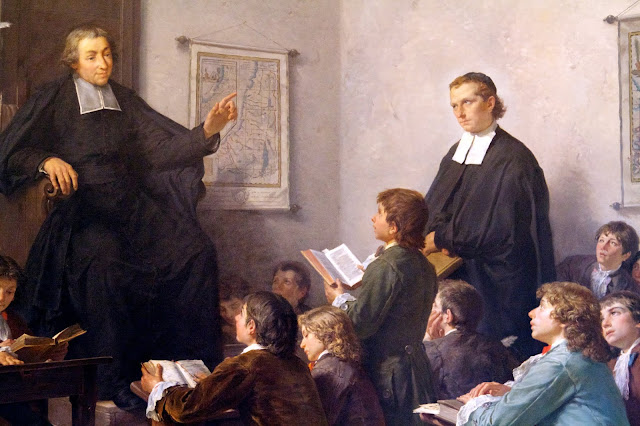
Partisan farouche de l’ordre et soupçonnant un vaste complot protestant contre le Vatican, le pape Léon XII, le « pape de la Sainte-Alliance » décide dans Quod Divina Sapientia, sa bulle papale du 28 août 1824 (art. XXVII, 299), que
« les écoles publiques d’instruction mutuelle seront supprimées et abolies dans tous les États pontificaux. Les évêques poursuivront ceux qui continueront à utiliser cette méthode d’enseignement ou qui tenteront de l’introduire dans leurs diocèses ».
Comme on l’a dit plus haut, en France, l’enseignement mutuel est perçu comme une agression par les congrégations religieuses qui pratiquent « l’enseignement simultané », codifié dès 1684 par Jean-Baptiste de La Salle (1651-1719) pour les Frères des Écoles Chrétiennes (Latin : Fratres Scholarum Christianarum ; Italien : Fratelli delle Scuole Cristiane, en abrégé FSC) : classes par âge, division par niveau, places fixes et individuelles, discipline stricte, travail répétitif et simultané supervisé par un maître inflexible.
Et les mérites des écoles des FSC et de « l’enseignement simultané », confirmés depuis leur création, sont considérés en totale opposition avec ceux de l’enseignement mutuel, la « manie du moment », et considéré comme l’œuvre de « charlatans » spéculant sur l’enseignement primaire.
Anticipant la bulle papale par l’ordonnance d’avril 1824, l’enseignement mutuel est placé chez nous sous la stricte tutelle de l’Église traditionnelle qui s’empare de l’ensemble de la question éducative. En août, donc après la bulle de Léon XII, un ministère des « Affaires ecclésiastiques et de l’Instruction publique », dont l’appellation dit bien le retour de l’Eglise aux affaires, est créé. L’accession de Charles X, ne fera qu’aggraver cette situation. L’Église d’alors aime les Lumières, mais avant tout celles des bougies…
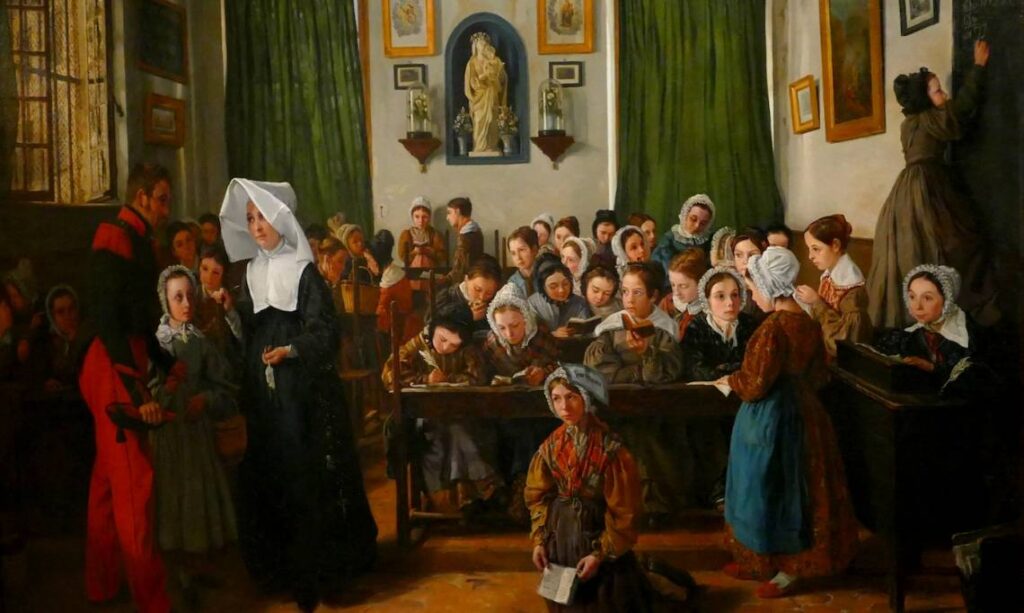
Dès lors, le bilan de la scolarisation tourne au drame. En 1828, sur les 39 381 communes :
- environ 24 000 sont pourvues d’écoles de garçons, recevant 1 070 000 enfants ;
- le nombre des jeunes filles qui fréquentent les écoles primaires est au plus de 430 000 ;
- 15 381 communes sont sans écoles de garçons ;
- et peut-être 20 000 sans écoles de filles ;
- 1 680 000 garçons et 2 320 000 jeunes filles, soit 4 millions au total, ne fréquentent aucune école.
Malgré une embellie entre 1828 et 1829, le mutuellisme est rejeté, ses écoles fermées les unes après les autres (leur nombre diminua des trois-quarts par rapport à 1820) bien que le poids électoral des ultras diminue d’élections en élections. Cependant, les éducateurs du peuple résistent.
Dans les années qui suivent la révolution de 1830, encore plus de 2 000 écoles mutuelles fonctionnent, principalement dans les villes, en concurrence avec les écoles confessionnelles promues par le régime. Officiellement, l’école mutuelle n’était pas garante de la moralité et on affirmait qu’elle était « industrielle », inhumaine.

Arrive alors le fameux « moment Guizot ». Alors qu’il avait milité initialement pour le développement de l’enseignement mutuel au sein de la SIE, François Guizot (1787-1874), à partir de 1832 ministre de l’Instruction publique de Louis-Philippe, donnera le coup de grâce en France à l’enseignement mutuel en faisant entériner le mode simultané comme unique méthode pédagogique officielle. Les écoles adoptant l’enseignement mutuel ne sont alors plus subventionnées, elles ne reçoivent plus aucun soutien du gouvernement ni de l’Église. Devant les difficultés matérielles, une majorité des élèves admis gratuitement jusqu’alors doivent payer une rétribution. Beaucoup de parents, dans le besoin, les retirent pour les mettre à l’école gratuite des Frères ou des Sœurs qui vient d’ouvrir ses portes. L’Église calomnie, jette le doute sur la moralité des maîtres, s’efforce d’éloigner de l’école « du Diable » les enfants des familles catholiques, persécute et menace de les écarter du catéchisme et de la communion. Elle veut briser l’enseignement mutuel. Les maîtres, pour la plupart, abandonnent la méthode pour se rallier à l’enseignement simultané. Plus d’élèves, plus de maître, les écoles mutuelles disparaissent peu à peu.
C’est encore Guizot qui donne le dernier coup de marteau pour clouer le cercueil de l’enseignement mutuel en créant en 1867 l’École normale des instituteurs pour former les futurs professeurs de l’école de Jules Ferry à la méthode simultanée.
Le jeune Hippolyte Carnot adhère lui aussi à la SIE afin de renouer, post mortem, avec son père. Il tentera en 1847, lorsqu’il est ministre de l’Instruction publique sous la IIe République, de faire renaître cet enseignement mutuel que son père Lazare Carnot chérissait, mais, bien que son œuvre fût grande, ses ennemis furent nombreux et son mandat fort court.
18. Conclusion
L’enseignement est en crise. Le dossier La désintégration contrôlée de l’éducation – Ce que tout parent et enseignant devrait savoir (S&P, mars 2023) documente en détail comment tout ce qui a été en grande partie accompli par Lazare Carnot et son fils Hippolyte, repris bien sûr par la suite, notamment dans le plan Langevin-Wallon, a été systématiquement mis en pièce par les nouvelles congrégations de notre temps, adorateurs du veau d’or : l’oligarchie financière, transhumaniste et décadente, après avoir conduit le monde au bord du gouffre, toujours déterminée à sauver ses privilèges en organisant la ruine physique et morale de l’humanité.
Pour reconstruire une instruction digne de ce nom, nous en sommes convaincu, l’éducation mutuelle, sous condition de l’adapter à notre époque et de ne pas en faire un système déshumanisant, est une piste extrêmement prometteuse. Plusieurs pays africains ne nous ont pas attendu. Bien que dépourvus de moyens suffisants, ils s’en inspirent déjà. Il ne s’agit donc nullement d’une relique du passé, mais bien un outil concret pour construire l’avenir.
En France, Vincent Faillet, un jeune professeur de SVT, docteur en sciences de l’éducation et de la formation en région parisienne, dont le travail est évoqué dans cette vidéo, semble bien décidé à ouvrir le dossier :
19. Quelques ouvrages et textes consultés
- François Arago, Biographie de Gaspard Monge, lue à l’Académie des sciences, 1846.
- Joseph Hamel, L’enseignement mutuel, Paris, 1818.
- John Franklin Reigart, The Lancastrian System of Instruction in the schools of New York City, Teachers College, Columbia University, 1916.
- Sylviane Tinembart, Edward Pahud, Une innovation pédagogique, le cas de l’enseignement mutuel au XIXe siècle. Editions Livreo-Alphil, 2019, Neuchâtel, Switzerland;
- Bruno Poucet, Petite histoire de l’enseignement mutuel : l’exemple du département de la Somme, Carrefours de l’éducation, N° 27, 2009/1, pages 7 to 18;
- Michel Chalopin, L’enseignement mutuel en Bretagne, Presses Universitaires de Rennes, 2011; (thèse de 2008, en format pdf);
- M. Gontard, Un aspect des luttes de partis en France au début de la Restauration : la question de l’enseignement mutuel, Revue d’Histoire du XIXe siècle – 1849, Année 1953, pp. 48-63.
- Dell Upton, Lancasterian Schools, Republican Citizenship, and the Spatial Imagination in Early Nineteenth-Century America, Journal of the Society of Architectural Historians, Vol. 55, No. 3 (Sep., 1996), pp. 238-253,University of California Press;
- Alexis de Garaudé, Manuel de l’enseignement mutuel et populaire de la musique, Paris, 1854;
- Anne Querrien, L’école mutuelle – Une pédagogie trop efficace?, Les Empêcheurs De Penser En Rond, 2005.
- Claire Giordanengo, La grande vogue de l’enseignement mutuel, Hypotheses, Bibliothèque Diderot de Lyon;
- Jacques Cheminade, Dino di Paoli, Claude Albert, La science de l’Education républicaine, le secret de Monge et Carnot: Polytechique et les Arts et Métiers, Campaigner Publications, Paris, 1980;
- René Girard, Carnot et l’éducation populaire pendant les Cents Jours, Paris, 1907.
- Michael Werner, Musique et pacification sociale, missions fondatrices de l’éducation musicale (1795-1860) « , Gradhiva (N° 31/2020);
- Rémi Dalisson, Hippolyte Carnot – 1801-1888, La liberté, l’école et la République, CNRS, Paris, 2019;
- Renaud d’Enfert, Jomard, Francœur et les autres… Des polytechniciens engagés dans le développement de l’instruction élémentaire (1815-1850), Bulletin de la Société des amis de la Bibliothèque et de l’Histoire de l’École polytechnique (SABIX), Paris, 2014.
- Karel Vereycken, Le combat républicain de David d’Angers, la statue de Gutenberg à Strasbourg, Argenteuil, juillet 2023.
- Groupe éducation de S&P, La désintégration contrôlée de l’éducation. Ce que tout parent et enseignant devrait savoir, Clichy, mars 2023;
- Vincent Faillet, La métamorphose de l’école, quand les élèves font la classe, Publishroom Factory, Paris, 2020.
- Radio France: A la découverte de l’enseignement mutuel, Paris, 7 mai 2017.
- Karel Vereycken, Hippolyte Carnot, père de l’éducation républicaine moderne, août 2023.
Hippolyte Carnot, father of modern republican education
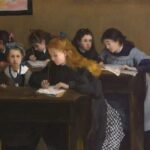
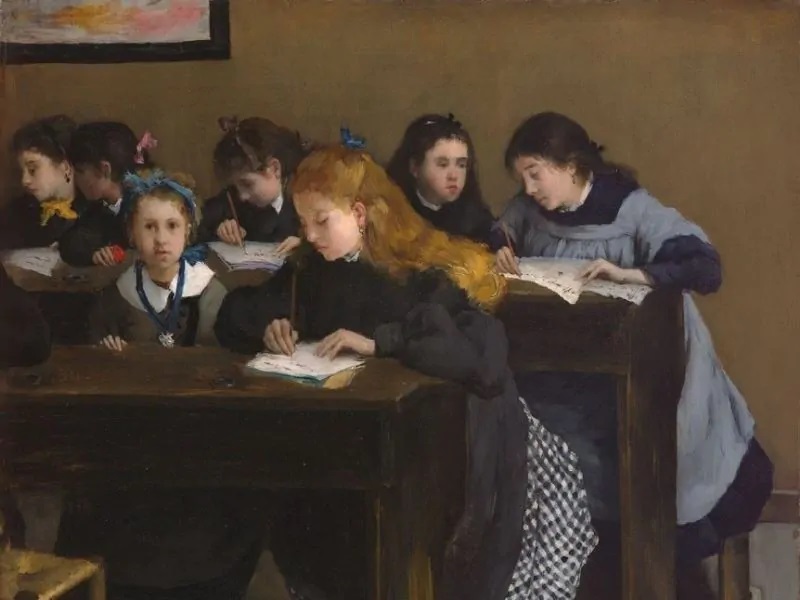
Table of contents
- Introduction
- In the storm
- From charity to universal schooling
- Malebranche and the Oratorians
- The Revolution of the Mind
- The Committee of Public Instruction (1791)
- Condorcet and the « American Party
- The « Condorcet » Plan
- The battle under the Convention (1792-1795)
- Lazare Carnot under Les Cent-Jours (The Hundred Days)
- Carrying on the torch
- Lazare Carnot’s exile
- Hippolyte with Abbé Grégoire
- Like Schiller, patriot and citizen of the world
- The Revolution of 1830
- Minister of Public Instruction under the Second Republic
- Hippolyte’s Carnot’s reforms
A. Nursery school
B. Primary school
C. Explanatory memorandum to the School Act of June 1848
D. Teachers to enlighten the rural world
E. Secondary education
F. High Commission for Scientific and Literary Studies
G. A School of Administration
H. Lifelong education for all
I. People’s libraries
J. Fine arts, hygiene and gymnastics on the program
K. Citizen Concord - Conclusion
- Appendix: works by Hippolyte Carnot
- Short list of books and articles consulted.
« The tree you are planting is as young as the Republic itself (…) It will spread its branches over you, just as the Republic will spread over France the benefits of Popular Instruction.
« Hippolyte Carnot, Memorial (1848), dossier 13.

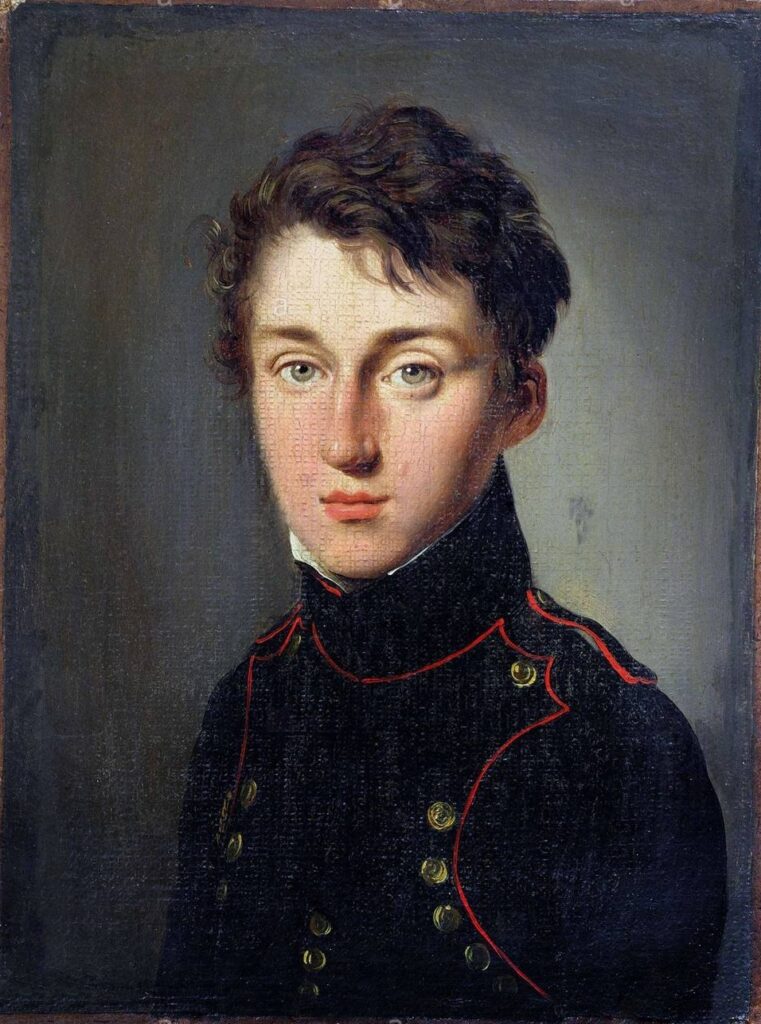

1. Introduction
Hippolyte Carnot (1801-1888) had neither the glory of his father Lazare Carnot (1753-1823), the « Organizer of Victory » of Year II, nor the renown of his brother, the inventor of thermodynamics Léonard Sadi Carnot (1796-1832), nor the tragic fate of his son, François Sadi Carnot (1837-1887), President of the Republic assassinated by an anarchist in Lyon.
History retains almost exclusively his magnificent « Memories on Lazare Carnot by his son », in which he recounts the actions, ideas and life of his father, the « great Carnot », scientific mind, poet, fervent republican and Minister of War.
Hippolyte remains little-known, despite the fact that his long life (87 years), slightly longer than Victor Hugo‘s (83 years), spans almost an entire century (1801-1888), and that his work and influence are considerable.
As is amply demonstrated by « Hippolyte Carnot et le ministère de l’Instruction publique de la IIe République » (PUF, 1948), written by his son, the physician Paul Carnot (1867-1957), he was much more than a mere observer or commentator on events.
2. In the storm
The 19th century was a period of profound change. The flame of hope kindled by the American and French Revolutions, the ideal of liberty, fraternity and emancipation of individuals, peoples and sovereign states alike, proved unquenchable, and was affirmed and extended throughout the 19th century. The long march towards a new paradigm was fraught with pitfalls. Changes took place slowly, against a backdrop of brutal crises and violent ruptures.

During his lifetime, Hippolyte Carnot (1801-1888) was directly or indirectly involved in :
Two Empires:
1803-1814: First Empire under Napoleon Bonaparte
1852-1870: Second Empire under Napoléon III
Three Monarchies:
1814-1815: First Restoration under Louis XVIII
1815-1830: Second Restoration under Charles X
1830-1848: July Monarchy under Louis-Philippe, Duc d’Orléans.
Two Republics:
1848-1852: Second Republic
1870: Third Republic
Three Revolutions expressing popular republican fervor:
1830 (Trois Glorieuses) ;
1848 (uprisings) ;
1871 (Commune).
In an ever-changing environment, through revolutions, coups d’état, monarchies, empires or republics, wars and trials, the man who was (too) briefly Minister of Public Instruction in 1848, a friend of Victor Hugo and Jules Ferry, Hippolyte was a nation builder and an inspiration.
Philosopher and journalist, memoirist and minister, Freemason and believer, political exile and member of parliament, senator and member of the Académie, he took part in all the battles for public and private freedoms, laid the foundations for teacher training and free, compulsory schooling, including kindergarten, created the forerunner of the ENA and defended the most advanced causes (schooling for girls, universal suffrage, the fight against slavery and the abolition of the death penalty).
Rémi Dalisson, in a fascinating and richly documented biography entitled « Hippolyte Carnot 1801-1888. La liberté, l’école et la République », published by the French CNRS in 2011, with supporting evidence, points out that « the vulgate of Jules Ferry as the inventor of the republican and secular school has been widely debunked ».
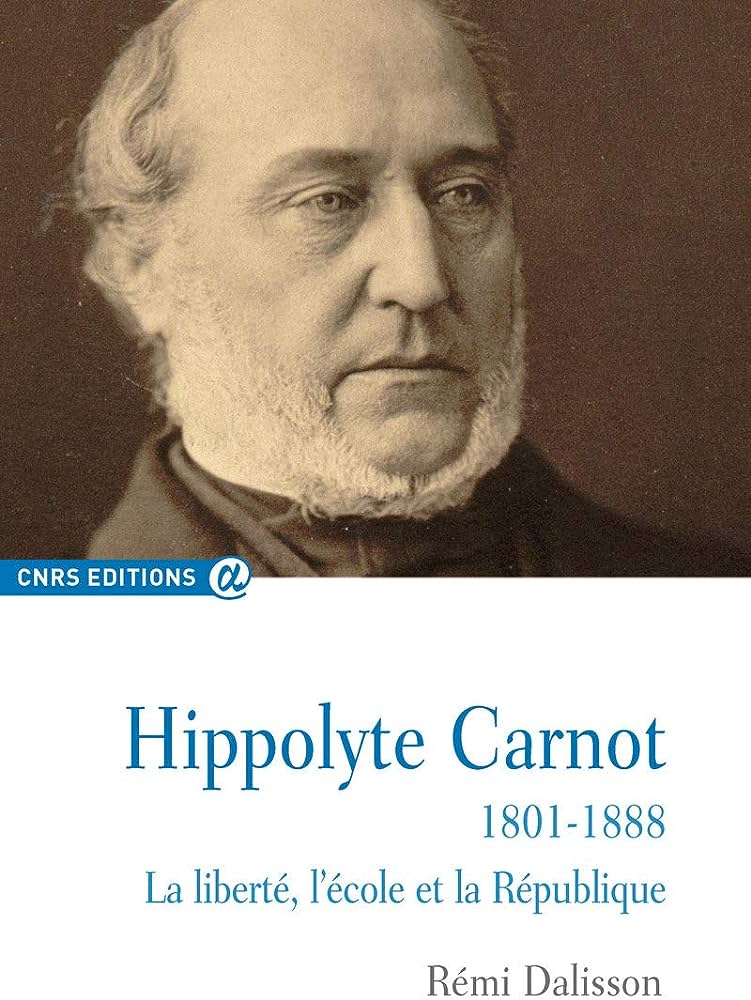
Given that Hippolyte‘s name, let alone his work, is nowhere to be found on the Ministry’s website, the author laments that « few people, including those at the Ministry of Education, pay tribute to the role and personality of Hippolyte Carnot« .
The anthologies of founding texts and speeches of the republican school, which have proliferated in recent years, systematically forget him.
« It is therefore an injustice and an oversight that we are repairing by tracing the life and work of Hippolyte Carnot, which go far beyond his educational projects and achievements. Through his stature, his training, his career, his ideas, his writings and his battles, this man of many talents will enable us to retrace the history of the construction of the school and therefore of society in the 19th century (…) And as this question refers to the political, social, even economic and cultural question of the nation, and as the minister was involved in all the philosophical battles of his century (…) it is largely the history of a century that will be evoked (…) ».
The full text of this magnificent biography is available free of charge on the Internet, and we have drawn heavily on it to write this text.
3. From charity to universal schooling
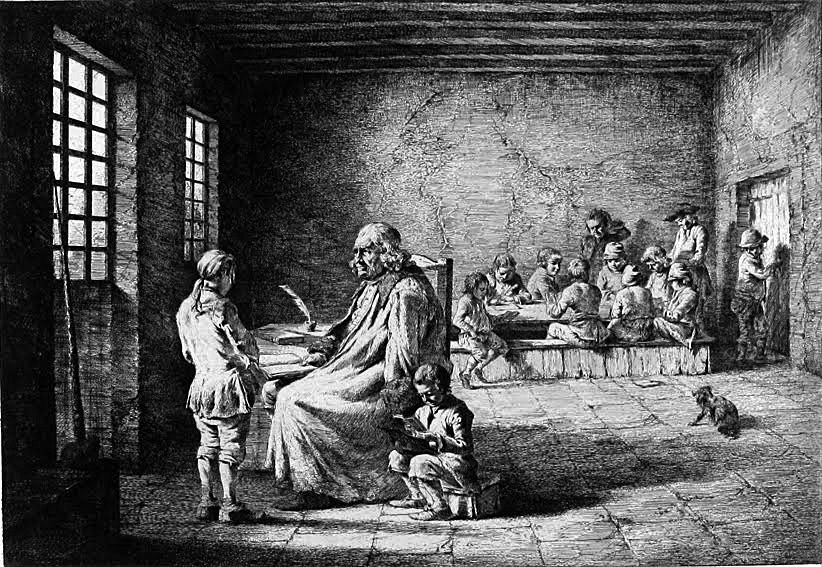
In order to fully appreciate the fundamental contribution of Lazare Carnot‘s ideas, and of their initial implementation by his son Hippolyte, a brief history of schooling in our country is in order.
Educating a handful of more or less talented children? We knew how to do it, especially since the tasty advice of the great Renaissance pedagogues (Vittorino da Feltre, Alexandre Hegius, Erasmus of Rotterdam, Juan Luis Vivès, Comenius, etc.). But organizing compulsory, secular and free education for an entire nation, boys and girls alike, remained an enormous challenge.
And as the following chronology shows, the road to universal schooling was strewn with many pitfalls.
In France, from the 16th century onwards, the royal state entrusted the Catholic Church (Jesuits, Oratorians and Brothers of the Christian Schools) with the task of educating state officials and the children of the nobility: only wealthy families could afford to pay a tutor for their own children, while the others, often described as « not suited to study », remained essentially illiterate.
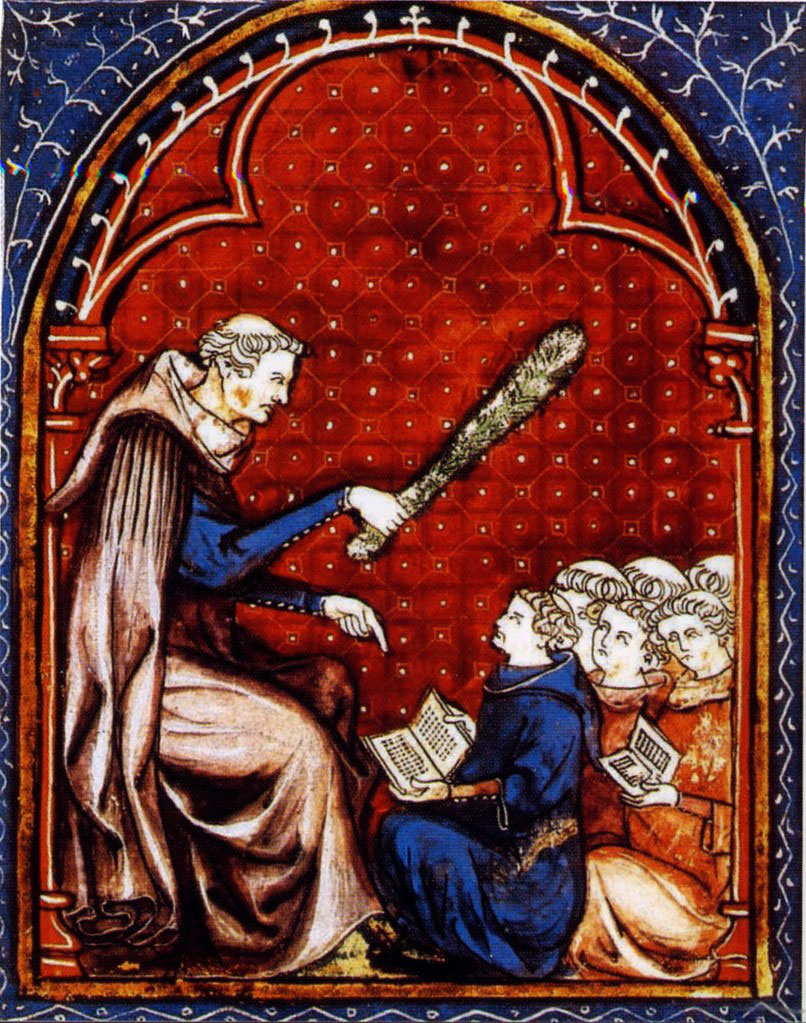
In the 17th century, holy men, moved by the great misery of the children of the people, founded teaching orders to take in orphans and abandoned children free of charge. Their teaching was primarily religious, but they also provided them with food, basic education and basic writing and arithmetic skills. In the 18th century, women’s congregations took in poor girls in the same way.
Whatever his real motives, in 1698, following the revocation of the Edict of Nantes in 1685, Louis XIV ordered every village community or parish to open a school, whose teacher had to be a Catholic priest. This was the first time the state considered providing education for rural children.
Literacy figures at the end of the Ancien Régime show the scope and limits of the work accomplished. At that time, an estimated 37% of French people were literate enough to sign their marriage certificate, compared with 21% a century earlier. Female education progressed slowly, with around a quarter of women literate, many of them only in very basic terms. There were major disparities between town and country.
4. Malebranche and the Oratorians
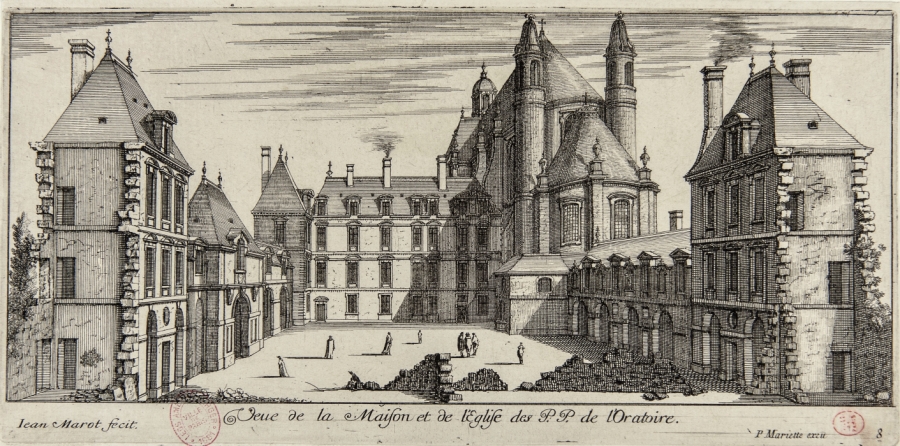
Among the congregations, the Oratorians have been the exception since 1660, under the influence of the philosopher and theologian Nicolas Malebranche (1638-1715), who became its director. Breaking away from the Aristotelianism of the Jesuits and the dualism advocated by René Descartes, Malebranche, who had become an honorary member of the Académie des Sciences, was to be won over to the optimistic vision of the great German scientist Wilhelm Gottfried Leibniz through a sustained exchange of letters. Reconciling science and faith, on the metaphysical level his god is a wise and reasonable God, always respecting his essence and the laws of order he generates. His perfection lies above all in his function as legislator, identified with wisdom or reason, rather than arbitrary power.
Two examples demonstrate the excellence of their teaching: Gaspard Monge and Lazare Carnot, two great scientific minds and future co-founders of the Ecole Polytechnique. Convinced that the political, economic and industrial future of the Republic depended on it, they led the fight to ensure that the best possible education was available to all, not just the privileged few of whom they were a part.
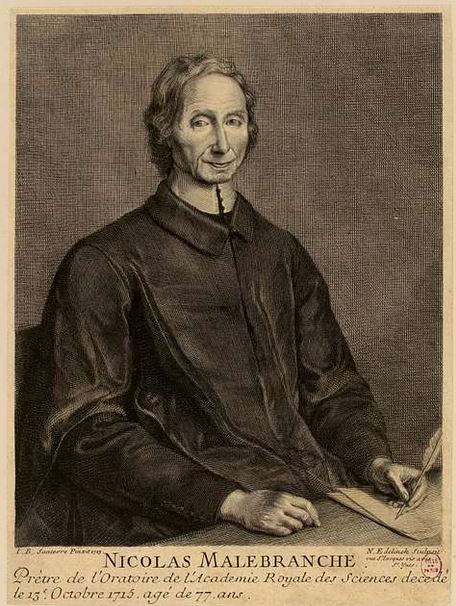
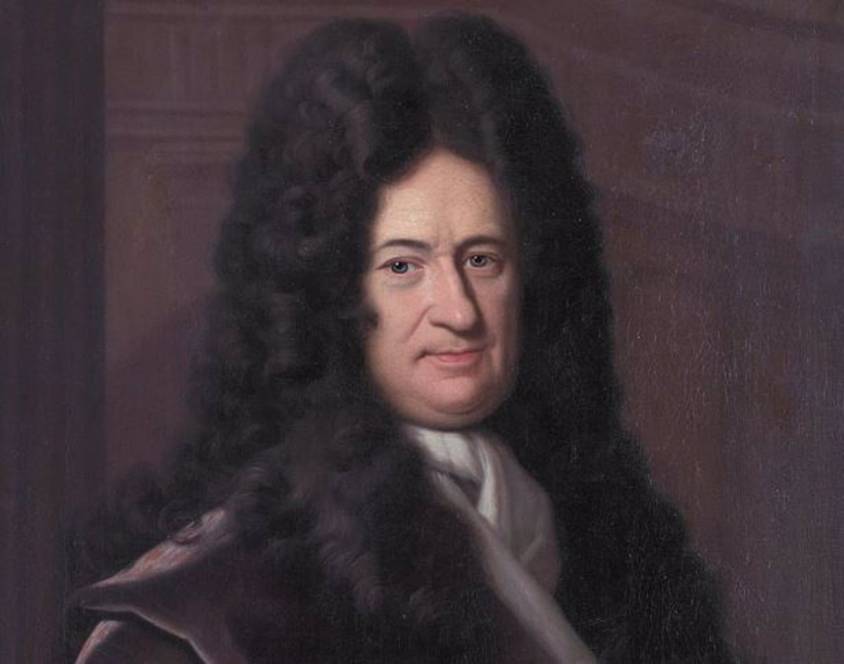
The son of a Savoyard merchant, Gaspard Monge (1746-1818) studied at the Collège des Oratoriens in his native Beaune. From the age of 17, he taught mathematics at the Oratoriens de Lyon, then in 1771, mathematics and physics at the École de Génie established in Mézières. That same year, he came into contact with the physicist Jean Le Rond d’Alembert (1717-1783) and corresponded with the mathematician Nicolas de Condorcet (1743-1794), who encouraged him to submit four dissertations, one in each of the fields of mathematics he was studying at the time. It wasn’t long before his talents as a geometrician came to the fore: at the Ecole de Génie, he invented « Descriptive Geometry », which became part of the school’s curriculum and was essential to the industrial revolution just around the corner…
As for the future General Lazare Carnot (1753-1823), son of a Burgundian notary, after studying at the Oratoriens d’Autun (1762), he too entered the École du Génie de Mézières (1771), where he was taught by Gaspard Monge.
5. The Revolution of the Mind (1789)
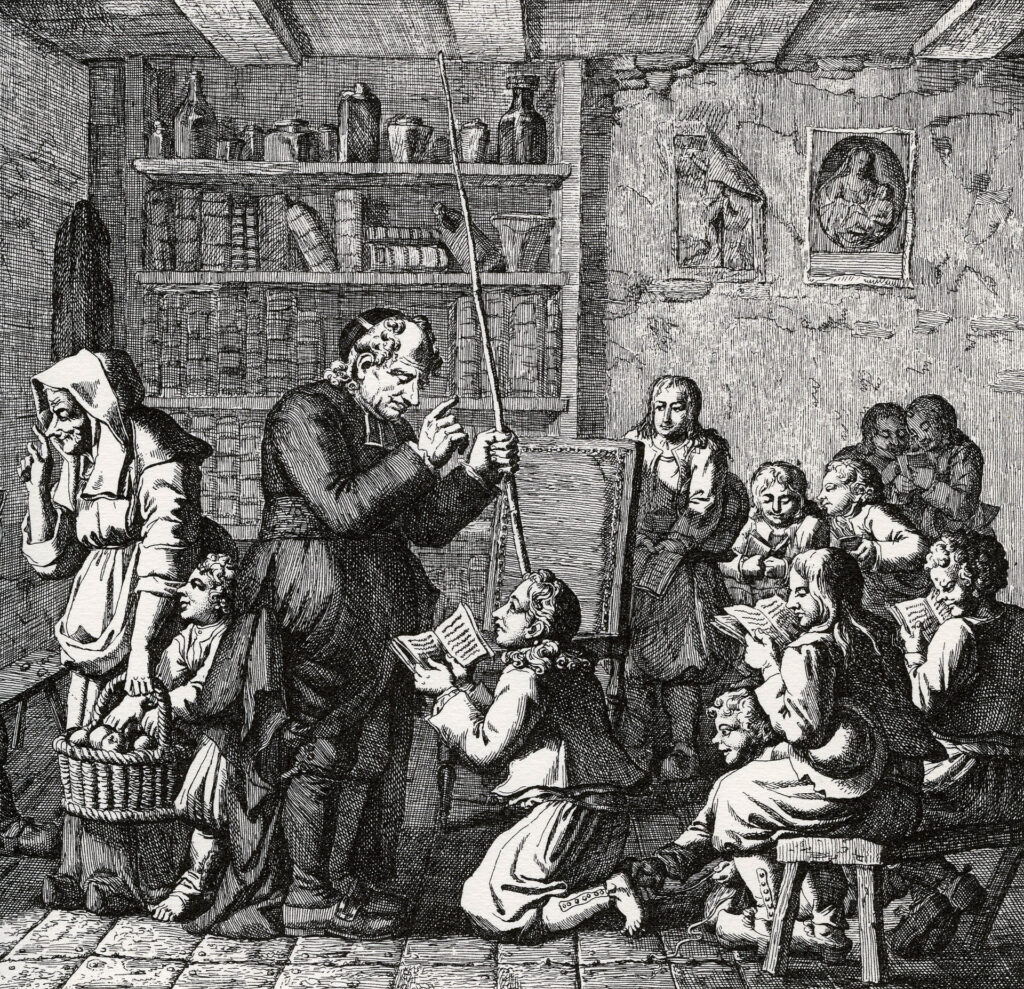
In 1789, the Revolution turned the situation upside down. On February 13, 1790, all religious corporations and congregations were abolished by decree, and religious were ordered to swear an oath to the revolution. The all-powerful Church was totally challenged, and the few education that existed collapsed.
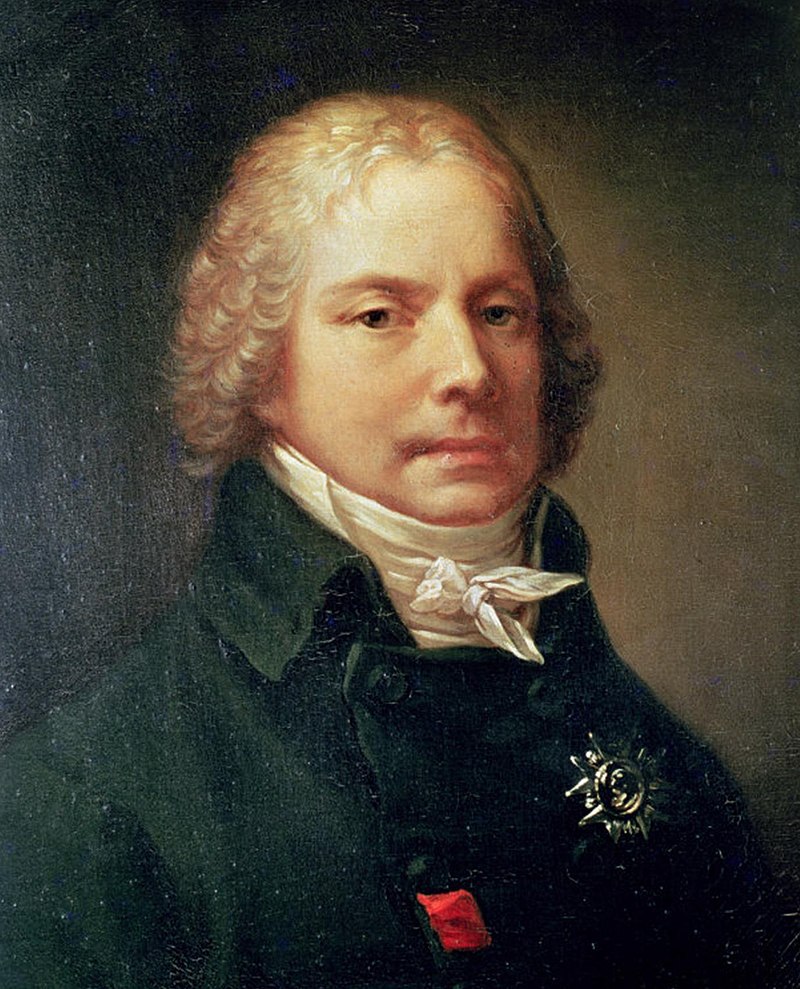
In a break with the Ancien Régime, the Constitution of 1791 asserted that « public instruction common to all citizens shall be created and organized. » A report and draft law were presented by Talleyrand (1754-1838) on September 10, 1791.
His Rapport sur l’Instruction publique, drafted in reality with contributions from some of the greatest scientists of the time (Condorcet, Lagrange, Monge, Lavoisier, La Harpe), represented a real break with the way education had been conceived under the Ancien Régime. It poses the question of public education in new terms, both in terms of principle (public education is presented as a political, social and moral necessity, and therefore as something the State must guarantee to its citizens) and in terms of form.
The plan encompassed the entire national education system, which was organized on four levels and whose establishments were distributed across the country according to administrative divisions. It laid the foundations for free education for all, including girls (separate schools and curricula), and specified that « the first elements of the French language, both spoken and written, will be taught ». In 1794, the jurist Bertrand Barère de Vieuzac (1755-1841) specified: « We will teach French to populations that speak Bas-Breton, German, Italian or Basque, in order to put them in a position to understand republican laws, and to attach them to the cause of the Revolution. » Due to lack of time, the bill was not passed.
In the bill, Talleyrand proposed the creation of an elementary school in each municipality. The Constituent Assembly had just established the territorial organization that is still in place today. The decree of December 14, 1789 had just created 44,000 municipalities (on the territory of the former « parishes »), which became « communes » in 1793. The law of December 22, 1789 created the départements, and the decree of February 26, 1790 set their number at 83.
6. The « Committee of Public Instruction » (1791)
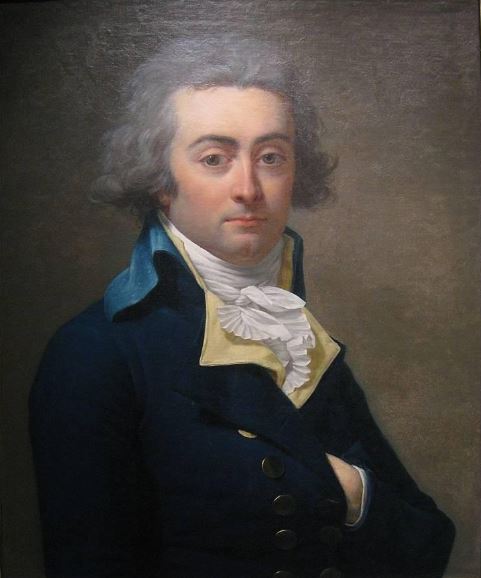
A month after Talleyrand’s report, on October 14, 1791, the National Legislative Assembly created its first « Committee of Public Instruction », of which the mathematician and philosopher Nicolas de Condorcet (1743-1794) was elected president and lawyer Emmanuel de Pastoret vice-president. The other members were future general Lazare Carnot, deputy Jean Debry, mathematician Louis Arbogast and politician Gilbert Romme.
Condorcet also presided over one of the three sections, dealing with the general organization of public education. On March 5, 1792, he was appointed rapporteur for the draft decree on the general organization of public education that the committee was to present to the Assembly.
Educated at the age of 11 at the Jesuit college in Reims, he was sent to the Collège de Navarre in Paris at the age of 15. Throughout his life, he retained painful memories of this primarily religious education, which he criticized for its brutality and humiliating methods. His indignation led him to imagine a totally different approach. In 1791, in La Bibliothèque de l’homme public (The Public Man’s Library), he published five memoirs on public education, constituting a veritable plan.
They formed the basis of the project he drafted for the Legislative Assembly, and were approved by the Committee of Public Instruction on April 18 and presented to the National Assembly on April 20 and 21, 1792.
7. Condorcet and the « American Party »
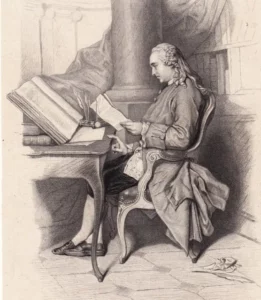
A hagiographer of the physiocrat Anne Robert Jacques Turgot (1727-1781), while criticizing the sectarianism of the « economists », Condorcet, in terms of economics, largely shared his Physiocratic worldview, notably the establishment of a tax on agricultural income alone, considered to be the nation’s sole source of wealth, with industry seen as a « sterile » category of the national economy (see my article dealing with Karl Marx’s errors).
For the Physiocrats, great defenders of the land rent that made them fat, the enemy to be fought was the centralized, dirigiste and mercantile state that Jean-Baptise Colbert, following in Sully’s footsteps, had begun to set up.
This did not prevent Condorcet, more courageous than many of his generation, from taking center stage in openly supporting the American Revolution in its fight for dignity and emancipation against the horrors of the British Empire: slavery, the death penalty, human and women’s rights.
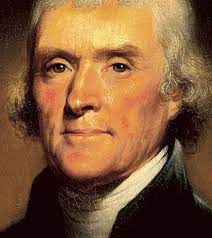

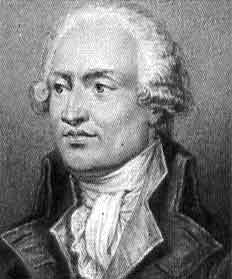
Although a friend of Voltaire, Condorcet wrote a vibrant eulogy of Benjamin Franklin. A friend of the influential English pamphleteer Thomas Paine, in 1786 he published « De l’influence de la Révolution d’Amérique sur l’Europe », dedicated to La Fayette. In this vibrant plea for democracy and freedom of the press, Condorcet considers that American Independence could serve as a model for a new political world. Along with Paine and du Chastellet, Condorcet contributed anonymously to an intermittent publication, Le Républicain, which promoted republican ideas. At the time, there were only a few states in the world known as republics (the Swiss cantons, Venice and the United Provinces, among others). Condorcet later had an argument with the second President of the United States, John Adams, whose encyclopedists scorned his proposal for a bicameral parliament.
Condorcet also made friends with the American president Thomas Jefferson, who promoted and published Condorcet’s writings in favor of the physiocrat Turgot in order to make them known in America. On July 31, 1788, Jefferson wrote to James Madison: « I am also sending you two little pamphlets by the Marquis de Condorcet, in which is the most judicious judgment I have ever seen on the great questions which are agitating this nation at this moment ». These were « Lettres d’un Citoyen des États-Unis à un Français et des Sentiments d’un Républicain ».
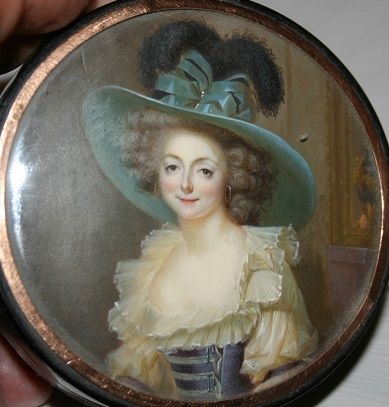
While in Paris, Jefferson frequented Mme de Condorcet’s cosmopolitan salon. Before returning to America, he received his closest friends one last time at his home, the Hôtel de Langeac: Condorcet, La Rochefoucauld, Lafayette and key organizer, Governor Morris.
After Jefferson’s return to America, Condorcet continued his dialogue with the American Secretary of State in Washington. On May 3, 1791, he sent him a copy of the report on the choice of a unit of measurement, presented by Borda, Lagrange, Laplace, Monge and himself to the Académie des Sciences on March 19, and subsequently submitted to the Assemblée nationale on the 26th. Indeed, it was a matter of common interest: on July 4, 1790, Jefferson had presented his Report on Weights and Measures to the American Congress, a copy of which he had sent to Condorcet. It was the same faith in progress that encouraged both men to support the idea of a universal, decimal system of measurement.
In a letter, Jefferson informed Condorcet of the work of a black American mathematician and astronomer, Benjamin Banneker, author of an almanac, of which he had sent him a copy. In his « Réflexions sur l’esclavage des nègres » (Reflections on Negro Slavery), Condorcet, though a staunch abolitionis, had expressed himself in favor of a gradual abolition of slavery, in the same way as Jefferson did in his « Notes on the State of Virginia ».
Jefferson oscillated in his positions, attributing the inferiority of blacks sometimes to natural causes, sometimes to the effects of slavery, while Condorcet – in agreement with Franklin – had always been convinced of the natural equality of all men.
In reality, the very man who became the third president of the United States owned over 600 slaves during his adult life. He freed two slaves during his lifetime, and five more were freed after his death, including two of his children from his relationship with his slave Sally Hemings. After his death, the remaining slaves were sold to pay off the debts of his estate.
Jefferson strongly opposed the « Federalists » like Alexander Hamilton, who promoted a strong federal state, Colbert-style economic dirigisme and mercantilism. Condorcet was to encourage Jefferson in his project of « agrarian democracy », the physiocratic vision of the great landowners that would become, until the arrival of Abraham Lincoln and his advisor Henry Carey, the ideology of the American Republican Party.
8. The « Condorcet » Plan
Progress of science and reason will lead to the happiness of societies and individuals, according to Condorcet. In Esquisse d’un tableau historique des progrès de l’esprit humain, he writes:
« Our hopes, concerning the future state of the human species, can be reduced to these three important points: the destruction of inequality between nations, the progress of equality within the same people; finally, the real perfection of man. »
Preferring « L’Instruction publique » to national education, he dreamed of an education totally independent of the State and free of dogmatism:
« Public authority cannot, even on any subject,
have the right to teach opinions as truths; it must not impose any belief. »
(Sur l’instruction publique, first memoir, 1791).
Outlining secular principles, for Condorcet, « the principles of morality taught in schools and institutes will be those which, founded on our natural feelings and on reason, belong equally to all men. »
At the National Assembly, he received massive applause when he declared :
« In these schools, the primary truths of social science will precede their applications. Neither the French Constitution nor even the Declaration of Rights will be presented to any class of citizens as tables descended from heaven, to be worshipped and believed. Their enthusiasm will not be based on the prejudices and habits of childhood; and they will be told: ‘This Declaration of Rights, which teaches you both what you owe to society and what you are entitled to demand of it, this Constitution which you must uphold at the expense of your life, are but the development of those simple principles, dictated by nature and reason, whose eternal truth you learned to recognize in your early years.
This Bill of Rights, which teaches you both what you owe to society and what you have the right to demand of it, this Constitution, which you must uphold at the cost of your life, is but the development of those simple principles, dictated by nature and reason, whose eternal truth you learned to recognize in your early years. As long as there are men who do not obey their reason alone, who receive their opinions from a foreign opinion, in vain will all chains have been broken, in vain will these command opinions be useful truths; the human race will no less remain divided into two classes, that of men who reason and that of men who believe, that of masters and that of slaves.' »
For those standing behind the Condorcet plan, the aim was to ensure the development of each individual’s abilities, and to strive for the perfection of humanity. His project proposed the creation of 5 categories of establishments:
- elementary school for civic and practical education ;
- secondary schools, with a focus on mathematics and science;
- institutions, providing training for primary and secondary school teachers in each département, and general education for pupils;
- lycées, training teachers and those « destined for professions in which great success can only be achieved through in-depth study of one or more sciences »;
- the Société nationale des sciences et des arts, whose mission was to manage schools, enrich cultural heritage and disseminate discoveries.
The plan was also characterized by the equality of ages and sexes in education, universal and free elementary education, and the freedom to open schools. Last but not least, religion was to be confined to the private sphere.
The project did not forget « the people », as weekly and monthly lectures for adults were intended to « continue education throughout life », an ambition taken up by Abbé Grégoire and Hippolyte Carnot.
As his son Paul Carnot recounts:
« In its short existence, the Constituent Assembly had only been able to pass on Talleyrand’s famous report to the Convention. After the no less famous reports by Condorcet and Lakanal, and the discussions of its Education Committee (almost as active as the Public Safety Committee), the Convention proclaimed the principles of compulsory, free and secular primary education, which are still ours today. The Declaration of the Rights of Man (art. XXII) proclaimed, with Robespierre, ‘Instruction is the need of all; society must favor, with all its power, the progress of public reason and put Instruction within the reach of all citizens’. »
Rarely were all parties in agreement on these points. The Girondins (Condorcet, Ducos) said, along with François Xavier Lanthenas (1754-1799), that « instruction is the State’s first debt to its citizens. »
On the subject of free education, Georges Danton said: « No one has the right not to educate his children. There is no real expense where there is a good use for the public interest. After bread, education is the first need of the people.
But the program of public education leading to the perfectibility of mankind thanks to reason, had not the chance to become a priority, as King Louis XVI, at the suggestion of General Dumouriez, went to the National Assembly to propose declaring war on Austria… Added to that, money for education wasn’t available.
Condorcet had to interrupt the lecture of his project. At the end of the afternoon of April 20, 1792, the Assembly adopted the declaration of war against the King of Bohemia and Hungary, unanimously minus seven votes. The following day, Condorcet completed the reading of his project. The Assembly decreed that the report be printed, but postponed discussion of it.
On May 24, Romme, on behalf of the Committee of Public Instruction, requested in vain that discussion of the report be placed on the agenda. Condorcet’s project, like Talleyrand’s report, did not have time to be debated, and was not adopted.
9. The battle under the « Convention » (1792-1795)

The protagonists of Year I (under the Convention) were hardly more decisive. A new Committee of Public Instruction was set up. It included Abbé Henri Grégoire, abolitionist and close friend of Lazare Carnot and later of his son Hippolyte, and Joseph Lakanal (1762-1845).
On December 12, 1792, Marie-Joseph de Chénier (1764-1811) read Lanthénas’s proposals, which echoed the ideas of Talleyrand and Condorcet. The discussions were fruitless, and the project was swept aside by Marat. Marat exclaimed that day:
« However brilliant the speeches we hear here on this subject may be, they must give way to more urgent interests. You are like a general who would amuse himself by planting and removing trees to feed starving soldiers. I ask that the assembly order the printing of these speeches, to attend to more important objects. »
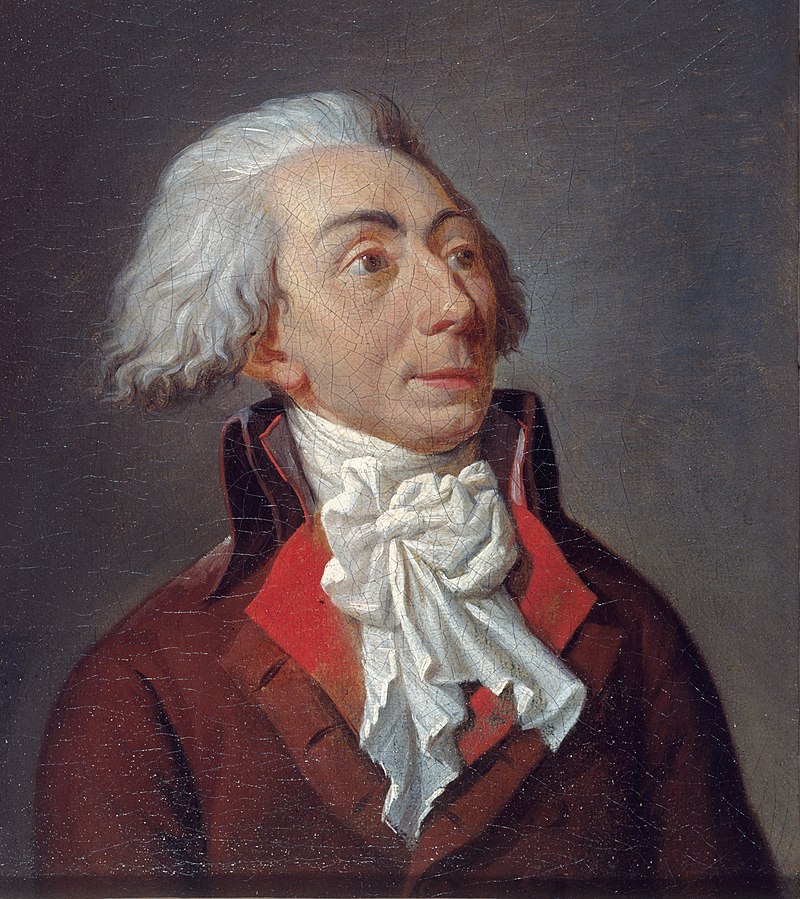
The following year, Robespierre opted for a national education plan devised by Lepeltier de Saint-Fargeau (1760-1793). According to this plan, presented by Robespierre himself on July 13, 1793, education without a healthy dose of republican ideology would not suffice to regenerate the human race. It is therefore up to the State to inculcate a republican morality, by taking charge of the common education of children between the ages of 5 and 12.
On January 21, 1793, the King was beheaded. While Carnot, who only backed the decision to prevent any possible return to power of the Monarchy, Condorcet, who was opposed to the death penalty on principle, opposed it.
Debates on public education were delayed. It was not until the end of the year that compromise legislation on the organization of elementary school came into being, making education compulsory and free for all children aged six to eight, and establishing the freedom to all to open schools. The decree of December 19, 1793 stipulated that primary schools were the first level of instruction, teaching the knowledge strictly necessary for all citizens, and that those responsible for teaching in these schools would henceforth be called « instituteurs » (teachers). This decree was only partially implemented.
1794 saw a profusion of legislative texts on the subject including the decree of January 27, 1794 which imposed the use of the French language in all education.
On October 21, 1794, another decision organized the distribution of the first schools in the communes.
On October 30, at the instigation of Dominique Joseph Garat, Joseph Lakanal and the Comité d’Instruction Publique, the first « Ecole Normale » was created to train teachers. The law stipulated that « a teacher training college would be established in Paris, to which citizens from all parts of the Republic who were already educated in the useful sciences would be called, to learn the art of teaching under the most skilful teachers in all disciplines ». The school, planned for some 1,500 students, was set up in an amphitheatre at the Muséum national d’histoire naturelle, which was too small to accommodate the entire class. Although the school was soon closed, it nevertheless attracted a number of brilliant teachers, including the scientists Monge, Vandermonde, Daubenton and Berthollet.
On November 17, 1794, Lakanal had a law passed making education free, with the Republic providing salaries and housing for teachers, and authorizing the creation of private schools.
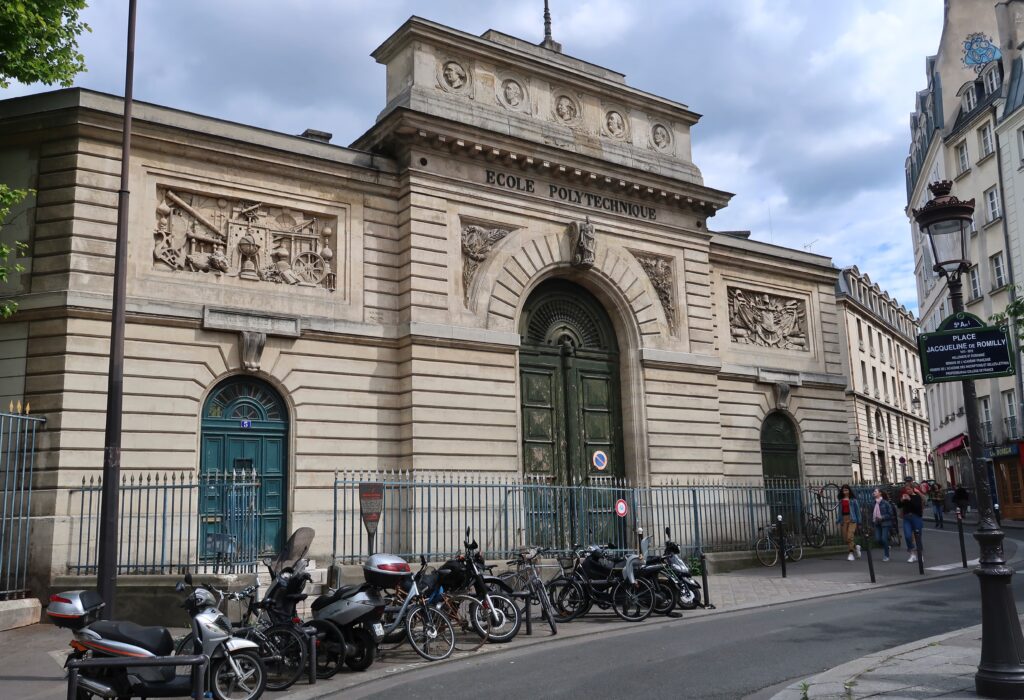
Also in 1794, Jacques-Élie Lamblardie, Gaspard Monge and Lazare Carnot, the institution’s founding fathers, were given the task of organizing a « Ecole centrale des travaux publics », renamed the « École Polytechnique » in 1795 by Claude Prieur de la Côte d’Or, not only to alleviate the shortage of engineers in post-Revolution France, but to create, by intensive training in projective geometry, a generation of scientific geniuses.
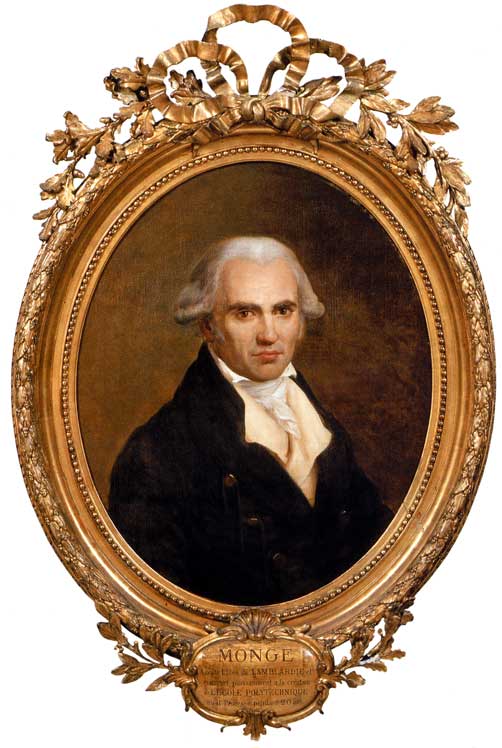
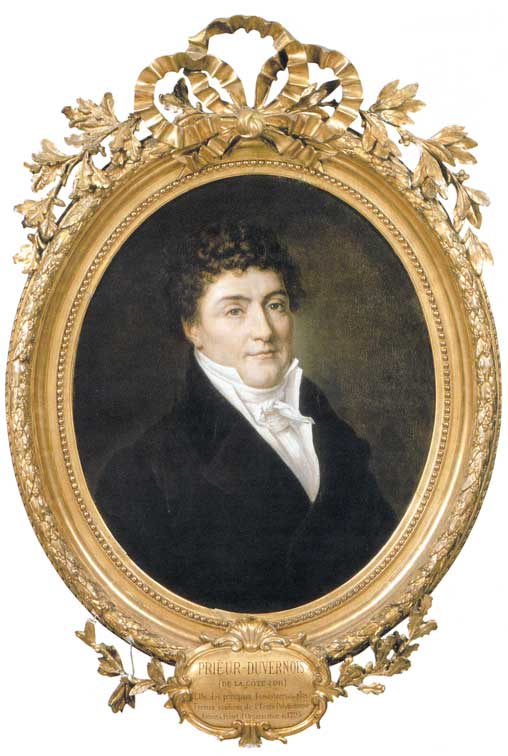
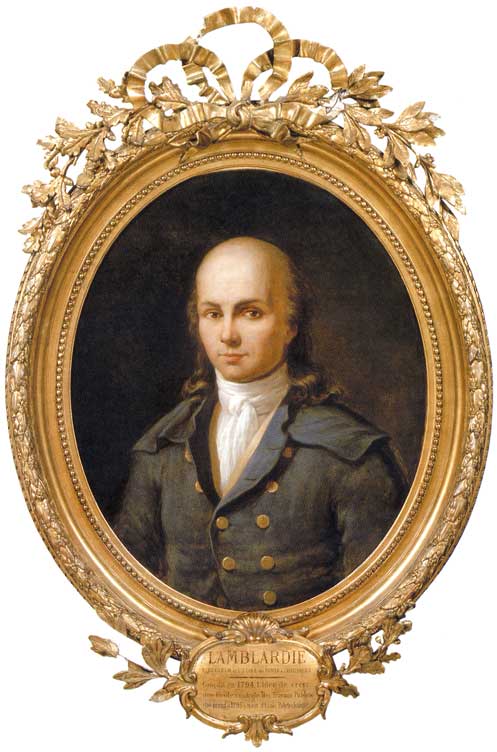
Unfortunately, in terms of universal schooling, the results in 1795 were disastrous: none of the decrees of 1794 had been implemented. Worse still, on October 25, 1795, a new law drafted by Pierre Daunou marked a step backwards: for lack of a budget, education was no longer free, teachers had to be paid by pupils (and their wealthy relatives), and the school curriculum was poor. This law remained in force until Napoleon’s texts on secondary and higher education in 1802. While it abandoned compulsory and free education, it did call for the creation of one elementary school per canton and secondary « central schools » in each département.
The new authorities set deadlines for municipalities to organize schools. They sent special envoys to see whether municipalities were taking the necessary steps to find and install a teacher.
In the towns and cities, the administration managed to recruit a certain number of candidate teachers, but in the countryside, the list often remained empty. In addition to the problem of recruitment, local authorities were faced with the problem of money, furniture, heating and books. Practising teachers complained about the shortage of pupils, as the republican school aroused mistrust. When the teacher ventured to replace the catechism and the Gospels with the Constitution and the Rights of Man, parents, encouraged by resistant priests, preferred to keep their children at home. The Comité d’Instruction Publique was inundated with questions, suggestions and requests.
On November 17, 1795, Lakanal had a new law passed by the Convention. Education remained free but not compulsory. It guaranteed a fixed salary and pension for teachers, and provided them with premises and housing. It authorized all citizens to set up private schools.
10. Lazare Carnot during the Cent-Jours (The Hundred Days)
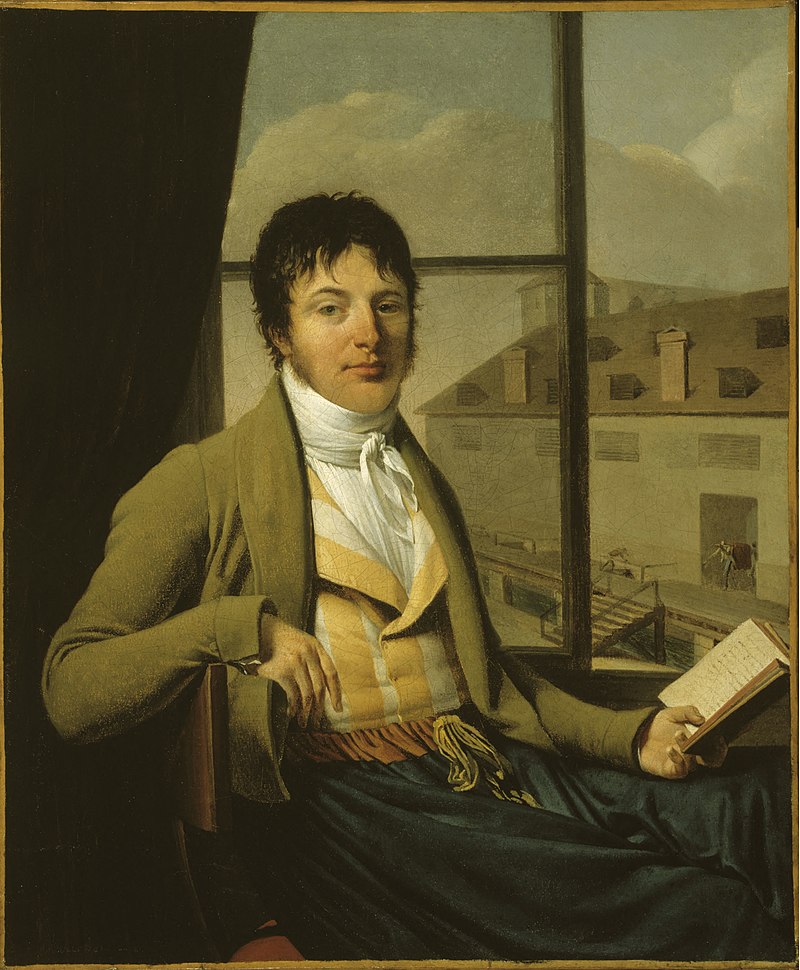
On November 9, 1799, Bonaparte fomented a coup d’état and established the Consulate regime. As First Consul, he signed the Concordat with Pope Pius VII on July 16, 1801, abolishing the 1795 law separating Church and State.
Seizing the opportunity of the moment, and above all seeking to respond to immediate needs, the Minister of the Interior, the republican chemist and industrialist Jean-Antoine Chaptal (1756-1832), submitted to Bonaparte a project for the organization of secondary education, entrusted in particular to the Oratorians of Tournon. In 1800, he presented his « Rapport et projet de loi sur l’instruction publique » (Report and draft law on public education).
Recalled by the First Consul, Lazare Carnot was given the War portfolio, which he held until the conclusion of the Peace of Amiens in 1802, after the battles of Marengo and Hohenlinden.
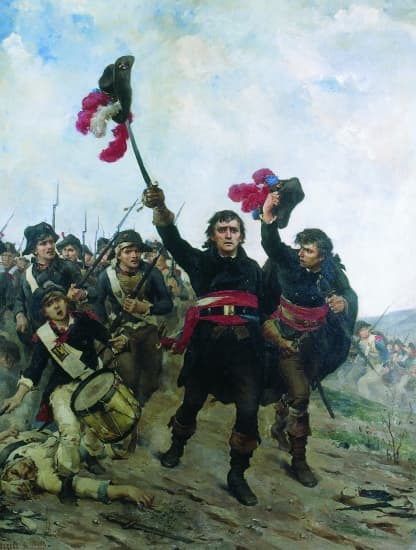
An early revolutionary, but also a moderate and republican, he voted against the Consulate for life, then was the only speaker to vote against the Empire on May 1, 1804.
From then on, deprived of all political influence, he refocused on the Académie des Sciences. In 1814, he was entrusted with the defense of Antwerp, a city of which he became mayor: he held on for a long time, and only agreed to hand over the city on the orders of Louis XVIII.
But a few months later, the Emperor returned to power for the Hundred Days, from March to June 1815. It was at this point that Lazare, who had finally been threatened with arrest to the point of hiding out on rue du Parc-Royal, was appointed Minister of the Interior on March 22, 1815. And as this ministry included Public Instruction in its remit, he was able to launch the educational project that was so close to his heart.



Three days after his installation at the Ministry, Lazare Carnot commissioned a study on education. It was inspired by the work of the « Société d’encouragement pour l’industrie nationale », headed by philanthropist Joseph Marie de Gérando, who had also been educated by the Oratorians in Lyon and was a proponent of Mutual Tuition.
Carnot and his faction then founded the « Société pour l’Instruction Elémentaire » (SIE) to promote this type of education. For Carnot and Grégoire, education and instruction should « elevate all individuals of the human species to the dignity of Man », educate as much as moralize, and spread love among men.
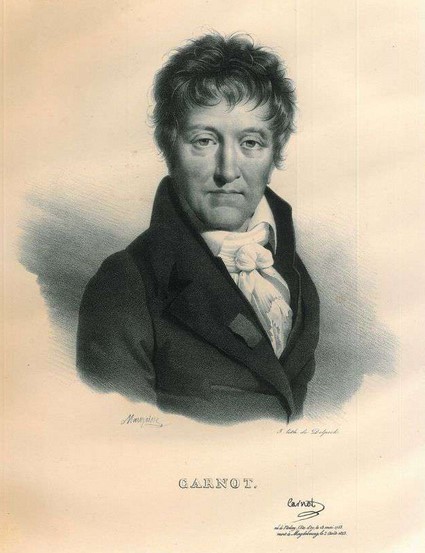
During the Hundred Days, Carnot had just enough time to prepare, in April 1815, a « comprehensive plan for popular education », followed by a decree and the creation of a Special Commission for Elementary Education, tasked with outlining prospects in this area, drawing inspiration from English and Dutch models.
Familiar with the « brigades » invented by Gaspard Monge at Polytechnique, where the best students supervised the others, Carnot was in favor of the system of mutual tuition in popular schools. For him, the issue was not alleviating the suffering of the poor or avoiding social chaos, but educating every citizen of the Republic, whatever his conditions, to have a functial Republic. After spreading to England and Switzerland, Carnot established mutual tuition in France. Convinced of the importance of music and linear drawing, he wanted pupils to be taught it.
With this in mind, he met several times with Alexandre-Étienne Choron (1771-1834), who had also been educated by the Oratorians, and brought together a number of children to perform several pieces learned in very few lessons. Carnot had also known the pedagogue Louis Bocquillon, known as Wilhem (1781-1832), for ten years. He also saw the possibility of introducing singing into schools, and together they visited the Mutual Tuition pilot project on rue Jean-de-Beauvais, which had opened in Paris to three hundred children. Starting from there, Wilhem created the mass musical movement known as « Orphéons ». (see article by Christine Bierre)
11. Hippolyte carries on the Torch
Lazare, a pupil of Gaspard Monde and a scientific mind of the highest order, had strong ideas about education that would shape the personalities of his sons, notably Hippolyte, the future Minister of Public Instruction in the Second Republic. For the two Carnots,
« all social institutions must aim at the physical, intellectual and moral improvement of the largest and poorest classes ».
More than « full heads », he aspired to turn his sons into « well-made heads », « to let us know the taste of good things rather than make us infallible about the meaning of words », in the words of his younger son. For Lazare, it was a matter of putting to the test in the family the educational principles he advocated for the nation.
Although he had little interest in « dead languages » and was more interested in living ones, Lazare introduced his children to Latin, which was once again a compulsory language in the imperial lycées created in May 1802. For the rest, while their father’s rich library introduced Sadi Carnot and his brother Hippolyte to the classics that were essential to the humanist culture on which secondary education was based, it also introduced them to other, more contemporary and innovative thinkers.
Among them, Hippolyte was interested in those who addressed educational issues, such as Rousseau, but also in more original philosophers like Saint-Simon (whose movement was attractive but became a cult after his lifetime), of whom Lazare Carnot said:
« Here is a man who is called extravagant, yet he has said more sensible things in his entire life than the wise men who scoff at him […]. But he is a very original, very bold mind whose ideas deserve the attention of philosophers and statesmen ». Evoking his father, Hippolyte would later say, « The lessons we received were all intended to make us, like the master who gave them, virtuous without effort, wise without system. »
Lazare Carnot sends Hippolyte to the Polytechnic Institution, 8 avenue de Neuilly. According to Dalisson,
« the young Carnot received a Spartan education where, while discipline did not exclude corporal punishment under the rule of ‘Inspecteurs généraux’, pedagogy was innovative. Pupils were divided into classes according to age, and teaching combined intellectual and physical education through programs that complemented their father’s education. Hippolyte thus perfected his reading, ancient and modern languages, literature, mathematics, physics and geometry, and acquired a taste for chronology, history, drawing, music, fencing and dance, proving himself an excellent student in every respect.«
12. Exile of Lazare Carnot
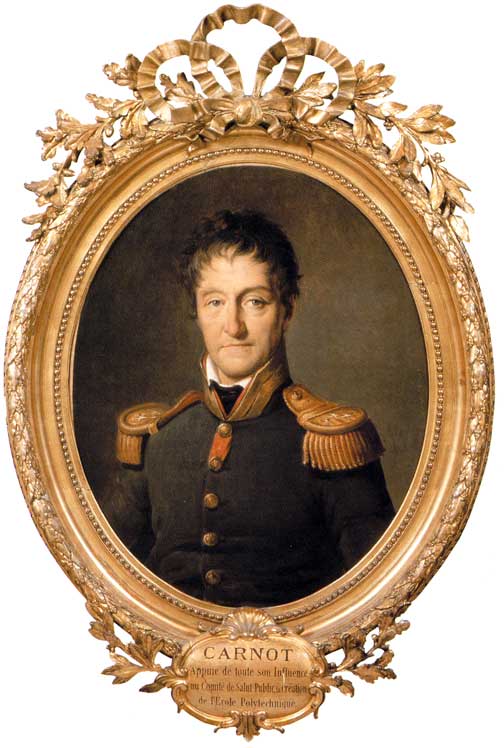
After Napoleon’s second abdication, Lazare Carnot joins the provisional government. Exiled at the time of the Restoration, he was banished as a regicide in 1816 and retired to Warsaw, then to Magdeburg, where he devoted the rest of his life to study and, above all, the education of his children.
Dalisson: « when he’s not at school, he (Hippolyte) serves as secretary to his father, who continues his education ». In Magdeburg, « one of Carnot’s consolations was to complete the education of his young son, whose studies he directed more especially towards historical questions and social economics ». So it was in Prussia that Hippolyte found his way, abandoning the « hard » sciences to devote himself to philosophy in general, and political and social philosophy in particular. There, education had a privileged status since Frederick II had made primary education compulsory in 1763, envisaged a form of free education (for poor families) and created gymnasiums for secondary education. Enough to inspire Carnot père and fils to imagine how France could catch up.
Better still, as Dalisson points out:
« Prussia remains a kingdom which, like France a few years earlier, carried out a « levée en masse » (mass recruitment) in 1813 to drive out the invader. The link between popular education and national sentiment, between education and the economy, between liberalism and national education, is an obvious one, and ties in with the Carnot family’s educational ideals. That’s why, at the [prussian] government’s request, Lazare set up an educational project to create a « vocational school » in this distant host country. With the help of Hippolyte, he set up a complete teaching system for agriculture and industry. Although we have no trace of the text, it undoubtedly influenced the young man as much for his Parisian and liberal years as for his future ministry ».
13. Hippolyte with Abbé Grégoire
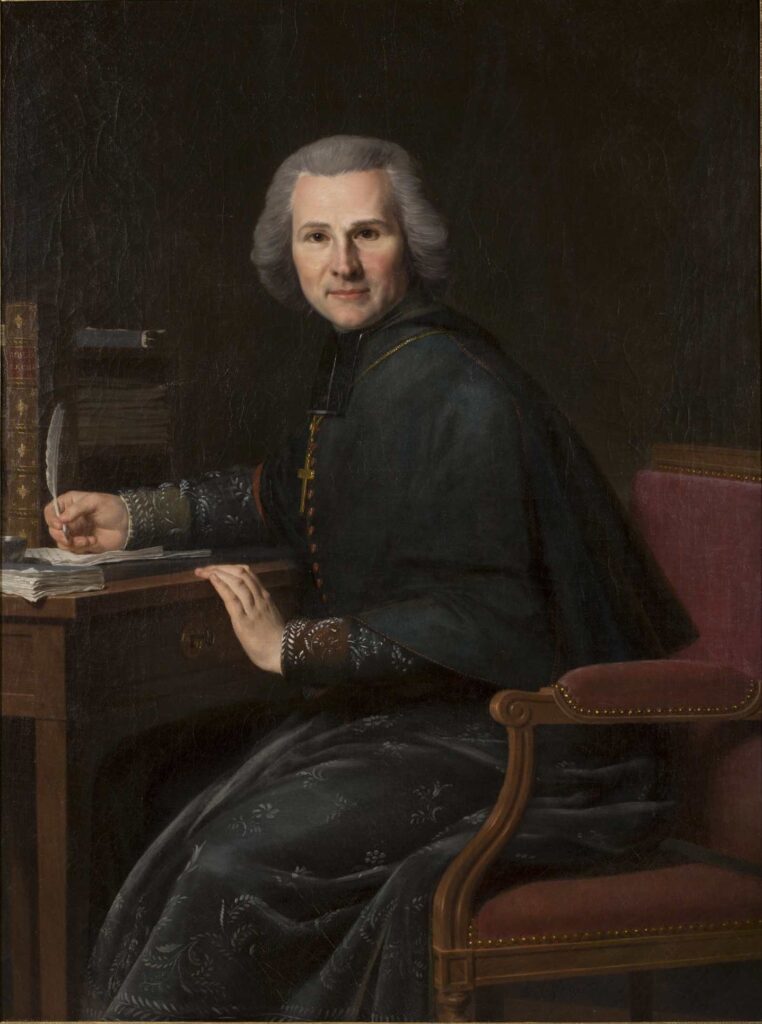
Back in France, Hippolyte contacted his father’s old friends, notably Abbé Henri Grégoire. An emblematic figure in the fight for the emancipation of Jews and blacks, this « revolutionary bishop » called for the total abolition of privileges and advocated universal male suffrage.
In principle, Hippolyte approved. However, in practice, after observing the people’s infatuation with public executions, he discovers how easily a crowd can be led, even manipulated, by playing on irrationality, passion and impulses – all things that make the use of universal suffrage tricky, and can lead to dictatorship. He concludes that popular education must enlighten the people to bring them back to more fraternal and reasonable sentiments.
For Abbé Grégoire, as for Carnot père and fils, slavery must be abolished, nations must free themselves from Empires by recovering their sovereignty, and education must free citizens from ignorance, a set of subjects marvelously brought together in the iconography of the bas-reliefs on the base of the statue of Gutenberg in Strasbourg, a commemorative monument created by a friend of both Grégoire and Hippolyte, after Victor Hugo, the sculptor David d’Angers.
As a member of the Comité d’Instruction Publique, Henri Grégoire called for the generalization of the French language, as the Oratorians had done before him, and became the rapporteur for the abolition of the old academies and the creation of the Institut.
The opening of a whole series of « special schools », such as the Ecole polytechnique (1794) and the Institut des langues orientales (1795), the establishment of the Musée du Louvre (1793), the preliminary project for a Bibliothèque nationale (1790), the creation of the Bureau des Longitudes (1795), the introduction of new units of weights and measures, the metric and decimal systems, the extension of elementary schools to all communes and one of the jewels in the crown of this policy: the founding of the Conservatoire National des Arts et Métiers (1794), owed much of their success to the boundless energy of Abbé Grégoire.
The aim was to transmit technical knowledge to two types of audience. On the one hand, the « grandes écoles », aimed at the country’s new elites, provided high-level education to train scientists and engineers (École polytechnique, Ponts et chaussées, etc.) or the future teachers of the new public education system with the École normale (1794); on the other hand, schools designed for middle management in factories, good workers and workshop managers: this was the case of the écoles d’arts et métiers, heirs to the vocational school imagined in 1780 in Liancourt (60) by the Duc de la Rochefoucauld-Liancourt.
Grégoire also established several major institutions that still exist today, including, in addition to those already mentioned, the Natural History Museum (1793), the Royal Garden of Medicinal Plants (1793) and the Museum of French Monuments (1795).
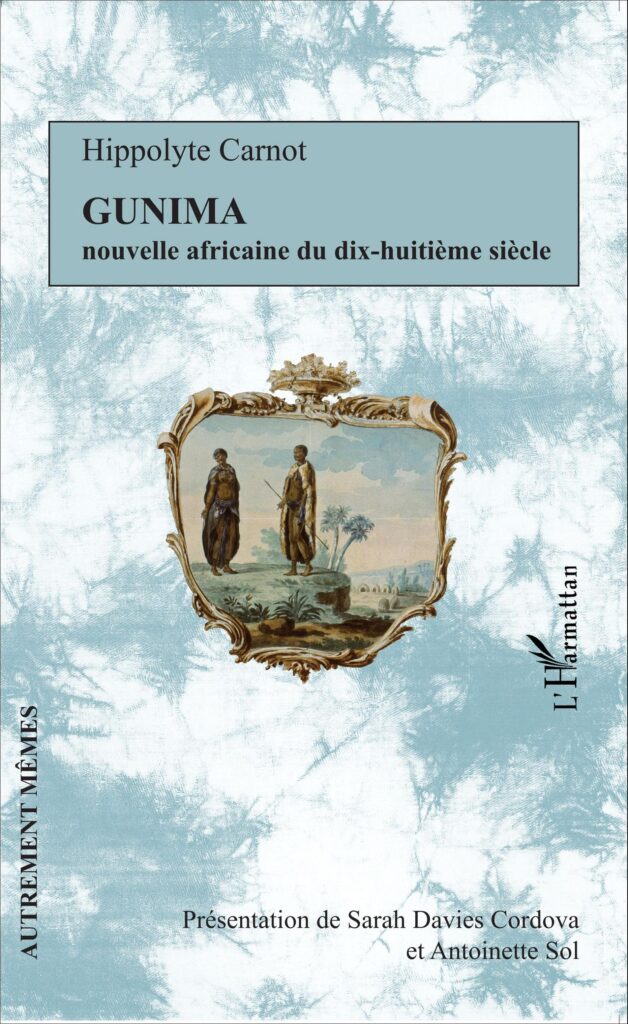
Grégoire introduced the young Hippolyte to the Masonic lodge of which he was a member, Les Philadelphes. Inspired by Grégoire’s struggle, of which he would be the executor and about which he would publish a work towards the end of his life, Hippolyte, barely 23 years old, published « Gunima, an 18th-century African short story » (1824), a philosophical tale recounting the moral education of young Benjamin who, equipped with the principles of the Enlightenment, confronts his prejudices and the injustice of the slave and servitude regime of the so-called Hottentots of the Cape. Surprisingly modern, the story takes up the challenge of fraternity at a time when France was responding to Haiti’s demands for recognition.
True to the philosophy of Abbé Grégoire, he protested against the expulsion of Jews from Dresden, where they were forbidden to stay. Indignant, he tried to alert public opinion: since 1789, Jews have been French citizens like any others. He reaffirmed his faith in freedom of worship, which had enabled the emancipation of the Jews, and exclaimed:
« If we call a Jew someone who, from his mother’s womb, society condemns to the vilest slavery, who vegetates without rights in his homeland and serves as a breastplate for the insults of the rabble, to whom his actions deserve nothing (…) and who is relentlessly pursued by shame and contempt, then I am a Jew and always will be ».
14. Like Schiller, patriot and world citizen
From Dalisson‘s book:
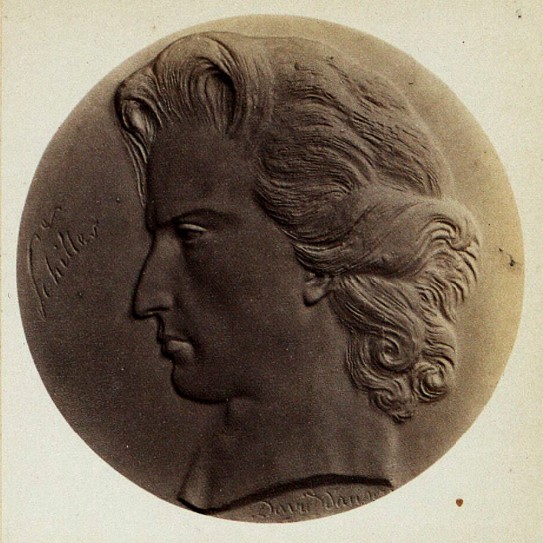
« Carnot’s position is summed up at a celebration in homage to the French Revolution on March 19, 1838 in Paris. In the name of ‘holy equality, solidarity between all peoples and all races of men in a spirit of fraternity’, he toasted ‘the abolition of slavery, the cessation of this awful scandal of humanity’.
« From that day on, he collaborated regularly with Victor Schoelcher, a journalist, Freemason, close to the Saint-Simonians and member of the same societies as himself, whom he would meet again three years later in the government of the Republic, then in exile. Schoelcher had been confronted with slavery in Cuba as early as 1828 and also believed that their emancipation should be gradual, before changing his mind and becoming a supporter of immediate abolition.
« Freedom must also apply to peoples and therefore to nations, because ‘the principle of all sovereignty lies in the nation’. A son of 1789, educated during the struggles for national emancipation, a student steeped in Romanticism, passionate about the revolts of the fifties and thirties before being caught up in the « Spring of the Peoples », Carnot placed his trust in the freedom of nations: « Salvation will come from peoples uniting to overcome the common enemy, despotism. If liberated nations and peoples manage to get along and unite, they will even build ‘United Europe’.
« Throughout the century, he would support all national struggles, and hence national unity, against empires that oppressed minorities. For nationality ‘is the human right proclaimed in 1789, the right to group together according to one’s affinities of character, tradition, race and language, and is basically LIBERTY itself’.
Even after the 1870 war, he was convinced of a kind of « right of peoples to self-determination » in a Europe founded on the freedom of peoples.
In his writings on foreign policy, notes Dalisson, he regularly recalled Friedrich Schiller‘s maxim: « Man is created free, he is free, even if he is born in chains. (…) Do not tremble before the free man. This freedom of peoples and nations must even be based, horresco referens, on the necessary reconciliation between France and Germany, two neighboring peoples who have been separated by the vicissitudes of history, but who are « two friends who have been divided by long quarrels and who need to explain themselves ».
15. The 1830 Revolution
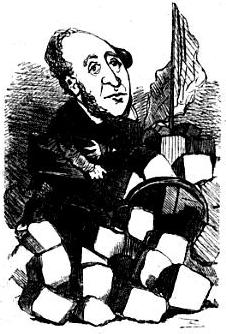
The Revolution of 1830, also known as the July Revolution or the « Three Glorious Days », took place in Paris on July 27-28-29, 1830. Parisians, at that time the foremost revolutianary citizenry, rose up against the reactionary policies of King Charles X’s government. One of them, was Hippolyte Carnot who had transgressed his legendary moderation, took a rifle and joined those on the barricades. The question immediately arose: « What should replace the king? » Many intended to restore the Republic.
On July 30, deputies and journalists in favor of the Duc d’Orléans put up posters recalling the « patriotic » past of the duke, a veteran of Valmy who claimed to be in line with the ideas of George Washington, and his commitment to the future: he would be « a citizen-king ».
Unconditionally, the representatives of the people (95 deputies present in Paris) proposed that the Duc d’Orléans be appointed Lieutenant-General of the kingdom.
On July 31, he accepted the position and went to Hôtel de Ville in Paris, the Republican headquarters. There, before a gathered crowd, he was embraced by La Fayette, both wrapped in the tricolor flag. Lafayette felt that a gradual transition to a republic could only be achieved through a constitutional monarchy. On August 9, the deputies amended the Charter of 1814 to become the constitutional « charter » of 1830, and the Duc d’Orléans was proclaimed « King of the French » under the name of Louis-Philippe I.
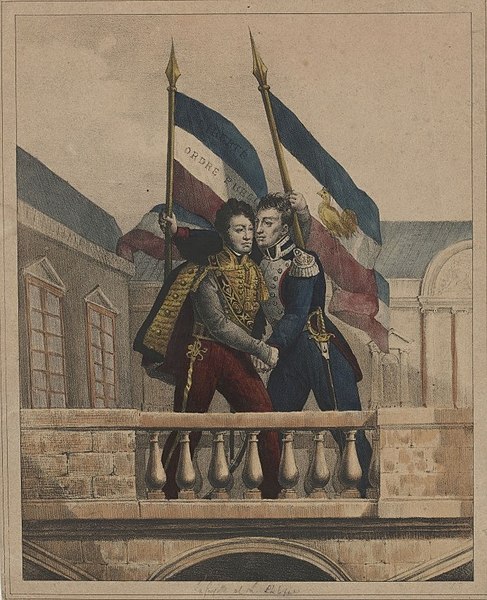
Hippolyte Carnot, always a moderate, believed in « representative democracy » and was elected three times as a deputy under the Monarchy of 1830. A spokesman of the opposition to the regime, he prepared for what was to come.
16. Minister of Public Instruction under the Second Republic (1848)
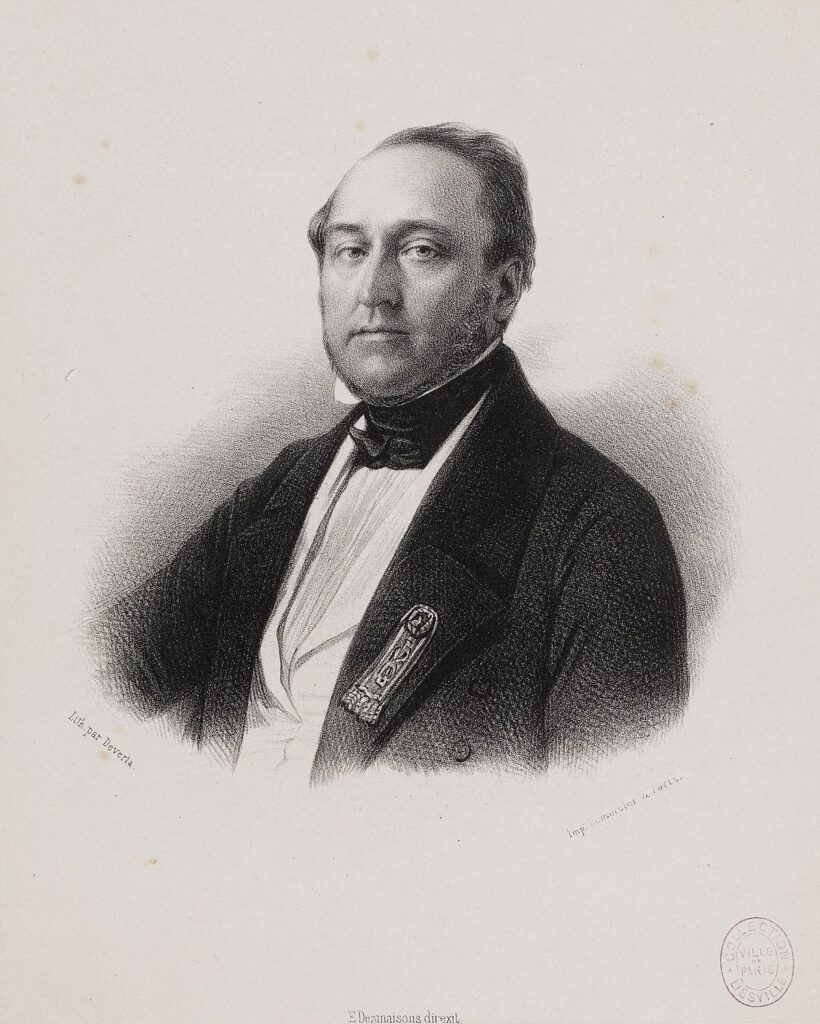
After an initial attempt to re-establish republican values, neutralized by Louis-Philippe’s « Coup d’état » in 1830, the uprisings of 1847-48 succeded in February 1848 with the formation, at Paris City Hall, of the « Provisional Government » led by several friends of Hippolyte Carnot, to establish the « Second Republic ».
The provisional government’s first measures were intended to break with the previous period. The death penalty was abolished in politics. Corporal punishment was abolished on March 12, and « contrainte par corps » (imprisonment for debt) on March 19.
On March 4, a commission was set up to resolve the problem of slavery in the French colonies. Under the aegis of the Minister of Colonies, the Republican astronomer François Arago, a close friend of Alexander von Humboldt, and whose Secretary of State was Victor Schoelcher, its work led to abolition on April 27.
In the political sphere, the changes were significant. Freedom of the press and of assembly were proclaimed on March 4. On March 5, the government instituted universal male suffrage, replacing the censal suffrage in force since 1815. In one fell swoop, the electorate rose from 250,000 to 9 million…
This democratic measure made the rural world, which accounted for three-quarters of the population, the master of political life for many decades to come. Elections for a Constituent Assembly are scheduled for April 9. Lafayette’s National Guard, previously reserved for notables and shopkeepers, was made accessible to all citizens.
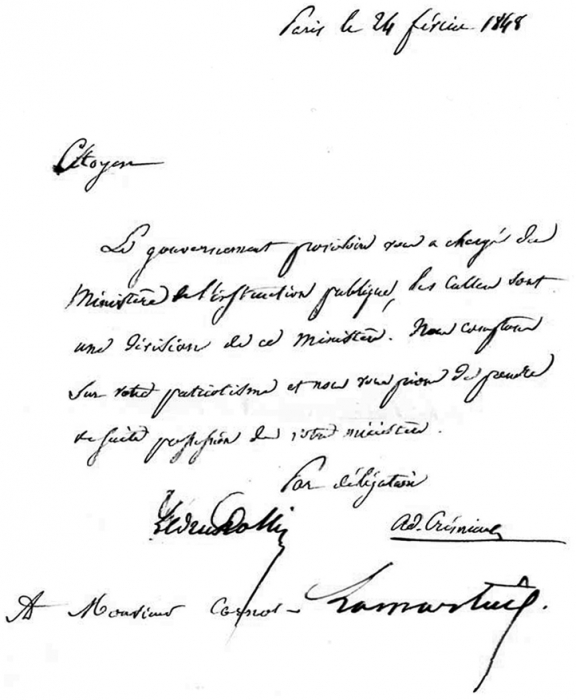
The provisional government proposed appointing Hippolyte Carnot to the Ministry of War or the Interior; he declined the offer, but accepted the Ministry of Public Instruction (which Victor Hugo had just refused), to which was added the Ministry of Religious Affairs, which until then had been the responsibility of the Ministry of Justice. Carnot’s desire to see cults be part of public education was based not only on his lack of hostility to the Church, but also on his belief that a close alliance between the Republic and the lower clergy was the best guarantee of progress.
« I myself, » he wrote, « have religious sentiment too deeply engraved in my heart not to be and not to want those around me to be full of deference towards the ministers of all religions. » And again: « My constant efforts have been aimed at reattaching the lower clergy to the Republic. The minister of religion and the schoolmaster are, in my eyes, the columns on which the republican edifice must rest. »
17. Hippolyte Carnot’s reforms
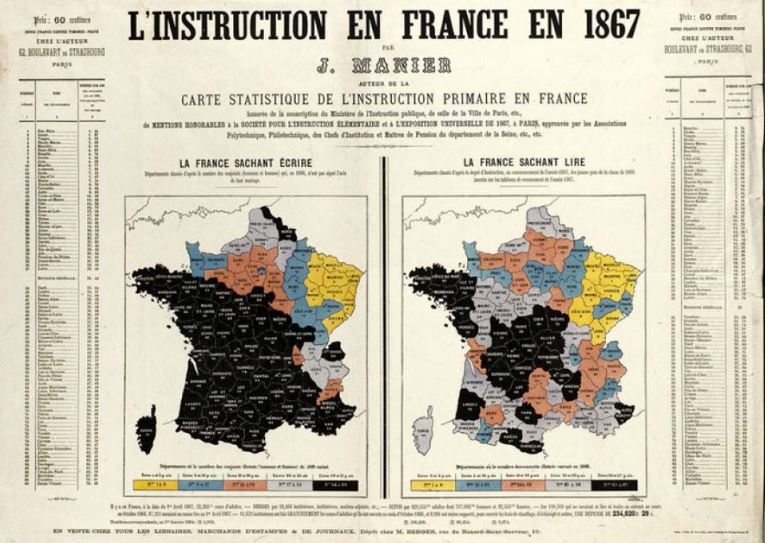
En s’appuyant sur le degré d’instruction des Français à l’âge du mariage, cette carte met en
évidence une grande disparité entre les régions. Ainsi, le taux d’alphabétisation des
habitants du nord et de l’est est-il nettement supérieur à celui des habitants du sud et de
l’ouest. La France alphabétisée est celle des grandes villes, des campagnes riches et des
populations denses.
During his very short ministry, armed with an overall vision that had been carefully thought through and prepared in advance, he announced, sometimes several times a week, republican reforms of all the major areas of education, from early childhood through to adults, including teacher training, senior civil servants and all citizens. Declaring in his preparatory notes that « it is important that the various levels of the education system integrate into each other, leading directly from one to the other ».
A. Nursery schools
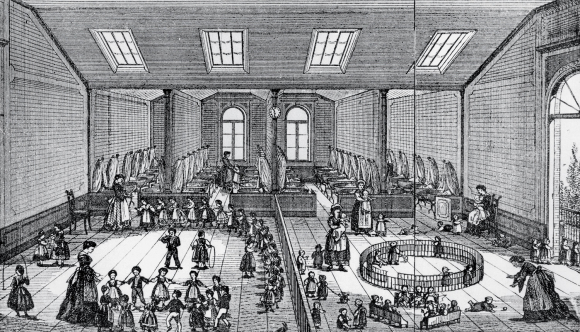
For Carnot, « salles d’asile » were little more than charitable establishments run by nuns. Little was done to educate infants. Their name, reminiscent of misery and almsgiving, was replaced on April 28 by « nursery school ». « The child should find there the education he cannot receive from his mother, i.e. the care of the body, the language of feeling, and those little exercises intended, not yet to furnish the intelligence, but only to open it up ».
In the minds of Jean Reynaud (Under-Secretary of State for Public Instruction) and Carnot, the asylum was neither a school of instruction, nor a place of refuge for children deprived of their parents. At the same time, a « normal nursery school » was set up in Paris, for pupils aged between twenty and forty.
B. Primary schools
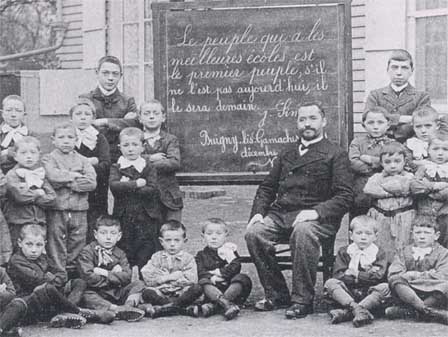
As early as February 27, in a circular to the rectors, Carnot expressed his intention to improve the condition of primary school teachers: « The condition of primary school teachers is one of the main objects of my solicitude…. It is to them that the foundations of national education are entrusted. It is not only important to raise their status through a fair increase in their salaries; the dignity of their function must be enhanced in every way…. Instead of sticking to the education they have received in elementary school, they must be constantly encouraged to improve it… There is nothing to prevent those who are capable of doing so from rising to the highest echelons of our hierarchy. Their lot in terms of advancement cannot be inferior to that of soldiers; their merit is also entitled to conquer ranks… However, to ensure that all are encouraged to emulate each other in such a glorious way, intermediate positions must be guaranteed. This will naturally be achieved by extending the teaching of mathematics, physics, natural history and agriculture to higher elementary school. In the name of the Republic, primary school teachers will therefore be invited to prepare themselves for the recruitment of staff for these schools. This is one of the complements to the establishment of primary teacher training colleges. It is in the interest of the Republic that the doors of the university hierarchy should be opened as wide as possible to these popular magistrates ».
On June 30, the Minister therefore tackled primary education. Before him, the ordinance of February 29, 1816 had marked a turning point. It established a cantonal committee to oversee schools and, in article 14, obliged communes, without giving them the means to do so, to « ensure that the children who live there receive primary education, and that indigent children receive it free of charge ». In short, primary education was left entirely to the communes, which in turn, for lack of premises and resources, called on religious congregations.
The minister therefore proposed « to raise the status of teachers by transforming them from commune officials into state officials », to emancipate them from local potentates, parents and clerics. For « it is certainly necessary that the teacher be accepted in his commune, but if he depends too much on it, he is not considered enough. It is therefore important that he cannot be capriciously dismissed ». With this in mind, he abolished the « certificate of morality », which had tied schoolteachers to the Church and, incidentally, to the government.
In addition to the compulsory schooling (for both sexes and for communes of at least 300 inhabitants) and total free education already mentioned, he wanted to complete the curricula to form a « uniform core curriculum (…) designed to review everything and serve to determine vocations », prefiguring the school of Jules Ferry and going further than just reading, writing and arithmetic.
In addition to national history and geography, several of Carnot’s favorite subjects, singing, natural history and linear drawing – three subjects designed to develop and educate – there are several specific features to be found in the new texts. The first, which would be taken up again thirty years later, is a kind of civic instruction that the Minister describes as « the duties and rights of man and citizen, the development of feelings of liberty, equality and fraternity (…), the basis of a civic education for the republican education of the country ».
Hippolyte had been elected to the Constituent Assembly on April 23, 1848. When, on May 10, 1848, the « Executive Commission » (May 9 – June 28, 1848) replaced the « Provisional Government » (February 24 – May 9, 1848), he retained his portfolio; but the executive, « in order to strengthen the revolutionary element », appointed Jean Reynaud (1806-1863), a former Saint-Simonian like himself, also elected as a representative, as Under-Secretary of State: I knew the real moderation of his principles, » Carnot wrote; « he knew the firmness of mine, and together we laughed at the role they were trying to assign him« . Edouard Charton (1807-1890), also a former Saint-Simonian and now a member of the Assembly, resigned as Secretary General, but continued his good offices without an official title.
Among Carnot’s actions in this second period of his ministry, we should mention the tabling, on June 3, of a draft decree opening a credit of 995,000 francs, intended to increase, for the second half of 1848, the salaries of those primary schoolteachers whose fixed and contingent salaries remained below six hundred francs; and a second credit, of 105,000 francs, intended to assist, during 1848, female communal schoolteachers whose fixed and contingent salaries remained below four hundred francs (the decree was voted on July 7).
C. Explanatory memorandum to the June 1848 School Act
The drafting of the primary education law continued in a small committee, charged with coordinating the work prepared by the High Commission. It was completed in the course of June, but the submission of the draft, delayed by events, could only take place on June 30, 1848. The explanatory statement reads as follows:
« Citoyens représentants, the difference between the Republic and the monarchy should nowhere be more profoundly demonstrated, in the field of public education, than in what concerns elementary school. Since the free will of the citizens must henceforth give the country its direction, it is on the proper preparation of this will that the future salvation and happiness of France will depend.
« The purpose of primary education is thus clearly defined. It is no longer simply a matter of equipping children with the notions of reading, writing and grammar; the State’s duty is to ensure that all children are brought up to be truly worthy of the great name of citizen that awaits them. Primary education must therefore include everything necessary for the development of the human being and the citizen, as the current conditions of French civilization allow us to conceive them. At the same time as introducing a greater body of knowledge into this teaching, it must also contribute more directly to moral education, and particularly to the consecration of the great principle of fraternity that we have inscribed on our flags, and which it is essential to make penetrate and live everywhere in people’s hearts if it is to be truly immortal.
« It is here, citizens, that primary education joins religious education, which is not the responsibility of the schools, but to which we sincerely appeal, to whatever religion it relates, because there is no more solid and general basis for the love of men than that which is deduced from the love of God.
« The establishment of the Republic, in giving primary education this new tendency, also required, as natural consequences, two important measures, which are to make this education free and compulsory.
« We want it to be compulsory, because no citizen can be exempted, without damage to the public interest, from an intellectual culture recognized as necessary for the proper exercise of his personal participation in sovereignty.
« We want it to be free, because we want it to be compulsory, and because there should be no distinction between the children of the rich and those of the poor in the schools of the Republic.
« We ask you to proclaim the freedom of education, i.e. the right of every citizen to communicate to others what he knows, and the right of the father of a family to have his children brought up by the teacher of his choice. We consider the declaration of this right as one of the legitimate and sincere applications of the word of liberty that our Republic has enthusiastically thrown into the world (…). (…) It even seemed to us that it would not be the least of the means of raising the standards of public schools to allow private schools to flourish, on condition that in this career of emulation, the former did not lack any favorable chance (…) In a word, citizens, the idea according to which we have directed ourselves has been the continual union of the principle of authority with that of liberty. (…) It is in this conciliation between two equally respectable principles that the whole spirit of the law we have the honor of submitting to you consists. »
Source : Hippolyte Carnot, Bulletin des lois, 1848
D. Schoolteachers called to enlighten the countryside

On March 5, a decree set April 9 as the date for convening the electoral assemblies for the appointment, by universal suffrage, of the « Constituent Assembly », which would sit from May 4 to 26. These were the first elections since 1792 to be held by universal male suffrage.
By decision of the Second Republic, the number of voters, which rose to 9,395,035, was multiplied by 40 !
However, as we have said, while Hippolyte Carnot was theoretically in favor of universal suffrage, with the vast majority of French people uneducated, the expression of the vote was likely to lead to disaster. No part of primary education, he writes, « has been more neglected under previous governments than the training of children as citizens ». As a result, many of the voters who have just been invested with the right to vote by the decree of the provisional government are not, especially in the countryside, sufficiently educated in the interests of public affairs.
To try and enlighten these voters about their rights and freedoms, Carnot appealed to schoolteachers:
« Encourage those around you who are capable of such a task to compose short manuals for your schoolteachers, with questions and answers, on the rights and duties of citizens. See to it that these books reach the teachers in your jurisdiction, and that they become in their hands the text of profitable lessons. This is what is going to be done in Paris before my eyes; imitate it. Let our 36,000 primary schoolteachers rise to my call and immediately become the repairers of public education for the rural population. May my voice reach even our last villages! I beg them to do their part in founding the Republic. It’s not a question of defending it against the danger of its borders, as it was in the days of our fathers; it’s a question of defending it against ignorance and lies, and it’s up to them to do this. New men, that’s what France needs. A revolution must not only renew institutions, it must also renew men. You change your tools when you change your work. This is a fundamental principle of politics. But schoolteachers, in enlightening voters, must not only teach them to choose the representatives most capable of consolidating the democratic regime; they can do more: « Why shouldn’t our primary schoolteachers put themselves forward, not only to teach this principle, but to take their place among these new men? There are some, I have no doubt, who are worthy: let a generous ambition ignite in them; let them forget the obscurity of their condition; it was most humble under the monarchy; it becomes, under the Republic, most honorable and most respected (…) Let them come among us, in the name of these rural populations in whose bosom they were born, whose sufferings they know, whose misery they share only too much. Let them express within the legislature the needs, wishes and hopes of this element of the nation, so vital and so long neglected. Such is the new service which, in these revolutionary times, I claim from the zeal of Messieurs les instituteurs primaires. »
These were words the like of which France had not heard since Year II. They caused deep emotion; they put the flame in the heart of all that was young and generous in the primary teaching staff, at the same time as they produced the most lively irritation in the conservative camp. Furious, Léon Faucher wrote to a friend on March 7: « Read Carnot’s circular to the rectors. It’s a masterpiece of madness!«
The Minister’s call for textbooks on the rights and duties of the citizen was heard. In several académies, rectors had civic education catechisms written and published. In Paris, the historian Henri Martin published a Manuel de l’instituteur pour les élections; the philosopher Charles Renouvier published, under the auspices of the Minister, a Manuel républicain de l’homme et du citoyen: both works were sent to the rectors and distributed by them.
Their electoral efforts were not crowned with success. The elections finally held on April 23 gave a majority to the moderates (« camouflaged monarchists » and « moderate republicans »). The « advanced » Republicans, including Carnot, were clearly defeated. The new assembly met on May 4. It proclaimed the Republic and put an end to the existence of the provisional government. It elected an « Executive Commission » from which the most progressive elements of the provisional government were excluded.
E. Secondary Education
Then, on February 28, a circular outlined the program of the Minister and his collaborators, « unfolding the general principles of our undertaking », said Carnot. It read:
« It is necessary, in the interests of society, that a certain number of citizens should receive knowledge beyond that which is sufficient to ensure human development. The establishment of secondary education is the answer. The republican government intends to recruit these essential agents from the mass of the people. It is therefore necessary to ensure that the doors of secondary education are not closed to any of the elite students who perform in primary schools. All necessary measures will be taken in this respect. – It is only in the higher schools that the principle of specialization, cautiously prepared for in the others, should fully take shape. No one can be denied access to the lessons of these schools; but it is with a view to students worthy of serving the general interest that they must be instituted. Only the decision of examinations can confer full rights. »
F. School of Administration
A decree dated March 8, 1848 announced that a:
« School of Administration, intended for the recruitment of the various branches of administration hitherto lacking preparatory schools, will be established on a basis similar to that of the Ecole Polytechnique ».
For Carnot, the aim was to create a home capable of « radiating » the « republican light » throughout France, by promoting the philosophical values of human rights. It was not up to the private sector, but rather the State, to establish « a seedbed for public service » by training administrators who would devote themselves body and soul to the general interest. In the absence of sufficient subsidies, the school was set up in a dilapidated building, the former Collège du Plessis, and the Ministry provided the chairs; students were required to attend lectures at the Collège de France, which were then repeated and commented on by lecturers. The curriculum was eclectic: alongside vocational training, « a large part was devoted to scientific studies, but also to literary studies, which furnish the intellect and give it breadth ». Unlike today’s ENA, this school did not teach « management » and statistics, but architecture, drawing, art history and oriental religions. Caught up in the political turbulence, this school did not survive the minister who founded it, but it would go on to become a benchmark.
G. High Commission for Scientific and Literary Studies
In preparation for a new law on primary education, and to find solutions to the new issues that were arising, Carnot set up a High Commission for Scientific and Literary Studies, chaired by Jean Reynaud, and including « the most notable men and friends of progress in the sciences, letters, administration and, above all, teaching ». Among the 45 members of the Commission were songwriter Pierre-Jean de Béranger, Boussingault, Henri Martin, Poncelet, Edgar Quinet and Charles Renouvier.
H. Lifelong Education for all
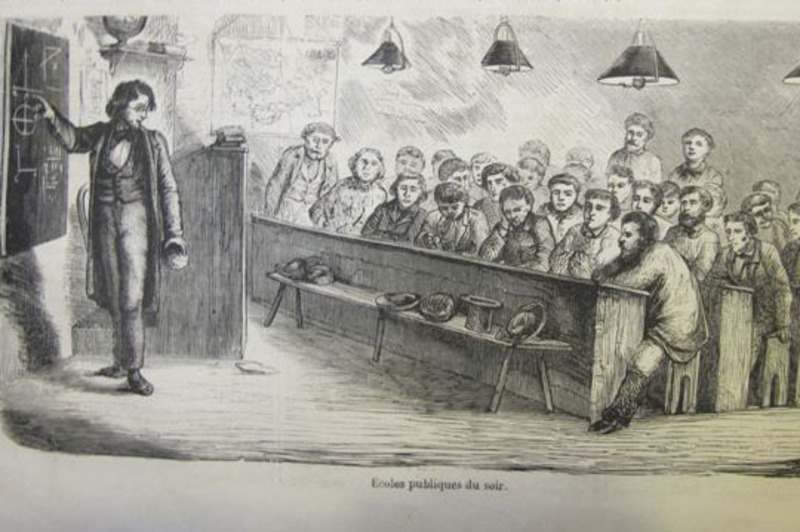
In terms of education, the situation in 1848 remained disastrous. Out of 300,000 conscripts, more than 112,000 could neither read nor write. Among the oldest, the proportion was even higher. Hence the decree of June 8, which instituted public evening readings in Paris, « intended to popularize knowledge of the masterpieces of our national literature ». These readings were to take place twice a week, « in various venues located, as far as possible, in the most populous districts of Paris ».
The Minister’s priority target is the peasants – two-thirds of the population – who have no association structures and are far from the towns and schools. It was they who had to be converted by reading, the key to education and emancipation, and brought into the schools:
« The teachers, now librarians, will read to them, aloud and intelligibly, and will be able to instruct them, interest them and (…) enthuse them about the political life of the country. Teachers, according to their availability, will provide general instruction in agricultural matters and readings in the schoolhouse or town hall, for civics and even literature. »
I. People’s Libraries
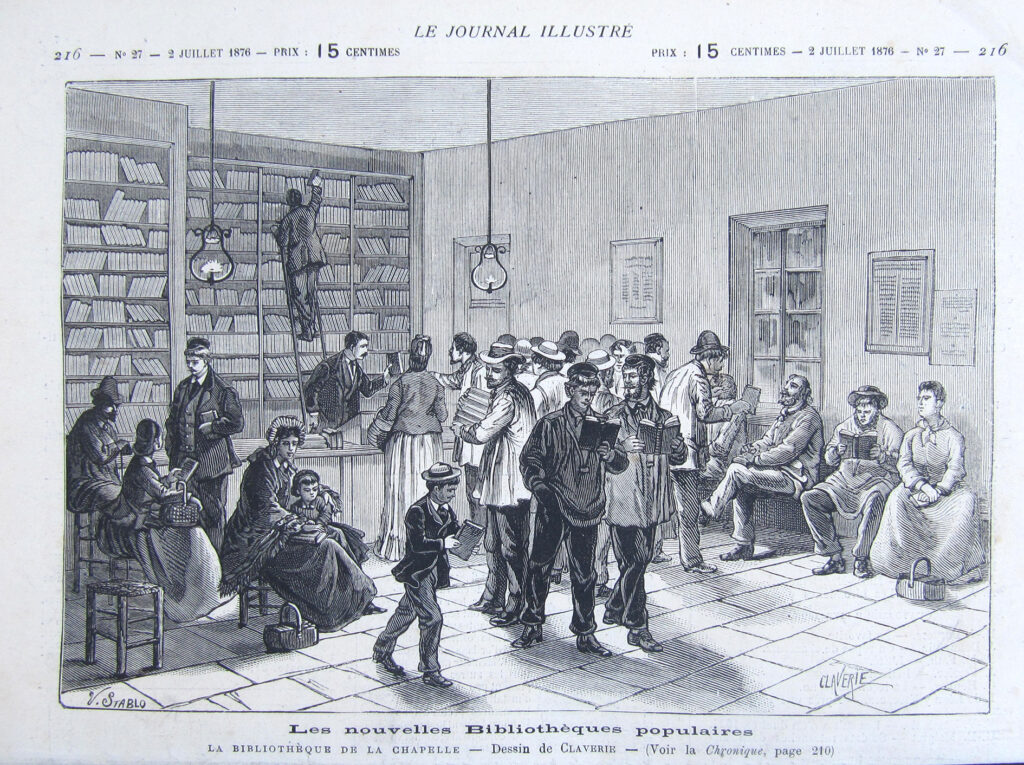
Based on the observation that « we lack reading books for the people as there are elsewhere », the Minister set up a vast public network of communal libraries of all sizes. He commissioned the publisher Paulin to assemble collections of the widest possible variety of books in every city district and rural canton, and make them available to the public free of charge. He also created a whole range of complementary establishments, such as special libraries near faculties, to make the most learned knowledge available to as many people as possible. Based on an idea by Jules Simon, he set out to create popular and rural libraries, which he renamed « circulating collections », with teachers who would « travel to small villages and bring to isolated children the instruction they could not find elsewhere ». The « missionary librarians » of these itinerant establishments would be « teacher-curators of the little people’s library », guiding the public, checking loans and reading on demand.
The creation of an official Service des lectures publiques du soir in the spring of 1848 should be seen in this bibliophile light. The aim was always the same: to give the best to the people. As Émile Deschanel explains:
« The Minister of the Republic wanted the sovereign people to have their own readers and teachers too. This service, as political as it is moral, is reminiscent of the sessions organized by philanthropists and Saint-Simonians, intended to replace cabarets and over-served balls. They would enable the worker (and later the peasant) tired « of daily toil to find a convenient asylum, a pleasure that would carry with it instruction, good advice and the familiarity of the great minds of our race ».
The aim was to popularize heritage texts and, if necessary, to comment on them in order to « nobly instruct listeners while amusing them », as the former Saint-Simonian Sainte-Beuve put it. The program of these readings must be varied to avoid fatigue. The great classics such as Corneille and Molière alternated with Michelet-style history, which had an obvious civic function, and comedies or songs such as those by Béranger.
The first Parisian screenings, attended by respectful workers and craftsmen, were a success « in an attentive silence where the slightest impressions were painted on faces ». The Minister noted amused reactions to the comedies, patriotic ones to the evocation of great battles such as Crécy, critical ones to the pompous style and bewildered ones to the Fables de la Fontaine. With this in mind, the Ministry envisaged the creation of a free Athénée based on the German and American models. The idea would be to bring together a handful of teachers in an amphitheater or former auditorium to offer free tuition, open to all and delivered by « pioneers in as yet unexplored fields » of science and technology.
J. Fine Arts, Hygiene and Gymnastics
In addition to « elements of national history and geography », he added French, public law and hygiene, not forgetting gymnastics to improve the health of the most disadvantaged. This was the adult version of what the new school and republican instruction would offer all French children. These courses should even bring art within everyone’s reach, through the promotion of heritage: « Is there a more powerful means of popular education? » he says, referring to art in general and the Beaux-Arts in particular.
In concrete terms, on March 29, the Minister and thirteen teachers founded the Association Philotechnique to provide workers with the professional and technical knowledge required for modern trades. The association agreed on courses in geometry, grammar, algebra, mechanics and drawing, to be given in the rooms of the Halle aux draps, and later at the École Turgot. Teachers from Parisian high schools are the first to be called on by the association to complete the training in history and law. The experiment began in early April, with 150 dyer-workers from the faubourg Saint-Marcel learning about science in the amphitheater of the pharmacy school. Vocational training soon spread to the provinces, including Orléans, before disappearing in the tumult of June.
Carnot wanted to go further, and envisaged « club-schools » based on the Scottish model of « Mechanic-institutions », i.e. lecture halls, libraries and permanent courses for workers in buildings adjoining factories. Keeping abreast of Braille’s work, he also took an interest in the deaf and blind, for whom he intended to multiply the number of specialized institutions under his ministry, rather than the Interior.
K. Citizen Concord
To crown this democratization, Carnot considered one of the Revolution’s most original methods: civic education through public festivals. At the end of February, he had already tested their civic virtues by taking part in the planting of a Tree of Liberty, a ritual practice in 1848, in the gardens of Saint-Nicolas in Paris. In this establishment specialized in the education of workers’ children, the ceremony was placed under the sign of the Three Colors. The clergyman blessed the tree, as is customary, in the presence of the mayor of the arrondissement. The Minister’s speech was edifying:
« The tree you are planting is as young as the Republic itself (…) It will spread its branches over you, just as the Republic will spread the benefits of popular education over France. (…) Good pupils become good citizens ».
The Minister of Education was also impressed by the « Fête de la Concorde » on March 21, between the Bastille and the Champ de Mars, with its parades, civic statuary, reviews of industrial works, hymns to the Republic and reformist enthusiasm. This civic pedagogy seemed effective to him, thanks to its symbolic representation of the regime and its « crowd of men obeying a common inspiration ».
18. Conclusion
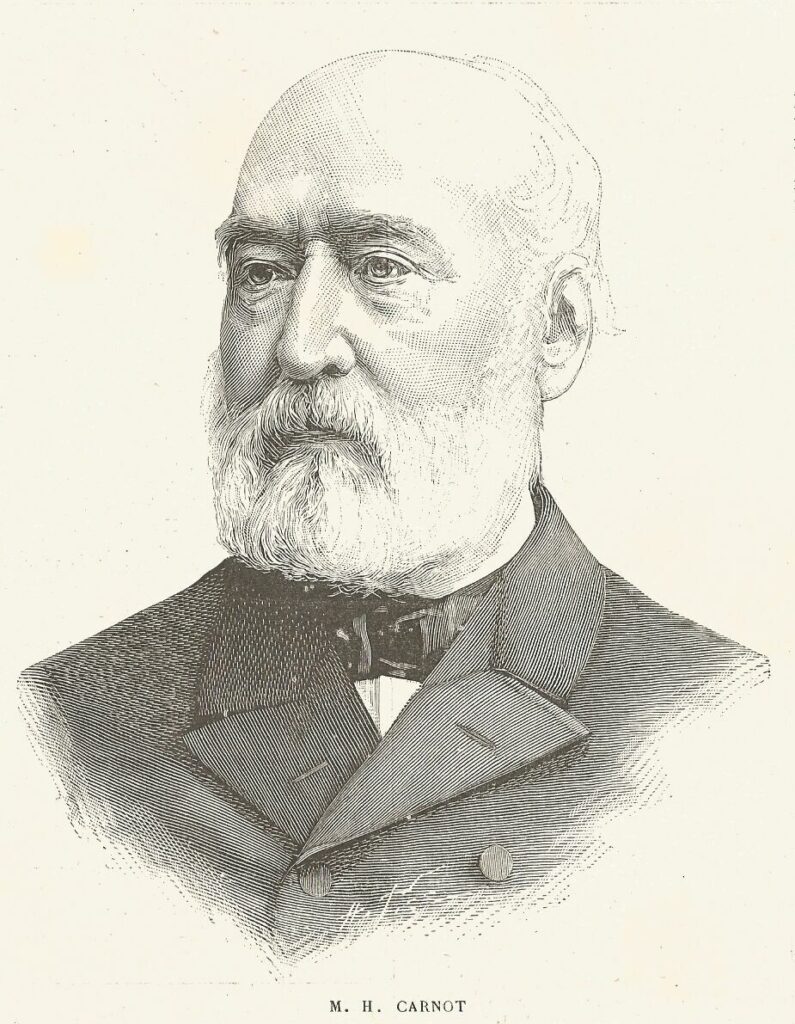
By way of conclusion, here’s the end of that of Remi Dalisson, whose magnificent biography of Hippolyte Carnot we highly recommend:
« His practice is his legislative texts on instruction, including school curricula, as varied as they are innovative, like those of his School of Administration or the ‘nursery school’. They make Carnot the undisputed precursor of Jules Ferry and the educational and civic project of the Third Republic. His laws and decrees were designed (…) to emancipate children and turn them into active, critical citizens in a peaceful, moderate and socially fluid democracy, under the aegis of restored teachers, symbols of the new times.
« His practice was his fights and commitments, first and foremost in the opposition, to which he belonged for a long time. His early writings against the death penalty, his participation in the events of 1830, his role in the 1848 Assembly, his fight for teachers, for whom he spent lavishly, and his voluntary exile are all worthy of note. (…)
« In a century crushed by the memory of two world wars, by the erasure of the Republic under Vichy and then by decolonization and the fall of Communism, forgetting 1848 and its social and educational hopes speaks volumes about our mental structures and our memory. This kind of amnesia, which does not prevent the often anachronistic sacralization of the republican corpus, has consigned Hippolyte Carnot and the whole of the 19th century to a sad oblivion. The period no longer evokes much of anything, apart from the occasional spotlight. It has even been sacrificed in teaching, as if only the 20th century were worthy of study.
« At a time when the French educational model is being called into question, when the republican school is doubting its missions, when secularism is also being discussed and when teachers feel abandoned, it is more necessary than ever to understand the roots of an educational system intimately linked to the republican regime. To this end, at the dawn of the 21st century, a reappraisal of the life and work of Hippolyte Carnot, a staunch defender of freedom, schools, Clio and the Republic, can lay the foundations for renewed, civic-minded reflection on the school system.«
19. Appendix: list of works by Hippolyte Carnot
- Gunima, an 18th-century African short story (Paris, Barba, 1824).
- Le Gymnase, a collection of morals and literature (Paris, Balzac, 1828).
- Doctrine de Saint-Simon (Brussels, Hauman, 1831).
- Mémoires de Grégoire, Évêque constitutionnel de Blois (Paris, Dupont, 6 vols., 1837-1845).
- Quelques réflexions sur la domesticité (Paris, Henry, 1838).
- Rapport sur la législation qui règle dans quelques états d’Allemagne les conditions de travail des jeunes ouvriers (Paris, Imp. Royale, 1840).
- Mémoires de Barère de Vieuzac (avec David d’Angers) (Paris, Labitte, 4 volumes, 1842-1844).
- L’Allemagne avant l’invasion française (Fragments*, Paris, Revue indépendante, 1842).
- L’Allemagne pendant la Révolution (Fragments*, Paris, Revue indépendante, 1843).
- Les Esclaves noirs (Paris, Magasin pittoresque, 1844).
- De l’esclavage colonial (Paris, Revue indépendante, 1845).
- Les Radicaux et la Charte, (Paris, Pagnerre, 1847).
- Le Ministère de l’Instruction Publique et des Cultes, 24 février-5 juillet 1848 (Paris, Pagnerre, 1848).
- Éducation républicaine, (Paris, Prost, 2 vols., 1849).
- L’insurrection littéraire en Allemagne (Fragments*, Paris, Liberté de penser, 1848).
- Le Mémorial de 1848, (Paris, Revue indépendante, n.p. 1849).
- Doctrine saint simonienne (Paris, Librairie nouvelle, 1854).
- Mémoires sur Lazare Carnot par son fils (Paris, Pagnerre, 1861-63, reed. in 1893 and 1907, Hachette).
- Œuvres de Saint-Simon by Enfantin, preceded by two historical notes by H. Carnot (Paris, Dentu, 1865).
- La Révolution française, résumé historique (2 vols., Paris, Dubuisson et Pagnerre, 1867).
- L’Instruction populaire en France (Paris, Degorce-Cadot, 1869).
- Trois discours sur l’instruction publique, (Paris, Degorce-Cadot, 1869).
- Cours de l’association philotechnique pour l’instruction gratuite des adultes (Paris, Parent, 1872).
- Ce que serait un nouvel Empire (Paris, Société du patriote, Bibliothèque utile, 1874).
- Lazare Hoche, général républicain (Paris, Société du patriote, Bibliothèque utile, 1874).
- D’une École d’Administration (Versailles, Aubert, 1878);
- Henri Grégoire, évêque républicain (Paris, Libraire des publications populaires, 1882).
- La Révolution française (Paris, Boulanger, 1888).
- Les premiers échos de la Révolution française au-delà du Rhin (Paris, Picard, 1888).
20. Short list of books and articles consulted
- Rémi Dalisson, Hippolyte Carnot, la liberté, l’école et la République, CNRS Editions, Paris 2011.
- Paul Carnot, Hippolyte Carnot et le ministère de l’Instruction publique de la IIe République, PUF, Paris, 1948.
- Jacques Cheminade, Lazare Carnot, l’organisateur de la victoire.
- Jacques Cheminade, L’exemplarité de l’oeuvre d’Henri Grégoire et de Lazare Carnot, 2005.
- Jacques Cheminade, Dino di Paoli and Claude Albert, L’Ecole polytechnique et la science de l’éducation républicaine, Campaigner publications, 1980.
- Website: Le temps des instituteurs.
- Karel Vereycken, The statue of Gutenberg in Strasbourg, the republican fight of David d’Angers.
- José Manuel Menudo, Une apologie des physiocrates par Condorcet, Dixhuitième siècle N° 46, pp 657 to 672.
- Condorcet, De l’influence de la révolution d’Amérique sur l’Europe (excerpts).
- Manuel Albertone, Condorcet, Jefferson and America.
- Dorette Huggins, John Adams and his reflections on Condorcet.
- E. -T. Hamy, Correspondance d’Alexandre de Humboldt avec François Arago, 1907, Paris.
The republican struggle of David d’Angers and the statue of Gutenberg in Strasbourg

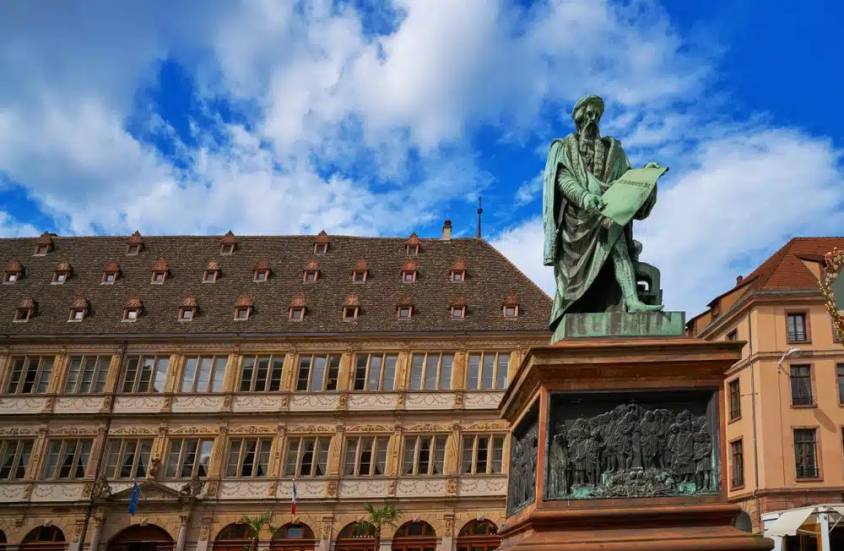
In the heart of downtown Strasbourg, a stone’s throw from the cathedral and with its back to the 1585 Chamber of Commerce, stands the beautiful bronze statue of the German printer Johannes Gutenberg, holding a barely-printed page from his Bible, which reads: « And there was light » (NOTE 1).
Evoking the emancipation of peoples thanks to the spread of knowledge through the development of printing, the statue, erected in 1840, came at a time when supporters of the Republic were up in arms against the press censorship imposed by Louis-Philippe under the July Monarchy.
Strasbourg, Mainz and China
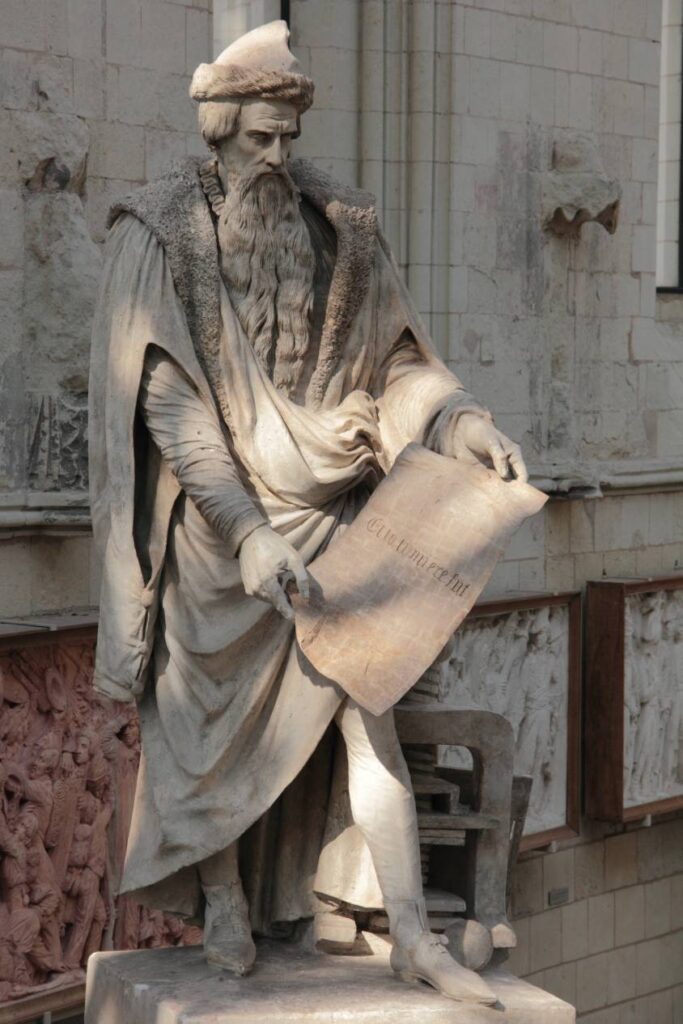
Born around 1400 in Mainz, Johannes Gutenberg, with money lent to him by the merchant and banker Johann Fust, carried out his first experiments with movable metal type in Strasbourg between 1434 and 1445, before perfecting his process in Mainz, notably by printing his famous 42-line Bible from 1452.
On his death (in Mainz) in 1468, Gutenberg bequeathed his process to humanity, enabling printing to take off in Europe. Chroniclers also mention the work of Laurens Janszoon Coster in Harlem, and the Italian printer Panfilo Castaldi, who is said to have brought Chinese know-how to Europe. It should be noted that the « civilized » world of the time refused to acknowledge that printing had originated in Asia with the famous « movable type » (made of porcelain and metal) developed several centuries earlier in China and Korea (NOTE 2).
In Europe, Mainz and Strasbourg vie for pride of place. On August 14, 1837, to celebrate the 400th anniversary of the « invention » of printing, Mainz inaugurated its statue of Gutenberg, erected by sculptor Bertel Thorvaldsenalors, while in Strasbourg, a local committee had already commissioned sculptor David d’Angers to create a similar monument in 1835.
This little-known sculptor was both a great sculptor and close friend of Victor Hugo, and a fervent republican in personal contact with the finest humanist elite of his time in France, Germany and the United States. He was also a tireless campaigner for the abolition of the slave trade and slavery.
The sculptor’s life
French sculptor Pierre-Jean David, known as « David d’Angers » (1788-1856) was the son of master sculptor Pierre Louis David. Pierre-Jean was influenced by the republican spirit of his father, who trained him in sculpture from an early age. At the age of twelve, his father enrolled him in the drawing class at the École Centrale de Nantes. In Paris, he was commissioned to create the ornamentation for the Arc de Triomphe du Carrousel and the south facade of the Louvre Palace. Finally, he entered the Beaux-arts.
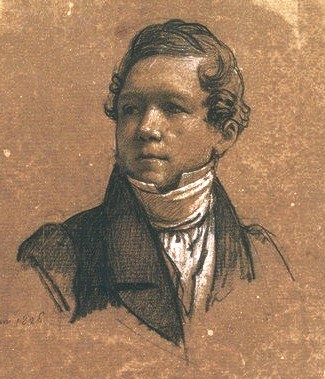
David d’Angers possessed a keen sense of interpretation of the human figure and an ability to penetrate the secrets of his models. He excelled in portraiture, whether in bust or medallion form. He is the author of at least sixty-eight statues and statuettes, some fifty bas-reliefs, a hundred busts and over five hundred medallions. Victor Hugo told his friend David: « This is the bronze coin by which you pay your toll to posterity. »
He traveled all over Europe, painting busts in Berlin, London, Dresden and Munich.
Around 1825, when he was commissioned to paint the funeral monument that the Nation was raising by public subscription in honor of General Foy, a tribune of the parliamentary opposition, he underwent an ideological and artistic transformation. He frequented the progressive intellectual circles of the « 1820 generation » and joined the international republican movement. He then turned his attention to the political and social problems of France and Europe. In later years, he remained faithful to his convictions, refusing, for example, the prestigious commission to design Napoleon’s tomb.
Artistic production
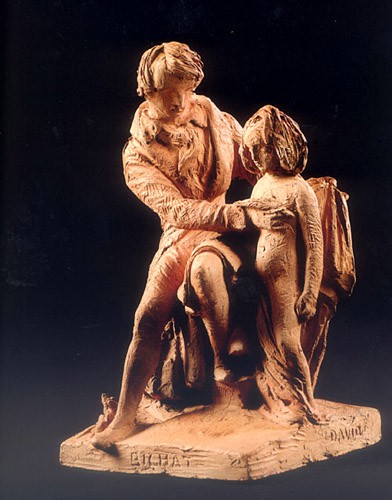
David’s art was thus influenced by a naturalism whose iconography and expression are in stark contrast to that of his academic colleagues and the dissident sculptors known as « romantics » at the time. For David, no mythological sensualism, obscure allegories or historical picturesqueness. On the contrary, sculpture, according to David, must generalize and transpose what the artist observes, so as to ensure the survival of ideas and destinies in a timeless posterity.
David adhered to this particular, limited conception of sculpture, adopting the Enlightenment view that the art of sculpture is « the lasting repository of the virtues of men », perpetuating the memory of the exploits of exceptional beings.
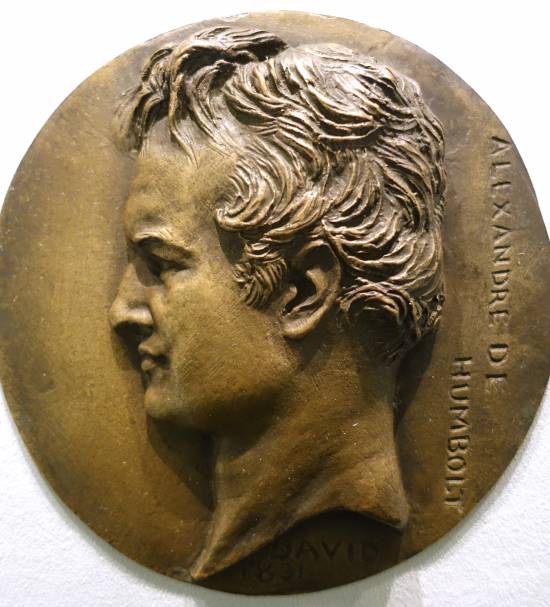
The somewhat austere image of « great men » prevailed, best known thanks to some 600 medallions depicting famous men and women from several countries, most of them contemporaries. Added to this are some one hundred busts, mostly of his friends, poets, writers, musicians, songwriters, scientists and politicians with whom he shared the republican ideal.
Among the most enlightened of his time were: Victor Hugo, Marquis de Lafayette, Wolfgang Goethe, Alfred de Vigny, Alphonse Lamartine, Pierre-Jean de Béranger, Alfred de Musset, François Arago, Alexander von Humboldt, Honoré de Balzac, Lady Morgan, James Fenimore Cooper, Armand Carrel, François Chateaubriand, Ennius Quirinus Visconti and Niccolo Paganini.
To magnify his models and visually render the qualities of each one’s genius, David d’Angers invented a mode of idealization no longer based on antique-style classicism, but on a grammar of forms derived from a new science, the phrenology of Doctor Gall, who believed that the cranial « humps » of an individual reflected his intellectual aptitudes and passions. For the sculptor, it was a matter of transcending the model’s physiognomy, so that the greatness of the soul radiated from his forehead.
In 1826, he was elected member of the Institut de France and, the same year, professor at the Beaux-Arts. In 1828, David d’Angers was the victim of his first unsolved assassination attempt. Wounded in the head, he was confined to bed for three months. However, in 1830, still loyal to republican ideas, he took part in the revolutionary days and fought on the barricades.
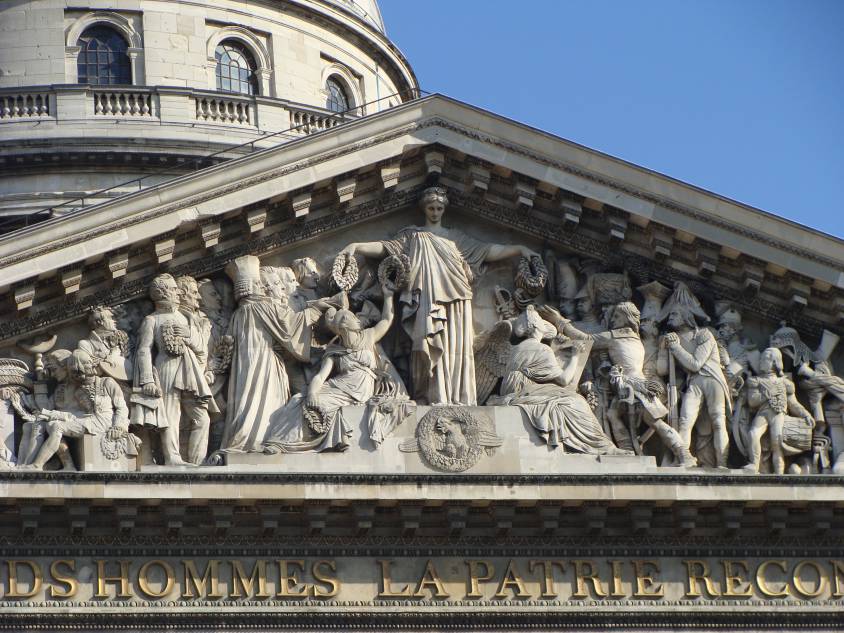
In 1830, David d’Angers found himself ideally placed to carry out the most significant political sculpture commission of the July monarchy and perhaps of 19th century France: the new decoration of the pediment of the church of Sainte-Geneviève, which had been converted into the Pantheon in July.
As a historiographer, he wanted to depict the civilians and men of war who built Republican France. In 1837, the execution of the figures he had chosen and arranged in a sketch that was first approved, then suspended, was bound to lead to conflict with the high clergy and the government. On the left, we see Bichat, Voltaire and Jean-Jacques Rousseau, David, Cuvier, Lafayette, Manuel, Carnot, Berthollet, Laplace, Malesherbes, Mirabeau, Monge and Fénelon. While the government tried to have Lafayette’s effigy removed, which David d’Angers stubbornly refused, with the support of the liberal press, the pediment was unveiled without official ceremony in September 1837, without the presence of the artist, who had not been invited.
Entering politics
During the 1848 Revolution, he was appointed mayor of the 11th arrondissement of Paris, entered the National Constituent Assembly and then the National Legislative Assembly, where he voted with the Montagne (revolutionary left). He defended the existence of the Ecole des Beaux-arts and the Académie de France in Rome. He opposed the destruction of the Chapelle Expiatoire and the removal of two statues from the Arc de Triomphe (Resistance and Peace by sculptor Antoine Etex).
He also voted against the prosecution of Louis Blanc (1811-1882) (another republican statesman and intellectual condemned to exile), against the credits for Napoleon III’s Roman expedition, for the abolition of the death penalty, for the right to work, and for a general amnesty.
Exile

He was not re-elected deputy in 1849 and withdrew from political life. In 1851, with the advent of Napoleon III, David d’Angers was arrested and also sentenced to exile. He chose Belgium, then traveled to Greece (his old project). He wanted to revisit his Greek Maiden on the tomb of the Greek republican patriot Markos Botzaris (1788-1823), which he found mutilated and abandoned (he had it repatriated to France and restored).
Disappointed by Greece, he returned to France in 1852. With the help of his friend de Béranger, he was allowed to stay in Paris, where he resumed his work. In September 1855, he suffered a stroke which forced him to cease his activities. He died in January 1856.
Friendships with Lafayette, Abbé Grégoire and Pierre-Jean de Béranger
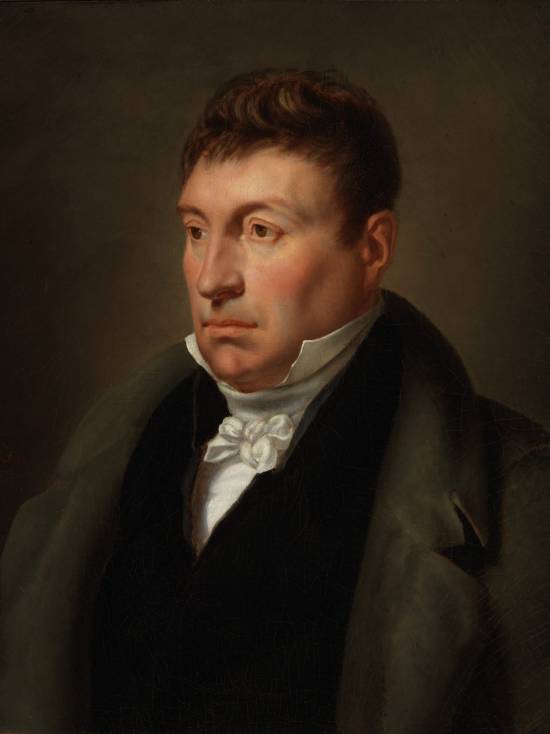
David d’Angers was a real link between 18th and 19th century republicans, and a living bridge between those of Europe and America.
Born in 1788, he had the good fortune to associate at an early age with some of the great revolutionary figures of the time, before becoming personally involved in the revolutions of 1830 and 1848.
Towards the end of the 1820s, David attended the Tuesday salon meetings of Madame de Lafayette, wife of Gilbert du Motier, Marquis de La Fayette (1757-1834).
While General Lafayette stood upright like « a venerable oak », this salon, notes the sculptor,
« has a clear-cut physiognomy, » he writes. The men talk about serious matters, especially politics, and even the young men look serious: there’s something decided, energetic and courageous in their eyes and in their posture (…) All the ladies and also the demoiselles look calm and thoughtful; they look as if they’ve come to see or attend important deliberations, rather than to be seen. »
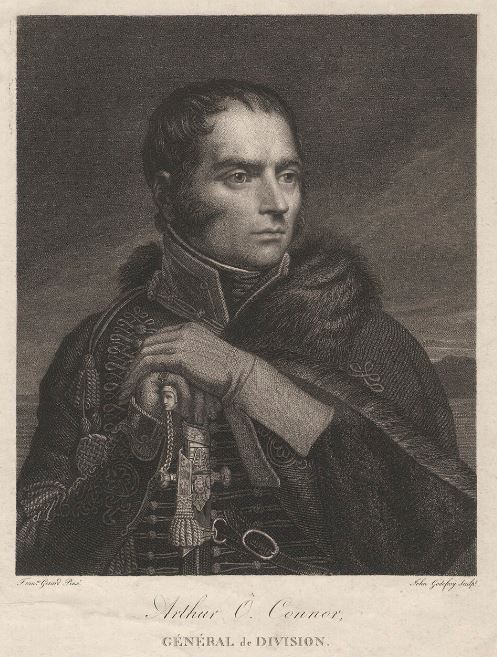
David met Lafayette’s comrade-in-arms, General Arthur O’Connor (1763-1852), a former Irish republican MP of the United Irishmen who had joined Lafayette’s volunteer General Staff in 1792.
Accused of stirring up trouble against the British Empire and in contact with General Lazare Hoche (1768-1797), O’Connor fled to France in 1796 and took part in the Irish Expedition. In 1807, O’Connor married the daughter of philosopher and mathematician Nicolas de Condorcet (1743-1794) and became a naturalized French citizen in 1818.
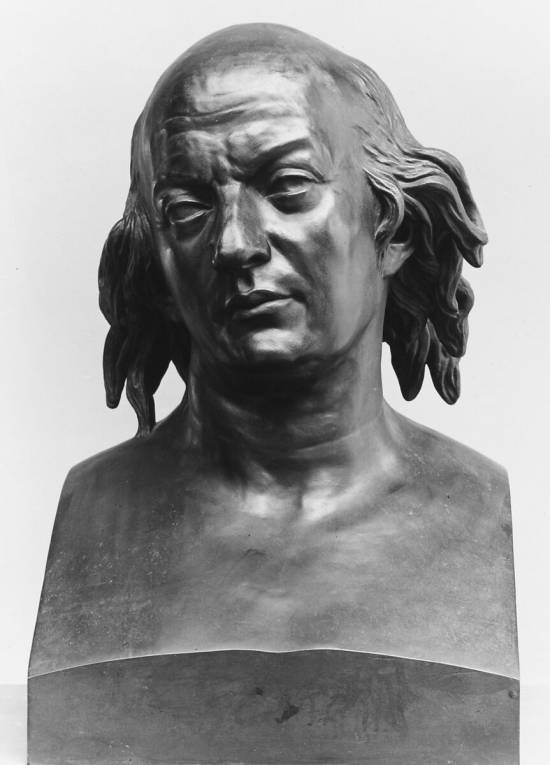
Lafayette and David d’Angers often got together with a small group of friends, a few « brothers » who were members of Masonic lodges: such as the chansonnier Pierre-Jean de Béranger, François Chateaubriand, Benjamin Constant, Alexandre Dumas (who corresponded with Edgar Allan Poe), Alphonse Lamartine, Henri Beyle dit Stendhal and the painters François Gérard and Horace Vernet.
In these same circles, David also became acquainted with Henri (Abbé) Grégoire (1750-1831), and the issue of the abolition of slavery, which Grégoire had pushed through on February 4, 1794, was often raised. In their exchanges, Lafayette liked to recall the words of his youthful friend Nicolas de Condorcet:
« Slavery is a horrible barbarism, if we can only eat sugar at this price, we must know how to renounce a commodity stained with the blood of our brothers. »
For Abbé Gregoire, the problem went much deeper:
« As long as men are thirsty for blood, or rather, as long as most governments have no morals, as long as politics is the art of deceit, as long as people, unaware of their true interests, attach silly importance to the job of spadassin, and will allow themselves to be led blindly to the slaughter with sheep-like resignation, almost always to serve as a pedestal for vanity, almost never to avenge the rights of humanity, and to take a step towards happiness and virtue, the most flourishing nation will be the one that has the greatest facility for slitting the throats of others. »
(Essay on the physical, moral and political regeneration of the Jews)
Napoleon and slavery
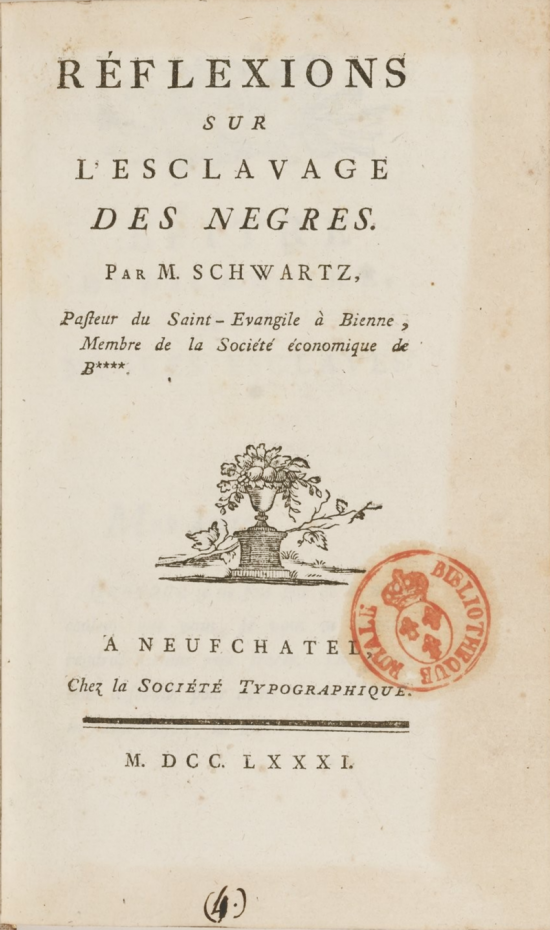
The first abolition of slavery was, alas, short-lived. In 1802, Napoleon Bonaparte, short of the money needed to finance his wars, reintroduced slavery, and nine days later excluded colored officers from the French army.
Finally, he outlawed marriages between « fiancés whose skin color is different ». David d’Angers remained very sensitive to this issue, having as a comrade a very young writer, Alexandre Dumas, whose father had been born a slave in Haiti.
As early as 1781, under the pseudonym Schwarz (black in German), Condorcet had published a manifesto advocating the gradual disappearance of slavery over a period of 60 to 70 years, a view quickly shared by Lafayette. A fervent supporter of the abolitionist cause, Condorcet condemned slavery as a crime, but also denounced its economic uselessness: slave labor, with its low productivity, was an obstacle to the establishment of a market economy.
And even before the signing of the peace treaty between France and the United States, Lafayette wrote to his friend George Washington on February 3, 1783, proposing to join him in setting in motion a process of gradual emancipation of the slaves. He suggested a plan that would « frankly become beneficial to the black portion of mankind ».
The idea was to buy a small state in which to experiment with freeing slaves and putting them to work as farmers. Such an example, he explained, « could become a school and thus a general practice ». (NOTE 3)
Washington replied that he personally would have liked to support such a step, but that the American Congress (already) was totally hostile.
From the Society of Black Friends to the French Society for the Abolition of Slavery
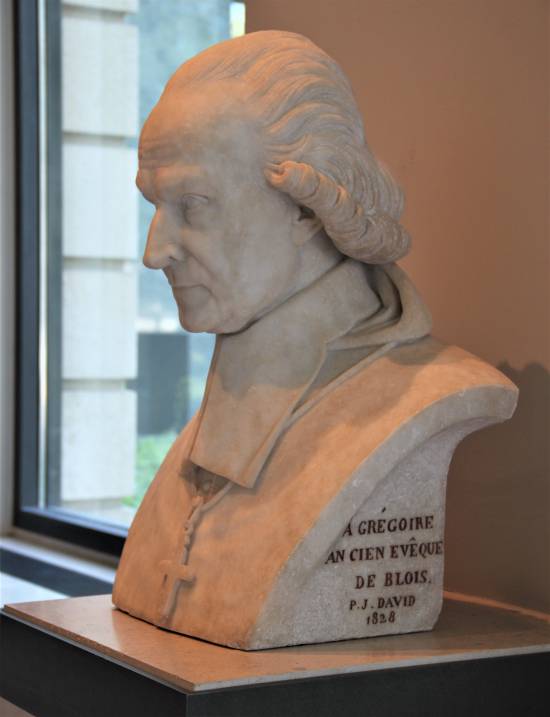
In Paris, on February 19, 1788, Abbé Grégoire and Jacques Pierre Brissot (1754-1793) founded « La Société des amis des Noirs », whose rules were drawn up by Condorcet, and of which the Lafayette couple were also members.
The society’s aim was the equality of free whites and blacks in the colonies, the immediate prohibition of the black slave trade and the gradual abolition of slavery; on the one hand, to maintain the economy of the French colonies, and on the other, in the belief that before blacks could achieve freedom, they had to be prepared for it, and therefore educated.
After the virtual disappearance of the « Amis des Noirs », the offensive was renewed, with the founding in 1821 of the « Société de la Morale chrétienne », which in 1822 set up a « Comité pour l’abolition de la traite des Noirs », some of whose members went on to found the « Société française pour l’abolition de l’esclavage (SFAE) » in 1834.
Initially in favor of gradual abolition, the SFAE later favored immediate abolition. Prohibited from holding meetings, the SFAE decided to create abolitionist committees throughout the country to relay the desire to put an end to slavery, both locally and nationally.
Goethe and Schiller

In the summer of 1829, David d’Angers made his first trip to Germany and met Goethe (1749-1832), the poet and philosopher who had retired to Weimar. Several posing sessions enabled the sculptor to complete his portrait.
Writer and poet Victor Pavie (1808-1886), a friend of Victor Hugo and one of the founders of the « Cercles catholiques ouvriers » (Catholic Workers Circle), accompagnied him on the trip and recounts some of the pictoresques anecdotes of their travel in his « Goethe and David, memories of a voyage to Weimar » (1874).
In 1827, the French newspaper Globe published two letters recounting two visits to Goethe, in 1817 and 1825, by an anonymous « friend » (Victor Cousin), as well as a letter from Ampère on his return from the « Athens of Germany ». In these letters, the young scientist expressed his admiration, and gave numerous details that whetted the interest of his compatriots. During his stay in Weimar, Ampère added to his host’s knowledge of Romantic authors, particularly Mérimée, Vigny, Deschamps and Delphine Gay. Goethe already had a (positive) opinion of Victor Hugo, Lamartine and Casimir Delavigne, and of all they owed to Chateaubriand.
A subscriber to the Globe since its foundation in 1824, Goethe had at his disposal a marvellous instrument of French information. In any case, he had little left to learn about France when David and Pavie visited him in August 1829. On the strength of his unhappy experience with Walter Scott in London, David d’Angers had taken precautions this time, and had a number of letters of recommendation for the people of Weimar, as well as two letters of introduction to Goethe, signed by Abbé Grégoire and Victor Cousin. To show the illustrious writer what he could do, he had placed some of his finest medallions in a crate.
Once in Weimar, David d’Angers and Victor Pavie encountered great difficulties in their quest, especially as the recipients of the letters of recommendation were all absent. Stricken with despair and fearing failure, David blamed his young friend Victor Pavie:

« Yes, you jumped in with the optimism of a young man, without giving me time to think and get out of the way. It wasn’t as a coward or under the patronage of an adventurer, it was head-on and resolutely that we had to tackle the character. (…) You’re only as good as what you are, it’s a yes or no question. You know me, on my knees before genius, and imployable before power. Ah! court poets, great or small, everywhere the same!
(…) And with a leap from the chair where he had insensitively let himself fall: Where’s Schiller? I’d like to kiss him! His grave, where I will strike, will not remain sealed for me; I will take him there, and bring him back glorious. What does it matter? Have I seen Corneille, have I seen Racine? The bust I’m planning for him will look all the better for it; the flash of his genius will gleam on his forehead. I’ll make him as I love and admire him, not with the pinched nose that Dannecker (image below) gave him, but with nostrils swollen with patriotism and freedom.
Victor Pavie’s account reveals the republican fervor animating the sculptor who, faithful to the ideals of Abbé Grégoire, was already thinking about the great anti-slavery sculpture he planned to create:
« At that moment, the half-open window of our bedroom, yielding to the evening breeze, opened wide. The sky was superb; the Milky Way unfurled with such brilliance that one could have counted the stars. He (David) remained silent for some time, dazzled; then, with that suddenness of impression that incessantly renewed the realm of feelings and ideas around him:
‘What a work, what a masterpiece! How poor we are compared to this!Would all your geniuses in one, writers, artists, poets, ever reach this incomparable poem whose tasks are splendors? Yet God knows your insatiable pretensions; we flay you in praise… And light! Remember this (and his presentiments in this regard were nothing less than a chimera), that such a one as received a marble bust from me as a token of my admiration, will one day literally lose the memory of it. – No, there is nothing more noble and great in humanity than that which suffers. I still have in my head, or rather in my heart, this protest of the human conscience against the most execrable iniquity of our times, the slave trade: after ten years of silence and suffering, it must burst forth with the voice of brass. You can see the group from here: the garroted slave, his eye on the sky, protector and avenger of the weak; next to him, lying broken, his wife, in whose bosom a frail creature is sucking blood instead of milk; at their feet, detached from the negro’s broken collar, the crucifix, the Man-God who died for his brothers, black or white. Yes, the monument will be made of bronze, and when the wind blows, you will hear the chain beating, and the rings ringing' ».
Finally, Goethe met the two Frenchmen, and David d’Angers succeeded in making his bust of the German poet. Victor Pavie:
« Goethe bowed politely to us, spoke the French language with ease from the start, and made us sit down with that calm, resigned air that astonished me, as if it were a simple thing to find oneself standing at eighty, face to face with a third generation, to which he had passed on through the second, like a living tradition.
(…) David carried with him, as the saying goes, a sample of his skills.He presented the old man with a few of his lively profiles, so morally expressive, so nervously and intimately executed, part of a great whole that is becoming more complete with our age, and which reserves for the centuries to come the monumental physiognomy of the 19th century. Goethe took them in his hand, considered them mute, with scrupulous attention, as if to extract some hidden harmony, and let out a muffled, equivocal exclamation that I later recognized as a mark of genuine satisfaction.Then, by a more intelligible and flattering transition, of which he was perhaps unaware, walking to his library, he charmingly showed us a rich collection of medals from the Middle Ages, rare and precious relics of an art that could be said to have been lost, and of which our great sculptor David has nowadays been able to recover and re-immerse the secret.
(…) The bust project did not have to languish for long: the very next day, one of the apartments in the poet’s immense house was transformed into a workshop, and a shapeless mound lay on the parquet floor, awaiting the first breath of existence. As soon as it slowly shifted into a human form, Goethe’s hitherto calm and impassive figure moved with it. Gradually, as if a secret, sympathetic alliance had developed between portrait and model, as the one moved towards life, the other blossomed into confidence and abandonment: we soon came to those artist’s confidences, that confluence of poetry, where the ideas of the poet and the sculptor come together in a common mold. He would come and go, prowling around this growing mass, (to use a trivial comparison) with the anxious solicitude of a landowner building a house. He asked us many questions about France, whose progress he was following with a youthful and active curiosity; and frolicking at leisure about modern literature, he reviewed Chateaubriand, Lamartine, Nodier, Alfred de Vigny, Victor Hugo, whose manner he had seriously pondered in Cromwell.
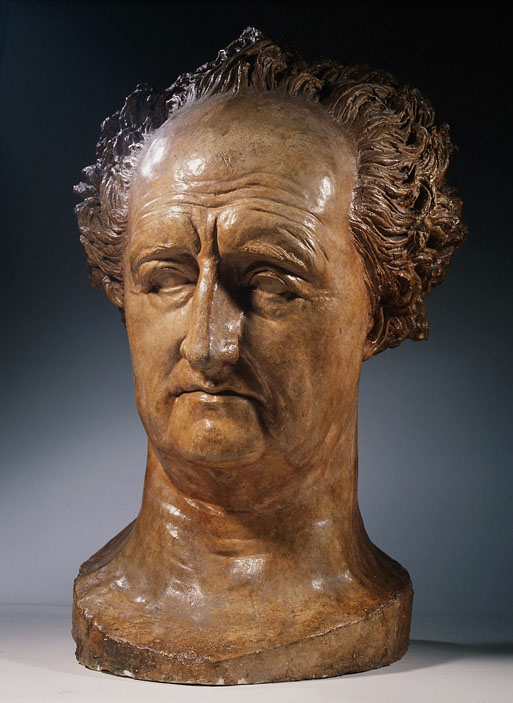

(…) David’s bust, writes Pavie, was as beautiful as Chateaubriand’s, Lamartine’s, Cooper’s, as any application of genius to genius, as the work of a chisel fit and powerful to reproduce one of those types created expressly by nature for the habitation of a great thought. Of all the likenesses attempted, with greater or lesser success, in all the ages of this long glory, from his youth of twenty to Rauch’s bust, the last and best understood of all, it is no prevention to say that David’s is the best, or, to put it even more bluntly, the only realization of that ideal likeness which is not the thing, but is more than the thing, nature taken within and turned inside out, the outward manifestation of a divine intelligence passed into human bark. And there are few occasions like this one, when colossal execution seems no more than a powerless indication of real effect. An immense forehead, on which rises, like clouds, a thick tuft of silver hair; a downward gaze, hollow and motionless, a look of Olympian Jupiter; a nose of broad proportion and antique style, in the line of the forehead ; then that singular mouth we were talking about earlier, with the lower lip a little forward, that mouth, all examination, questioning and finesse, completing the top with the bottom, genius with reason; with no other pedestal than its muscular neck, this head leans as if veiled, towards the earth:it’s the hour when the setting genius lowers his gaze to this world, which he still lights with a farewell ray. Such is David’s crude description of Goethe’s statue.- What a pity that in his bust of Schiller, so famous and so praised, the sculptor Dannecker prepared such a miserable counterpart!
When Goethe received his bust, he warmly thanked David for the exchange of letters, books and medallions… but made no mention of the bust ! For one simple reason: he didn’t recognize himself at all in the work, which he didn’t even keep at home… The German poet was depicted with an oversized forehead, to reflect his great intelligence. And his tousled hair symbolized the torments of his soul…
David d’Angers and Hippolyte Carnot

Among the founders of the SFAE (see earlier chapter on Abbé Grégoire) was Hippolyte Carnot (1801-1888), younger brother of Nicolas Sadi Carnot (1796-1832), pioneer of thermodynamics and son of « the organizer of victory », the military and scientific genius Lazare Carnot (1753-1823), whose work and struggle he recounted in his 1869 biography Mémoires sur Lazare Carnot 1753-1823 by his son Hippolyte.
In 1888, with the title Henri Grégoire, évêque (bishop) républicain, Hippolyte published the Mémoires of Grégoire the defender of all the oppressed of the time (negroes and Jews alike), a great friend of his father’s who had retained this friendship.
For the former bishop of Blois, « we must enlighten the ignorance that does not know and the poverty that does not have the means to know. »
Grégoire had been one of the Convention’s great « educators », and it was on his report that the Conservatoire des Arts-et-Métiers was founded on September 29, 1794, notably for the instruction of craftsmen. Grégoire also contributed to the creation of the Bureau des Longitudes on June 25, 1795 and the Institut de France on October 25, 1795.
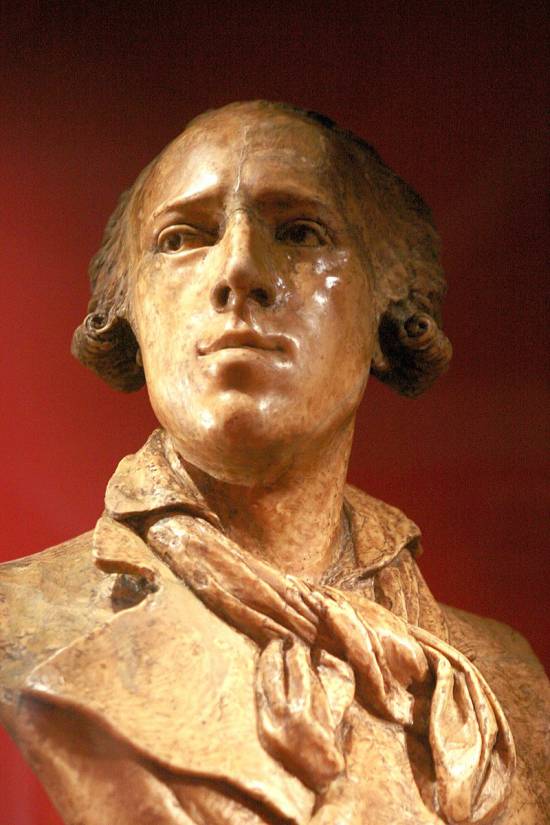
Hippolyte Carnot and David d’Angers, who were friends, co-authored the Memoirs of Bertrand Barère de Vieuzac (1755-1841), who acted as a sort of Minister of Information on the Comité de Salut Public, responsible for announcing the victories of the Republican armies to the Convention as soon as they arrived.
It was also Abbé Grégoire who, in 1826, commissioned David d’Angers, with the help of his friend Béranger, to bring some material and financial comfort to Rouget de Lisle (1860-1836), the legendary author of La Marseillaise, composed in Strasbourg when, in his old age, the composer was languishing in prison for debt.
Overcoming the sectarianism of their time, here are three fervent republicans full of compassion and gratitude for a musical genius who never wanted to renounce his royalist convictions, but whose patriotic creation would become the national anthem of the young French Republic.
Provisional Government
of the Second Republic
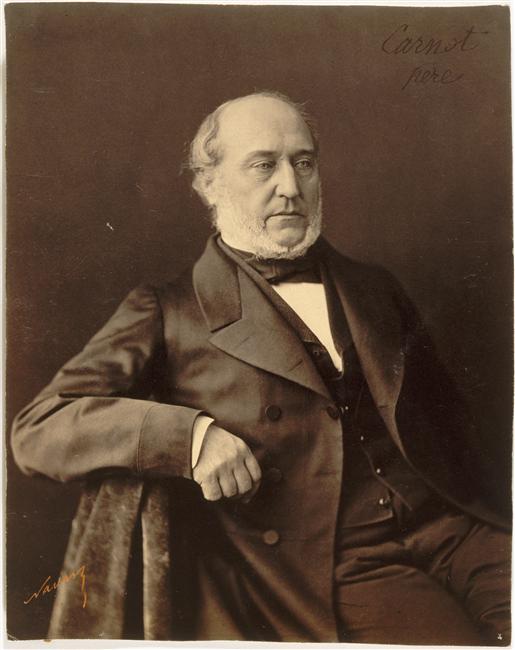
All these battles, initiatives and mobilizations culminated in 1848, when, for two months and 15 days (from February 24 to May 9), a handful of genuine republicans became part of the « provisional government » of the Second Republic.
In such a short space of time, so many good measures were taken or launched! Hippolyte Carnot was the Minister of Public Instruction, determined to create a high level of education for all, including women, following the models set by his father for Polytechnique and Grégoire for Arts et Métiers.
Article 13 of the 1848 Constitution « guarantees citizens (…) free primary education ».
On June 30, 1848, the Minister of Public Instruction, Lazare Hippolyte Carnot, submitted a bill to the Assembly that fully anticipated the Ferry laws, by providing for compulsory elementary education for both sexes, free and secular, while guaranteeing freedom of teaching. It also provided for three years’ free training at a teacher training college, in return for an obligation to teach for at least ten years, a system that was to remain in force for a long time. He proposed a clear improvement in their salaries. He also urged teachers « to teach a republican catechism ».
A member of the provisional government, the great astronomer and scientist François Arago (1886-1853) was Minister for the Colonies, having been appointed by Gaspard Monge to succeed him at the Ecole Polytechnique, where he taught projective geometry. His closest friend was none other than Alexander von Humboldt, friend of Johann Wolfgang Goethe and Friedrich Schiller.
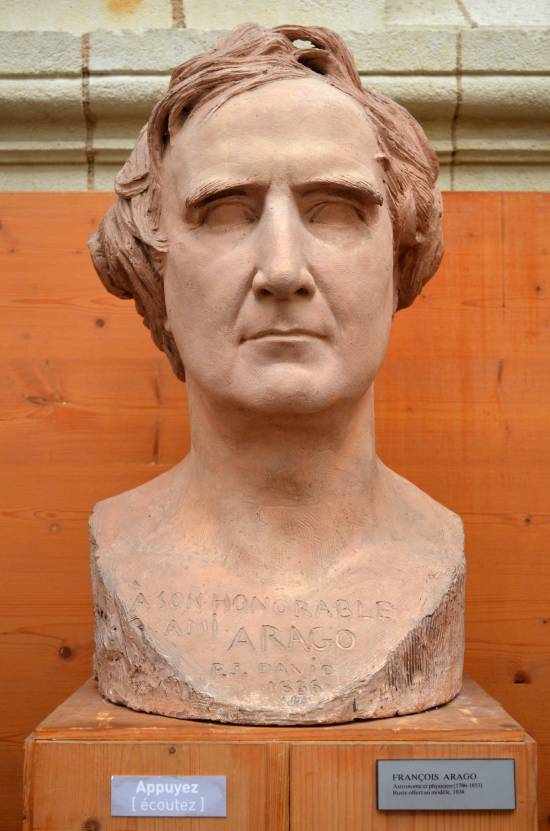
He was another abolitionist activist who spent much of his adult life in Paris. Humboldt was a member of the Société d’Arcueil, formed around the chemist Claude-Louis Berthollet, where he also met, besides François Arago, Jean-Baptiste Biot and Louis-Joseph Gay-Lussac, with whom Humboldt became friends. They published several scientific articles together.
Humboldt and Gay-Lussac conducted joint experiments on the composition of the atmosphere, terrestrial magnetism and light diffraction, research that would later bear fruit for the great Louis Pasteur.
Napoleon, who initially wanted to expel Humboldt, eventually tolerated his presence. The Paris Geographical Society, founded in 1821, chose him as its president.
Humboldt, Arago, Schoelcher, David d’Angers and Hugo
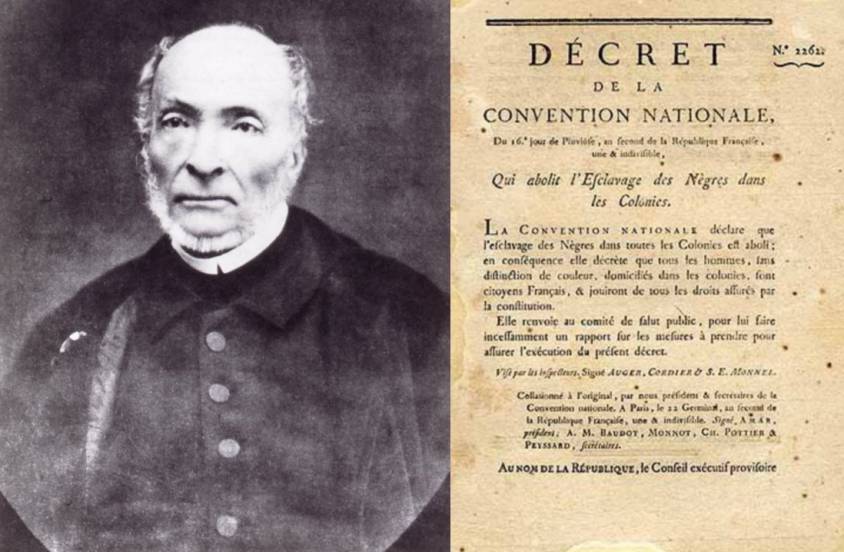
Humboldt made no secret of his republican ideals. His Political Essay on the Island of Cuba (1825) was a bombshell. Too hostile to slavery practices, the work was banned from publication in Spain. London went so far as to refuse him access to its Empire.
Even more deplorably, John S. Trasher, who published an English-language version in 1856, removed the chapter devoted to slaves and the slave trade altogether! Humboldt protested vigorously against this politically motivated mutilation. Trasher was a slaveholder, and his redacted translation was intended to counter the arguments of North American abolitionists, who subsequently published the retracted chapter in the New York Herald and the US Courrier. Victor Schoelcher and the decree abolishing slavery in the French colonies.
In France, under Arago, the Under-Secretary of State for the Navy and the Colonies was Victor Schoelcher. He didn’t need much convincing to convince the astronomer that all the planets were aligned for him to act.
A Freemason, Schoelcher was a brother of David d’Angers’s lodge, « Les amis de la Vérité » (The Friends of Truth), also known as the Cercle social, in reality « a mixture of revolutionary political club, Masonic lodge and literary salon ».
On March 4, a commission was set up to resolve the problem of slavery in the French colonies. It was chaired by Victor de Broglie, president of the SFAE, to which five of the commission’s twelve members belonged. Thanks to the efforts of François Arago, Henri Wallon and above all Victor Schoelcher, its work led to the abolition of slavery on April 27.
Victor Hugo the abolitionist
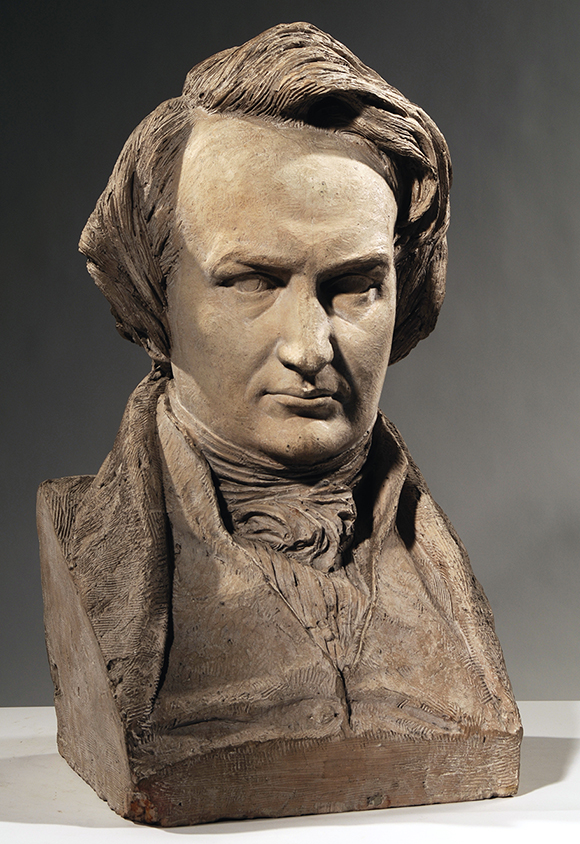
Victor Hugo was one of the advocates of the abolition of slavery in France, but also of equality between what were still referred to as « the races » in the 19th century. « The white republic and the black republic are sisters, just as the black man and the white man are brothers », Hugo asserted as early as 1859. For him, as all men were creations of God, brotherhood was the order of the day.
When Maria Chapman, an anti-slavery campaigner, wrote to Hugo on April 27, 1851, asking him to support the abolitionist cause, Hugo replied: « Slavery in the United States! » he exclaimed on May 12, « is there any more monstrous misinterpretation? » How could a republic with such a fine constitution preserve such a barbaric practice?
Eight years later, on December 2, 1859, he wrote an open letter to the United States of America, published by the free newspapers of Europe, in defense of the abolitionist John Brown, condemned to death.
Starting from the fact that « there are slaves in the Southern states, which indignifies, like the most monstrous counter-sense, the logical and pure conscience of the Northern states », he recounts Brown’s struggle, his trial and his announced execution, and concludes: « there is something more frightening than Cain killing Abel, it is Washington killing Spartacus ».
A journalist from Port-au-Prince, Exilien Heurtelou, thanked him on February 4, 1860. Hugo replied on March 31:
« Hauteville-House, March 31, 1860.
You are, sir, a noble sample of this black humanity so long oppressed and misunderstood.
From one end of the earth to the other, the same flame is in man; and blacks like you prove it. Was there more than one Adam? Naturalists can debate the question, but what is certain is that there is only one God.
Since there is only one Father, we are brothers.
It is for this truth that John Brown died; it is for this truth that I fight. You thank me for this, and I can’t tell you how much your beautiful words touch me.
There are neither whites nor blacks on earth, there are spirits; you are one of them. Before God, all souls are white.
I love your country, your race, your freedom, your revolution, your republic. Your magnificent, gentle island pleases free souls at this hour; it has just set a great example; it has broken despotism. It will help us break slavery. »
Also in 1860, the American Abolitionist Society, mobilized behind Lincoln, published a collection of speeches. The booklet opens with three texts by Hugo, followed by those by Carnot, Humboldt and Lafayette.
On May 18, 1879, Hugo agreed to preside over a commemoration of the abolition of slavery in the presence of Victor Schoelcher, principal author of the 1848 emancipation decree, who hailed Hugo as « the powerful defender of all the underprivileged, all the weak, all the oppressed of this world » and declared:
« The cause of the Negroes whom we support, and towards whom the Christian nations have so much to reproach, must have had your sympathy; we are grateful to you for attesting to it by your presence in our midst. »
A start for the better
Another measure taken by the provisional government of this short-lived Second Republic was the abolition of the death penalty in the political sphere, and the abolition of corporal punishment on March 12, as well as imprisonment for debt on March 19.
In the political sphere, freedom of the press and freedom of assembly were proclaimed on March 4. On March 5, the government instituted universal male suffrage, replacing the censal suffrage in force since 1815. At a stroke, the electorate grew from 250,000 to 9 million. This democratic measure placed the rural world, home to three quarters of the population, at the heart of political life for many decades to come. This mass of new voters, lacking any real civic training, saw in him a protector, and voted en masse for Napoleon III in 1851, 1860 and 1870.
Victor Hugo
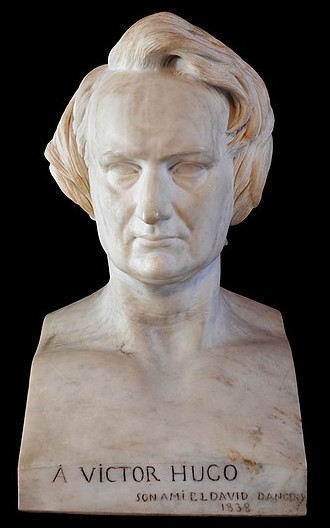
To return to David d’Angers, a lasting friendship united him with Victor Hugo (1802-1885). Recently married, Hugo and David would meet to draw. The poet and the sculptor enjoyed drawing together, making caricatures, painting landscapes or « architectures » that inspired them.
A shared ideal united them, and with the arrival of Napoleon III, both men went into political exile.
Out of friendship, David d’Angers made several busts of his friend. Hugo is shown wearing an elegant contemporary suit.
His broad forehead and slightly frowning eyebrows express the poet’s greatness, yet to come. Refraining from detailing the pupils, David lends this gaze an inward, pensive dimension that prompted Hugo to write: « my friend, you are sending me immortality. »
In 1842, David d’Angers produced another bust of Victor Hugo, crowned with laurel, where this time it was not Hugo the close friend who was evoked, but rather the genius and great man.
Finally, for Hugo’s funeral in 1885, the Republic of Haiti wished to show its gratitude to the poet by sending a delegation to represent it. Emmanuel-Edouard, a Haitian writer, presided over the delegation, and made the following statement at the Pantheon:
The Republic of Haiti has the right to speak on behalf of the black race; the black race, through me, thanks Victor Hugo for having loved and honored it so much, for having strengthened and comforted it.
The four bas-reliefs
of the Gutenberg statue
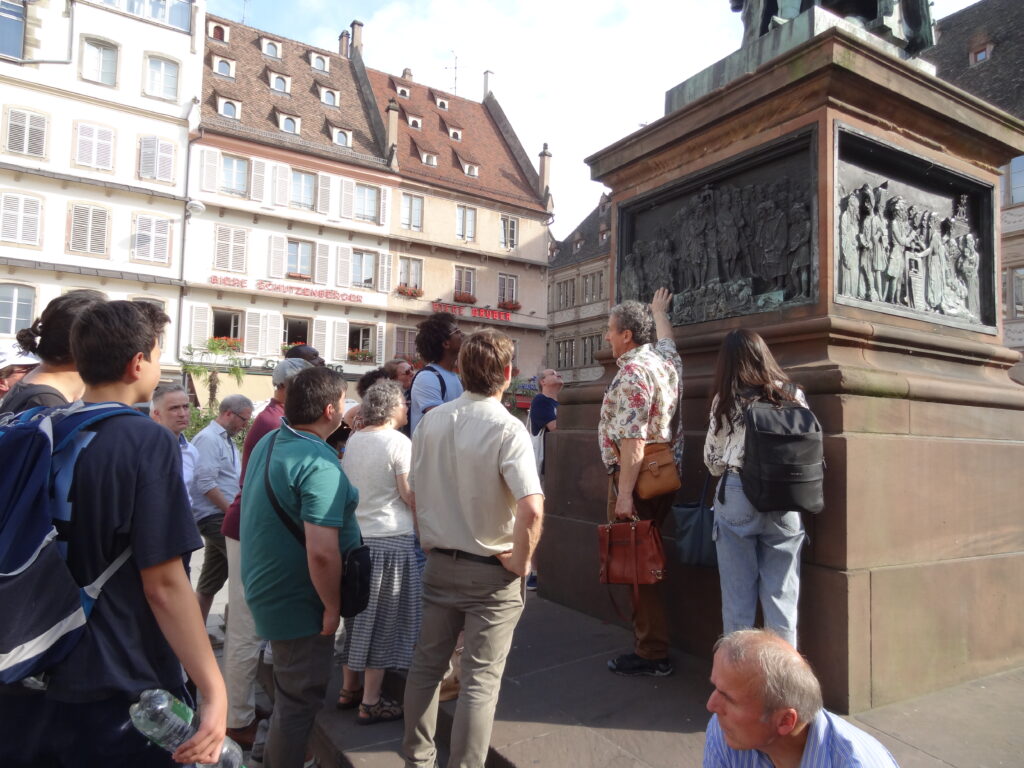
Once the reader has identified this « great arch » that runs through history, and the ideas and convictions that inspired David d’Angers, he will grasp the beautiful unity underlying the four bas-reliefs on the base of the statue commemorating Gutenberg in Strasbourg.
What stands out is the very optimistic idea that the human race, in all its great and magnificent diversity, is one and fraternal. Once freed from all forms of oppression (ignorance, slavery, etc.), they can live together in peace and harmony.
These bronze bas-reliefs were added in 1844. After bitter debate and contestation, they replaced the original 1840 painted plaster models affixed at the inauguration. They represent the benefits of printing in America, Africa, Asia and Europe. At the center of each relief is a printing press surrounded by characters identified by inscriptions, as well as schoolteachers, teachers and children.
To conclude, here’s an extract from the inauguration report describing the bas-reliefs. Without falling into wokism (for whom any idea of a « great man » is necessarily to be fought), let’s point out that it is written in the terms of the time and therefore open to discussion:

Plaster model for the base of the statue of Gutenberg, David d’Angers.
« Europe
is represented by a bas-relief featuring René Descartes in a meditative attitude, beneath Francis Bacon and Herman Boerhaave. On the left are William Shakespeare, Pierre Corneille, Molière and Racine. One row below, Voltaire, Buffon, Albrecht Dürer, John Milton and Cimarosa, Poussin, Calderone, Camoëns and Puget. On the right, Martin Luther, Wilhelm Gottfried Leibniz, Immanuel Kant, Copernicus, Wolfgang Goethe, Friedrich Schiller, Hegel, Richter, Klopstock. Rejected on the side are Linné and Ambroise Parée. Near the press, above the figure of Martin Luther, Erasmus of Rotterdam, Rousseau and Lessing. Below the tier, Volta, Galileo, Isaac Newton, James Watt, Denis Papin and Raphaël. A small group of children study, including one African and one Asian.«
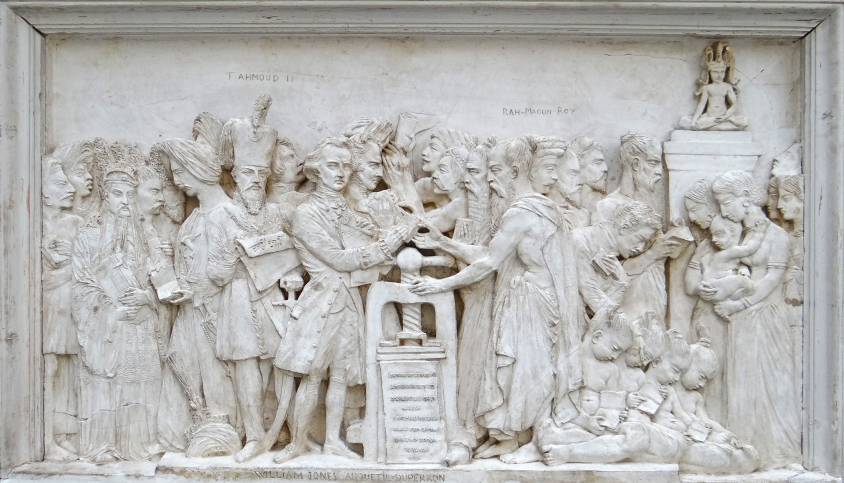
Plaster model for the base of the statue of Gutenberg, David d’Angers.
« Asia.
A printing press is shown again, with William Jones and Abraham Hyacinthe Anquetil-Duperron offering books to Brahmins, who give them manuscripts in return. Near Jones, Sultan Mahmoud II is reading the Monitor in modern clothes, his old turban lies at his feet, and nearby a Turk is reading a book. One step below, a Chinese emperor surrounded by a Persian and a Chinese man is reading the Book of Confucius. A European instructs children, while a group of Indian women stand by an idol and the Indian philosopher Rammonhun-Roy.«
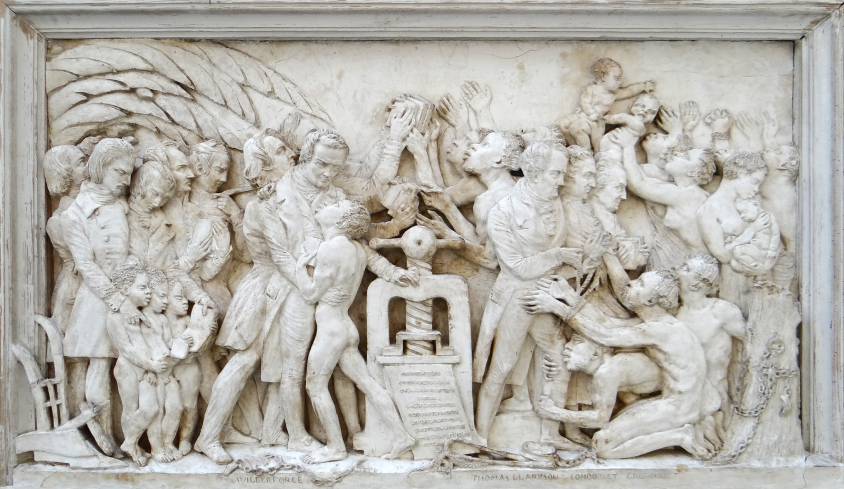
« Africa.
Leaning on a press, William Wilberforce hugs an African holding a book, while Europeans distribute books to other Africans and are busy teaching children. On the right, Thomas Clarkson can be seen breaking the shackles of a slave. Behind him, Abbé Grégoire helps a black man to his feet and holds his hand over his heart. A group of women raise their recovered children to the sky, which will now see only free men, while on the ground lie broken whips and irons. This is the end of slavery.«
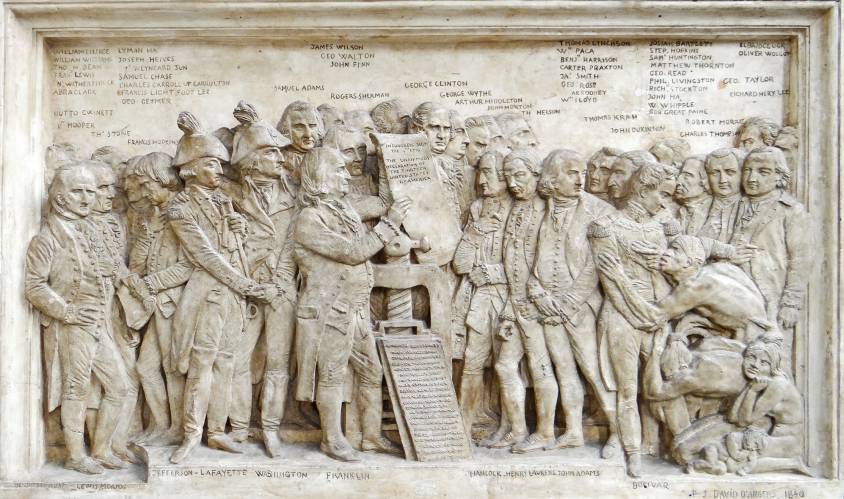
« America.
The Act of Independence of the United States, fresh from the press, is in the hands of Benjamin Franklin. Next to him stand Washington and Lafayette, who holds the sword given to him by his adopted homeland to his chest. Jefferson and all the signatories of the Act of Independence are assembled. On the right, Bolivar shakes hands with an Indian. »
America
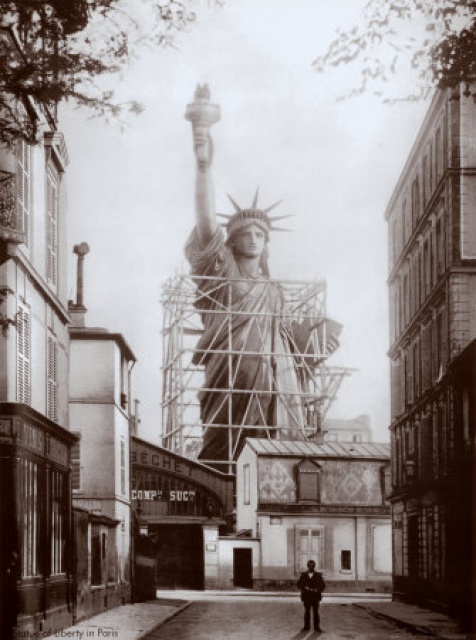
We can better understand the words spoken by Victor Hugo on November 29, 1884, shortly before his death, during his visit to the workshop of sculptor Frédéric-Auguste Bartholdi, where the poet was invited to admire the giant statue bearing the symbolic name « Liberty Enlightening the World », built with the help of Gustave Eiffel and ready to leave for the United States by ship. A gift from France to America, it will commemorate the active part played by Lafayette’s country in the Revolutionary War.
Initially, Hugo was most interested in American heroes and statesmen: William Penn, Benjamin Franklin, John Brown and Abraham Lincoln. Role models, according to Hugo, who enabled the people to progress. For the French politician who became a Republican in 1847, America was the example to follow. Even if he was very disappointed by the American position on the death penalty and slavery.
After 1830, the writer abandoned this somewhat idyllic vision of the New World and attacked the white « civilizers » who hunted down Indians:
« You think you civilize a world, when you inflame it with some foul fever [4], when you disturb its lakes, mirrors of a secret god, when you rape its virgin, the forest. When you drive out of the wood, out of the den, out of the shore, your naive and dark brother, the savage… And when throwing out this useless Adam, you populate the desert with a man more reptilian… Idolater of the dollar god, madman who palpitates, no longer for a sun, but for a nugget, who calls himself free and shows the appalled world the astonished slavery serving freedom!«
(NOTE 5)
Overcoming his fatigue, in front of the Statue of Liberty, Hugo improvised what he knew would be his last speech:
« This beautiful work tends towards what I have always loved, called: peace between America and France – France which is Europe – This pledge of peace will remain permanent. It was good that it was done!«
NOTES:
1. If the phrase appears in the Book of Genesis, it could also refer to Notre-Dame de Paris (1831) a novel by Victor Hugo, a great friend of the statue’s sculptor, David d’Angers. We know from a letter Hugo wrote in August 1832 that the poet brought David d’Angers the eighth edition of the book. The scene most directly embodied in the statue is the one in which the character of Frollo converses with two scholars (one being Louis XI in disguise) while pointing with one finger to a book and with the other to the cathedral, remarking: « Ceci tuera cela » (This will kill that), i.e. that one power (the printed press), democracy, will supplant the other (the Church), theocracy, a historical evolution Hugo thought ineluctable.
2. It was the encounter with Asia that brought countless technical know-how and scientific discoveries from the East to Europe, the best-known being the compass and gunpowder. Just as essential to printing as movable type was paper, the manufacture of which was perfected in China at the end of the Eastern Han Dynasty (around the year 185). As for printing, the oldest printed book we have to date is the Diamond Sutra, a Chinese Buddhist scripture dating from 868. Finally, it was in the mid-11th century, under the Song dynasty, that Bi Sheng (990-1051) invented movable type. Engraved in porcelain, a viscous clay ceramic, hardened in fire and assembled in resin, they revolutionized printing. As documented by the Gutenberg Museum in Mainz, it was the Korean Choe Yun-ui (1102-1162) who improved this technique in the 12th century by using metal (less fragile), a process later adopted by Gutenberg and his associates. The Anthology of Zen Teachings of Buddhist High Priests (1377), also known as the Jikji, was printed in Korea 78 years before the Gutenberg Bible, and is recognized as the world’s oldest book with movable metal type.
3. Etienne Taillemite, Lafayette and the abolition of slavery.
4. Victor Hugo undoubtedly wanted to rebound on the news that reached him from America. The Pacific Northwest smallpox epidemic of 1862, which was brought from San Francisco to Victoria, devastated the indigenous peoples of the Pacific Northwest coast, with a mortality rate of over 50% along the entire coast from Puget Sound to southeast Alaska. Some historians have described the epidemic as a deliberate genocide, as the colony of Vancouver Island and the colony of British Columbia could have prevented it, but chose not to, and in a way facilitated it.
5. Victor Hugo, La civilisation from Toute la lyre (1888 and 1893).
